- Submit News Tips
- Write for Us


100 Best Websites to Find Research Articles, Papers & Journals
In the vast landscape of digital information, access to credible academic resources is indispensable for the curious mind. Navigating through a myriad of websites to find scholarly journals, articles, and books can be a daunting task. To aid in this quest for knowledge, we’ve curated a list of the top 100 websites renowned for their repository of academic treasures . These platforms serve as indispensable tools for researchers, students, and enthusiasts seeking reputable and diverse scholarly materials. From comprehensive databases to user-friendly interfaces, each website stands as a testament to the democratization of education and the evolution of digital learning.

Join us on this expedition through the virtual libraries that serve as gateways to a world of intellectual richness and exploration.
1. Google Scholar

As a widely-used academic search engine, Google Scholar provides access to scholarly articles, theses, books, and conference papers across various disciplines. Its user-friendly interface allows researchers to explore a vast database of scholarly literature, offering citations, abstracts, and sometimes even full-text access. Its citation tracking feature enables scholars to follow research trends and connect with related publications. With its comprehensive coverage and indexing of academic sources, Google Scholar is an indispensable tool for academics, students, and researchers seeking reliable and diverse scholarly content.
2. ScienceDirect
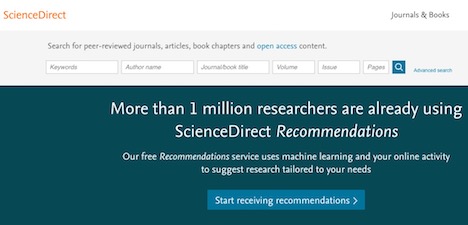
ScienceDirect is a comprehensive platform offering access to a vast collection of academic journals, articles, and books across various scientific disciplines. With a user-friendly interface, it provides researchers and students with a plethora of scholarly resources in fields like science, technology, medicine, and social sciences. ScienceDirect grants access to a multitude of peer-reviewed journals, research articles, book chapters, and reference works. Its advanced search functionalities and intuitive navigation streamline the process of locating relevant literature for academic pursuits.
3. ReaserchGate
As a prominent academic networking platform, ResearchGate fosters collaboration among researchers globally. Offering access to a vast repository of academic journals, articles, and books across disciplines, it serves as a hub for scholarly communication. Researchers can connect, share findings, and access a diverse range of publications, facilitating knowledge exchange and collaborative efforts in advancing scientific endeavors.
4. Springerlink
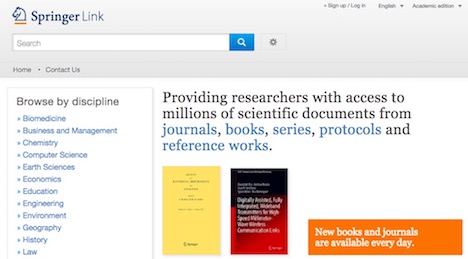
SpringerLink stands as a prominent platform for accessing academic journals, books, and reference works across disciplines such as science, technology, medicine, and the social sciences. Offering a vast collection of peer-reviewed content from renowned publishers, SpringerLink provides access to high-quality research articles, book chapters, and reference materials. Its user-friendly interface facilitates easy navigation and searchability, making it a valuable resource for scholars, researchers, and students seeking in-depth academic literature and cutting-edge research in various fields.
VET-Bib serves as a specialized repository for veterinary science-related literature, catering to professionals, researchers, and students in the field. This platform offers a curated collection of academic journals, articles, and books specific to veterinary medicine, animal health, and related disciplines. VET-Bib facilitates access to a diverse range of scholarly resources, including research papers, clinical studies, textbooks, and reports, contributing significantly to advancements in veterinary sciences.
6. Academia.edu
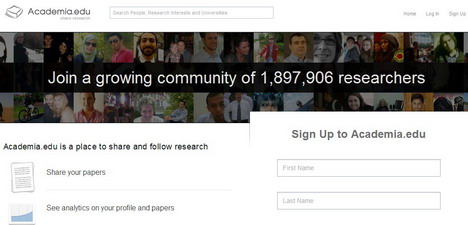
Academia.edu is a social networking platform designed for academics to share and access scholarly papers, articles, and research. It allows researchers to create profiles, upload their work, and connect with peers worldwide, fostering collaboration and knowledge exchange. Users can explore a wide range of academic disciplines, access papers, follow scholars, and track research interests. Academia.edu serves as a hub for disseminating research, accessing scholarly content, and networking within the academic community.
7. arXiv.org e-Print Archive
arXiv.org is a preprint repository primarily focused on physics, mathematics, computer science, quantitative biology, quantitative finance, and statistics. It hosts a vast collection of research papers, providing early access to cutting-edge findings before formal publication. Researchers worldwide contribute to arXiv, sharing their work and enabling the dissemination of crucial discoveries within these disciplines. Its open-access nature encourages collaboration, facilitates rapid dissemination of research, and serves as a vital resource for scholars and students alike.
8. Astrophysics Data System
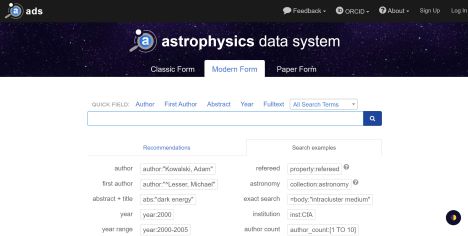
The Astrophysics Data System (ADS) stands as an authoritative digital library providing access to a wealth of literature in astrophysics, astronomy, and related sciences. ADS serves as a comprehensive platform offering academic journals, articles, conference proceedings, and data sets relevant to the field. Its sophisticated search tools enable researchers to explore astronomical literature, access preprints, and gather valuable resources for their scholarly inquiries.
9. Google Books
Google Books offers an extensive and diverse collection of digitized books, providing access to a wide range of academic literature across multiple disciplines. While not exclusively academic, Google Books encompasses a significant repository of scholarly works, allowing users to preview, purchase, or access full texts of books relevant to their research. Its search feature allows users to explore content, view excerpts, and locate academic publications, making it a valuable resource for scholars, researchers, and students.
10. ProQuest
An extensive digital library offering access to a vast array of scholarly journals, articles, and books across multiple disciplines. ProQuest’s user-friendly platform facilitates research, providing comprehensive resources for academics, researchers, and students worldwide. With diverse content, including historical archives, current publications, and multimedia resources, it’s a go-to destination for in-depth exploration and reliable sources.
11. Education Resources Information Center (ERIC)
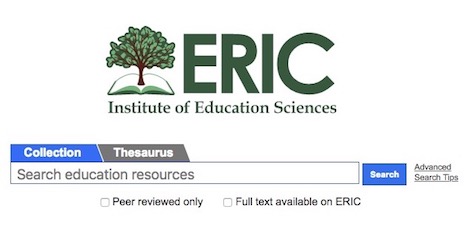
ERIC is a comprehensive platform offering an array of educational resources, research articles, and publications. It specializes in curating scholarly content related to education, spanning diverse topics from early childhood to higher education. ERIC acts as a centralized hub for educators, researchers, and policymakers, providing access to peer-reviewed articles, reports, and conference papers. With its extensive database, ERIC facilitates exploration and dissemination of knowledge, fostering advancements in educational practices and policies.
12. Microsoft Academic Search
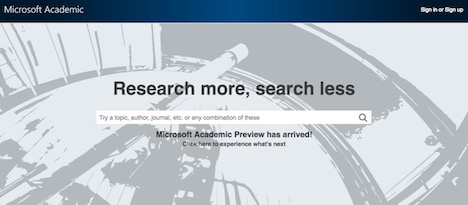
Microsoft Academic Search is a dynamic platform dedicated to facilitating academic exploration and research discovery. Leveraging advanced algorithms and vast data sets, it offers a user-friendly interface to access scholarly articles, publications, and citations across various disciplines. This tool provides in-depth search functionalities, citation analysis, and semantic understanding, empowering researchers to navigate through a plethora of academic resources. Microsoft Academic Search encourages collaboration, knowledge sharing, and innovative scholarly pursuits by offering a robust platform for academic exploration.
13. Oxford Academic Journals Search
Oxford Academic Journals Search is a prestigious repository hosting a wide spectrum of scholarly articles and publications across multiple disciplines. Renowned for its high-quality content and authoritative contributions, it serves as a gateway to scholarly excellence. This platform offers access to esteemed journals published by Oxford University Press, encompassing diverse fields such as humanities, social sciences, science, and medicine. With its rigorous peer-review process and rich historical archive, Oxford Academic Journals Search fosters academic inquiry, knowledge dissemination, and intellectual discourse.
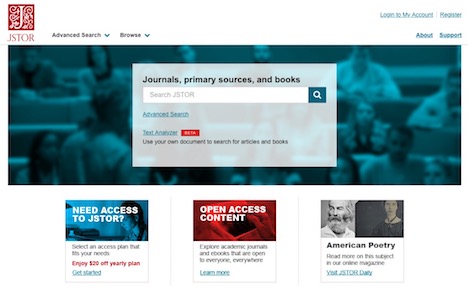
JSTOR is a revered digital library providing access to an extensive collection of academic journals, books, and primary sources. Catering to researchers, students, and scholars worldwide, JSTOR archives scholarly content across various disciplines, including arts, humanities, social sciences, and sciences. Known for its archival depth and user-friendly interface, JSTOR grants access to a wealth of peer-reviewed articles, books, and research materials. Its comprehensive database and interdisciplinary approach facilitate scholarly research, critical analysis, and the exploration of historical and contemporary academic literature. JSTOR remains a vital resource for academic pursuits and intellectual discovery.
15. Behavioral and Brain Sciences
Behavioral and Brain Sciences is a prestigious academic journal that publishes target articles and commentary on significant and controversial topics in psychology, neuroscience, cognitive science, and related fields. Recognized for its unique format, BBS publishes comprehensive articles accompanied by multiple commentaries from experts in the field, fostering in-depth discussions and debates on key issues. This journal serves as a platform for rigorous scientific discourse, shaping the direction of research and theory development in behavioral and brain sciences.
16. PubChem
Operated by the NCBI, PubChem stands as an extensive chemical database, offering insights into compound properties, structures, and biological activities. Its collection includes scientific articles, journals, and books relevant to chemistry, pharmacology, and life sciences. Researchers benefit from its comprehensive information on chemical compounds, aiding in drug discovery, bioinformatics, and chemical research.
PubMed serves as a comprehensive resource for accessing biomedical literature. With millions of articles from various fields like medicine, biology, and health sciences, it provides researchers, healthcare professionals, and students with a vast repository of peer-reviewed articles. Its user-friendly interface allows easy navigation through research articles, clinical studies, and reviews, making it an invaluable tool for staying updated on the latest advancements in healthcare and life sciences.
18. CiteSeerX
CiteSxeerX project is funded by the National Science Foundation, is a public integrated digital library, database, and search engine for scientific papers in chemistry. The goal of this project is to develop an intelligent search and database that provides easy access to relevant data for diverse community of users who need for chemical information.
19. Semantic Scholar
Semantic Scholar is an academic search engine that utilizes artificial intelligence methods to provide highly relevant results for journal articles. It is designed to quickly highlight the most important papers and identify the connections between them. It currently includes on computer science and biomedical publications.
20. Web of Science
Web of Science is an online subscription-based scientific citation indexing service that provides a comprehensive citation search. It gives access to multiple databases that reference cross-disciplinary research allowing in-depth exploration of specialized sub-fields within an academic or scientific discipline.
21. Analytical Abstracts
Analytical Abstracts is a literature updating service that keeps researchers and students informed of the latest developments in analytical science. It includes details of the most relevant literature presented as individual records that are easily searchable by analyte, matrix, technique and subject area.
22. Merck Index
The Merck Index is a revered compendium of chemical compounds, providing in-depth information on their properties, structures, and uses. Widely used by chemists, researchers, and students, it offers a wealth of data on chemicals, drugs, and biological substances. With over 11,000 monographs featuring precise details, including synthesis pathways and safety information, it remains an indispensable reference for understanding and researching chemical compounds and their applications.
23. MedlinePlus
MedlinePlus is an online information service created by the United States National Library of Medicine. The service provides curated consumer health information and brings together information from the National Library of Medicine, the National Institutes of Health, other U.S. government agencies, and health-related organizations.
24. Agricola
Agricola is a bibliographic database of citations to the agricultural literature created by the National Agricultural Library. The database indexes a wide variety of publications covering agriculture and its allied fields, including, animal and veterinary sciences, entomology, plant sciences, forestry, aquaculture, fisheries, and many more.
25. AGRIS: Agricultural Database
AGRIS is a global public domain database with more than 8 million structured bibliographical records on agricultural science and technology. The AGRIS Search system allows scientists, researchers to perform sophisticated searches using keywords, journal titles or names of countries, institutions, and authors.
26. WorldCat
WorldCat stands as a vast catalog of library collections worldwide, encompassing books, journals, multimedia materials, and more. It facilitates access to resources held in numerous libraries globally, allowing users to locate and borrow items beyond their local collection. Its extensive database aids researchers, scholars, and enthusiasts in discovering a broad range of academic resources, fostering collaborative research and access to diverse perspectives across various subjects and disciplines.
27. IOPscience
IOPscience serves as a leading platform for accessing scientific content in physics, engineering, and related disciplines. Hosting journals, conference proceedings, and magazines published by the Institute of Physics, it offers a trove of high-quality research articles, reviews, and cutting-edge studies. Researchers and academics benefit from its authoritative content, advanced search features, and access to vital information shaping the forefront of scientific exploration and technological advancements.
28. PLOS ONE
PLOS ONE stands as an open-access, peer-reviewed journal publishing multidisciplinary scientific research. It houses a vast repository of articles across various scientific disciplines, fostering accessibility and collaboration within the academic community. Known for its rigorous review process and commitment to transparency, PLOS ONE promotes diverse research findings and encourages innovation in scientific exploration.
A comprehensive abstract and citation database catering to scientific, technical, medical, and social sciences. Scopus offers access to an extensive collection of peer-reviewed literature, providing researchers and institutions with powerful tools for tracking, analyzing, and visualizing research trends and data. Its vast coverage and analytical features make it a vital resource in the academic community.
30. Advanced Technologies & Aerospace Database
The Advanced Technologies & Aerospace Database provides extensive coverage of advanced technology literature. It features over 26 million A&I records and more than 250 full-text titles that date back to 1962. Its topics cover aeronautics, communications, computer and IT, electronics, lasers, space sciences, telecommunications and many more.
31. Air University Library Index to Military Periodicals (AULIMP)
AULIMP specializes in curating military-centric literature, indexing journals, periodicals, and articles vital to military studies and defense. Catering to scholars, military personnel, and historians, it provides a wealth of resources covering military history, strategy, technology, and policy analysis, aiding in comprehensive research within the defense domain.
32. ACM Digital Library
Geared towards computing professionals, the ACM Digital Library hosts an extensive collection of journals, conference proceedings, and books in computer science and related fields. It offers a rich repository of cutting-edge research, enabling access to pivotal works and fostering innovation and advancement in the realm of technology and computing.
33. Project MUSE
Project MUSE offers a comprehensive digital collection of scholarly journals and books in humanities and social sciences. Recognized for its extensive coverage and user-friendly interface, it provides access to high-quality content from reputable publishers and institutions worldwide. With a focus on academic excellence, Project MUSE supports research, learning, and intellectual discovery.
34. Ulrich’s Periodicals Directory
Ulrich’s Periodicals Directory serves as an authoritative resource for information on academic journals, magazines, and other periodicals. It offers detailed bibliographic data, including publication details, peer-review status, and indexing information. Widely used by researchers, librarians, and institutions, Ulrich’s facilitates the identification and evaluation of publications, aiding in academic research and scholarly communication.
35. OAIster Database
OAIster functions as a global aggregator, collating digital resources from diverse libraries worldwide. With access to academic content spanning journals, theses, and books sourced from various repositories and institutions, it provides a comprehensive search platform across disciplines, aiding researchers in accessing a wide array of scholarly materials.
36. Beilstein Database
A renowned resource in organic chemistry, Beilstein Database aggregates exhaustive data on organic compounds, providing critical information on their properties, reactions, and synthesis methods. Researchers access a plethora of peer-reviewed articles, journals, and books, empowering scientific exploration and innovation in chemical research and development.
37. Mendeley
Mendeley, a reference manager and academic social network, empowers researchers to organize, annotate, and collaborate on research papers and articles. Its user-friendly platform enables citation management, document sharing, and networking among scholars globally. With integrated features for discovery and collaboration, Mendeley streamlines the research process and supports scholarly communication.
38. Chinese Social Science Citation Index
Chinese Social Sciences Citation Index (CSSCI) is an interdisciplinary citation index program in China. This citation database covers more than 500 Chinese academic journals of humanities and social sciences. Many Chinese universities and institutes use CSSCI as a basis for the evaluation of academic achievements and promotion.
39. Library of Congress
The Library of Congress offers an extensive collection of academic journals, articles, and books spanning diverse disciplines. As the largest library in the world, it provides access to unparalleled resources, including historical manuscripts, government publications, and research materials. With a vast digital repository, users can delve into scholarly literature, research papers, and educational resources, making it an indispensable hub for academic pursuits.
40. CiNii Articles
As a comprehensive Japanese academic database, CiNii Articles houses a diverse collection of scholarly articles, theses, and research papers spanning multiple disciplines. Drawing from Japanese academic institutions, it facilitates cross-disciplinary research, serving as a valuable resource for global knowledge dissemination.
41. PsycINFO
PsycINFO, curated by the American Psychological Association (APA), is a comprehensive database encompassing literature in psychology and related disciplines. It indexes scholarly journals, books, conference proceedings, and other resources, providing access to psychological research, behavioral sciences, and mental health literature. With its extensive coverage of peer-reviewed content, PsycINFO aids researchers, psychologists, educators, and students in accessing credible and relevant information, enabling informed analysis and understanding within the realm of psychology and associated fields.
42. Tisch Library – Journals and Articles
Tisch Library serves as a central academic resource hub at Tufts University, providing access to a vast collection of scholarly materials, including books, journals, databases, and multimedia resources. With expert librarians offering guidance and support, Tisch Library facilitates research and learning, offering access to diverse information sources and fostering a conducive environment for academic exploration.
43. OpenEdition.org
OpenEdition.org is a digital publishing platform dedicated to the humanities and social sciences. Hosting journals, books, and research content, it promotes open access to scholarly resources, fostering interdisciplinary dialogue and knowledge dissemination. With a commitment to free access and innovative publishing models, OpenEdition.org facilitates academic exchange and contributes to the democratization of knowledge.
44. Digital Library Of The Commons Repository (DLC)
DLC is a comprehensive resource housing academic works on the commons, including scholarly articles, theses, and research papers. It curates a vast collection focused on topics like environmental studies, economics, and social sciences. Users access a wealth of resources supporting interdisciplinary research on communal resources, governance, and sustainability.
45. Arts & Humanities Citation Index
The Arts & Humanities Citation Index is a citation index, with abstracting and indexing for more than 1,700 arts and humanities journals, and coverage of disciplines that includes social and natural science journals. Its subjects cover arts, humanities, language, poetry, music, classical works, history, philosophy, architecture, religion, and many more.
46. Science Citation Index
An esteemed bibliographic database, Science Citation Index, meticulously indexes scientific literature across various disciplines. It enables researchers to navigate and explore scholarly articles based on citation connections, facilitating robust literature reviews and comprehensive insights into academic trends and advancements.
47. EurekaMag Biomedical Library
Focused on the biomedical field, EurekaMag offers an extensive repository of research articles, journals, and publications. Specializing in biological and medical sciences, this library provides a wealth of knowledge for professionals, researchers, and students. Its curated collection spans diverse subfields, offering valuable insights and updates within the biomedical domain.
48. CERN Document Server (CDS)
The CERN Document Server is the institutional repository that provides acquisition, search and collaborative tools to manage collections of documents produced at CERN. This includes HEP documents, multimedia documents, bulletins, administrative documents, EU project documents and many more.
49. Open Library
Open Library stands as a digital repository, granting free access to an impressive array of academic journals, articles, and books. Its open-source platform enables users to explore a wide spectrum of scholarly content, fostering global access to educational resources. With a user-friendly interface, it supports research endeavors by offering a comprehensive collection of materials, ranging from classic literature to contemporary academic publications.
50. Ei Compendex
A pivotal resource for engineers, Ei Compendex boasts an extensive engineering database comprising journals, conference proceedings, and articles. Covering a wide array of engineering disciplines such as mechanical, civil, and electrical engineering, it serves as a gateway to cutting-edge research and advancements in the field.
Embase stands as a pivotal repository for biomedical research, housing a wide array of peer-reviewed journals, conference abstracts, and articles. Specializing in pharmacology, toxicology, and clinical medicine, it aids medical professionals and researchers in accessing crucial information for evidence-based practice and scientific exploration.
52. IEEE Xplore
A paramount platform for engineering and technology, IEEE Xplore is a treasure trove of research papers, conference proceedings, and technical articles. It hosts a plethora of resources spanning electrical engineering, computer science, and related fields, fostering innovation and knowledge dissemination among professionals and academia.
53. Social Science Research Network (SSRN)
SSRN serves as a leading platform for social sciences, offering a vast repository of preprints, working papers, and published articles. Embracing disciplines like economics, law, and humanities, SSRN facilitates scholarly collaboration and dissemination, fostering discussions and advancements in social science research.
54. The World Factbook – CIA
The World Factbook offers information on the people, history, government, economy, geography, communications, transportation, military, and transnational issues for 267 world entities. It provides maps of the major world regions, flags of the World, political maps of the World, world oceans map as well as standard time zones of the world map.
55. Europe PMC
A comprehensive platform for accessing biomedical literature, Europe PMC hosts a vast repository of academic journals, articles, and books. It offers a user-friendly interface, allowing researchers to explore a wealth of scientific content, including full-text articles, abstracts, and research papers across various disciplines within the life sciences. With powerful search capabilities and access to funding information, Europe PMC facilitates efficient navigation through a diverse collection, supporting scholars, scientists, and healthcare professionals in their quest for credible and relevant academic resources.
56. National Diet Library
Serving as Japan’s national library, the National Diet Library provides a rich assortment of academic journals, articles, and books, reflecting the country’s cultural and scholarly heritage. It encompasses an extensive collection of publications, archives, and digital resources, catering not only to researchers and scholars but also to the general public. With its emphasis on Japanese history, culture, and scholarly works, the library offers a valuable repository, fostering academic exploration and knowledge dissemination on a national scale.
57. DBLP Computer Science Bibliography
Renowned in the field of computer science, DBLP stands as a comprehensive bibliographic database, meticulously curating academic journals, articles, and books within the realm of computing. Its meticulous indexing covers a wide array of topics, including algorithms, artificial intelligence, and software engineering. Researchers benefit from its organized and structured platform, facilitating easy access to authoritative publications, conference proceedings, and scholarly contributions, making it an indispensable resource for the computer science community worldwide.
58. National Archives Catalog
As a treasure trove of historical records and government documents, the National Archives Catalog preserves the rich tapestry of the United States’ history. It serves as a gateway to a vast collection of academic journals, articles, and books, encompassing an extensive range of topics spanning politics, culture, and society. With its user-friendly interface and comprehensive search functionalities, researchers, historians, and the public can delve into primary sources, manuscripts, and official records, unraveling the nation’s past and shaping contemporary understanding.
59. University of Guelph Library
The University of Guelph Library stands as a comprehensive repository, offering an extensive collection of books, journals, and articles across diverse disciplines. It caters to the research and academic needs of students, faculty, and scholars, fostering a conducive environment for learning, exploration, and scholarly pursuits.
60. Chemical Abstracts Service (CAS)
CAS is an online source of chemical information that provides many tools such as SciFinder and tagged keywords, summaries, indexes of disclosures and structures of compounds in recently published scientific documents. CAS has over 8,000 journals, technical reports, dissertations, conference proceedings available in different languages.
61. Scientific Information Database (SID)
SID serves as an Iranian digital repository housing scholarly journals, articles, and theses across various domains. It plays a pivotal role in disseminating scientific knowledge, enabling research collaboration and providing access to valuable academic content within Iran and globally, fostering innovation and academic growth.
A leading aggregator of open-access research content, CORE collates millions of academic journals, articles, and books from various repositories and repositories globally. It offers a centralized platform, facilitating seamless access to diverse scholarly publications across multiple disciplines. Emphasizing open access, CORE champions unrestricted availability to research literature, providing researchers and students with a valuable resource for discovering scholarly works, enhancing academic exploration, and fostering collaboration. With its expansive collection and user-friendly interface, CORE stands as an essential tool for accessing credible and diverse academic resources.
63. Research Papers in Economics (RePEc)
RePEc is a collaborative effort of hundreds of volunteers to enhance the dissemination of research in economics and related sciences. The heart of the project is a decentralized bibliographic database of working papers, journal articles, books, books chapters and software components, all maintained by volunteers.
64. Book Review Index Online
Offering a comprehensive collection of book reviews, this platform serves as a valuable resource for scholars and book enthusiasts. Users gain access to extensive critiques spanning various genres and subjects, aiding in informed decision-making for academic pursuits or leisure reading. Its indexed reviews enable efficient searches and critical assessments, providing a nuanced understanding of literary works and their scholarly reception.
65. IngentaConnect
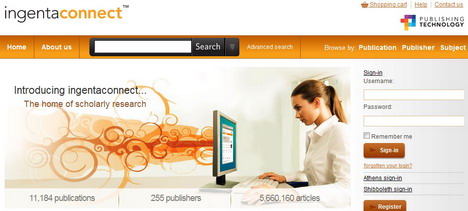
IngentaConnect provides online articles from over 30000 publications. Abstracts are free; full text is available by subscription or pay-per-view. The site is ideal for publishers looking to put their content online for the first time and increase the global visibility of their publications.
66. ASCE Library
ASCE Library is an online civil engineering database that provides the contents of peer-reviewed journals, proceedings, e-books, and standards published by the American Society of Civil Engineers. It offers free access to abstracts of academic journal articles, proceedings papers, e-books, standards, etc.
67. National Bureau of Economic Research (NBER)
Renowned for its pivotal role in economic research, NBER is a hub for high-quality academic papers and data-driven analysis. Catering to economists and policymakers, it disseminates groundbreaking research on diverse economic facets. The site offers access to a wealth of working papers, economic indicators, and conferences, fostering collaboration and innovation in the field.
Tailored for researchers in science and engineering, Inspec is an indispensable database hosting a vast collection of peer-reviewed articles, conference proceedings, and patents. Its meticulously curated content covers an array of disciplines, providing in-depth insights and cutting-edge information crucial for technological advancements and academic pursuits.
69. INSPIRE-HEP
INSPIRE-HEP is an open access digital library for the field of high energy physics. In addition to scientific papers, It provides other information like citation metrics, plots extracted from papers or internal experiment notes and tools for users to improve metadata.
70. MathSciNet Mathematical Reviews
MathSciNet is a fully searchable database with many tools designed to help navigate the mathematical sciences literature. It serves researchers and scholars in the mathematical sciences by providing peer-reviewed articles and books.
71. African Journals Online (AJOL)
AJOL is the world’s largest online library of peer-reviewed, African-published scholarly journals. With AJOL, you can browse peer-reviewed journals from Africa and download full text articles. Articles can be searched by title, authors or keywords.
72. Directory of Open Access Journals (DOAJ)
A champion of open access, DOAJ serves as a goldmine for scholarly literature, housing a wide spectrum of peer-reviewed journals across disciplines. By promoting unrestricted access to quality research, it empowers academics worldwide. Its stringent criteria ensure credibility, fostering transparency and democratizing knowledge dissemination.
73. JournalTOCs
Aiming to streamline academic research, JournalTOCs aggregates tables of contents from thousands of scholarly journals. This platform facilitates swift access to the latest articles, aiding researchers in staying updated within their areas of interest. Its user-friendly interface and customizable alerts enable efficient navigation through a plethora of scholarly content, optimizing the research process.
74. AcademicJournals.org

AcademicJournals.org is a broad-based open access publisher. It provides free access to research information to the international community without financial, legal or technical barriers. All the journals from this organization will be freely distributed and available from multiple websites.
75. Library Genesis (LibGen)
A controversial yet immensely popular platform, LibGen hosts an extensive catalog of academic texts, journals, and books. Known for its extensive collection and accessibility, LibGen is a resource for individuals seeking academic materials that might not be readily available through traditional channels. It has gained traction as a resource for users worldwide due to its broad range of content.
76. PhilPapers.org
PhilPapers.org is a comprehensive index and bibliography of philosophy maintained by the community of philosophers. It’s an online source of research content in philosophy, including journals, books, open access archives, and personal pages maintained by academics.
77. SciELO.org
SciELO hosts a vast collection of academic journals primarily from Latin America, Spain, Portugal, and other Ibero-American regions. It’s a rich resource for accessing scholarly articles in various disciplines, offering open access to high-quality research, fostering knowledge sharing, and promoting regional academic excellence.
78. EBSCO Information Services
EBSCO is a comprehensive platform providing access to a wide array of scholarly journals, articles, and books across multiple disciplines. With its user-friendly interface and robust search capabilities, it’s a go-to resource for researchers, libraries, and institutions globally, offering diverse content and valuable research tools.
79. Econlit
EconLit, a premier resource for economics research, curates a comprehensive database of scholarly journals, articles, and books in the field. Tailored for economists, researchers, and students, it encompasses a vast array of economic literature, including peer-reviewed articles, working papers, and conference proceedings. Its specialized focus ensures in-depth coverage of economic theories, trends, and analyses, serving as an indispensable tool for those immersed in economic studies and research.
80. State Legislative Websites Directory
This online database contains information gleaned from the websites of the 50 state legislatures, the District of Columbia and the territories. You can select to view specific website content materials such as, bills, press rooms, statutes from any states.
81. Information Bridge: Department of Energy Scientific and Technical Information
The Information Bridge serves as a hub for the Department of Energy’s vast scientific and technical knowledge repository. It houses a comprehensive collection of academic journals, articles, and books, focusing on energy-related research. Researchers and academics access cutting-edge information on various energy disciplines, from renewable energy to nuclear physics, aiding in scholarly pursuits and industry advancements.
82. BioOne Complete
BioOne Complete is a specialized database catering to the life sciences, environmental studies, and related fields. It curates a collection of high-impact scholarly journals and research articles, facilitating access to cutting-edge biological research and ecological studies.
83. Civil Engineering Database
CEDB is a free bibliographic database for all ASCE publications including journals, conference proceedings, books, standards, manuals, magazines, and newspapers on all the disciplines of civil engineering. The coverage dates back to 1872.
84. LessonPlanet
LessonPlanet serves educators by offering a vast repository of lesson plans, teaching resources, and educational materials. It’s an invaluable tool for teachers, providing curated content to enhance classroom instruction and streamline lesson planning across various subjects and grade levels.
85. CiteULike
CiteULike is a free online service that allows users to save and share citations to academic papers. Based on the principle of social bookmarking, the site works to promote and to develop the sharing of scientific references amongst researchers.
86. Science.gov
Science.gov acts as a centralized gateway to authoritative scientific information sourced from multiple U.S. government agencies. It aggregates a wide spectrum of academic journals, articles, and books across scientific domains. This resource facilitates comprehensive searches, empowering researchers with reliable scientific data and publications crucial for academic research and evidence-based decision-making.
87. Cochrane Library
Cochrane Library is renowned for its systematic reviews and evidence-based healthcare research. It’s a crucial resource for medical professionals and researchers, offering comprehensive reviews that inform healthcare decisions and practices worldwide.
88. CAB Abstracts – CABI
CAB Abstracts is an English-language bibliographic information online service that provides access to the world’s applied life sciences literature. It comes with CABI Full Text, giving users automatic access to over 410,000 journal articles, conference papers and reports.
Zenodo is an open-access repository for scientific research data, enabling researchers to store, share, and explore datasets across disciplines. It promotes collaboration, transparency, and accessibility in scientific research, fostering innovation and knowledge exchange within the global research community.
90. Archives Hub
Archives Hub serves as a gateway to historical archives in the UK, offering access to a wealth of primary sources. It consolidates descriptions of archives held in various institutions, facilitating academic research. Through detailed records, researchers explore diverse topics spanning arts, humanities, and social sciences. The platform enables users to locate specific materials, aiding in comprehensive and in-depth investigations. Archives Hub stands as a vital resource for scholars delving into historical records, fostering a deeper understanding of past events and societal evolution.
91. OpenStax
Dedicated to advancing access to education, OpenStax offers free, peer-reviewed, and openly licensed textbooks. As an initiative aiming to alleviate the financial burden of education, OpenStax provides quality academic resources across various subjects. With a mission to make learning more accessible, it supports educators and learners globally by offering high-quality educational materials at no cost.
92. Bioline Internationl
Bioline International stands as a prominent platform offering open-access scholarly resources in the life sciences. Hosting a vast repository of peer-reviewed journals from developing countries, it promotes global access to valuable research. With a focus on biodiversity, environment, and healthcare, Bioline International facilitates the dissemination of cutting-edge scientific knowledge. Its diverse collection empowers researchers, students, and practitioners worldwide, fostering collaboration and advancing scientific discovery in crucial fields.
93. WorldWideScience
WorldWideScience serves as a global platform, aggregating scientific content from various countries and international organizations. It offers access to an extensive repository of academic journals, articles, and books, transcending geographical barriers. Researchers benefit from diverse perspectives and a wealth of information, fostering collaboration and knowledge exchange on an international scale.
94. Dimensions.ai
Dimensions.ai is an innovative research platform revolutionizing academic exploration. It integrates a vast array of scholarly resources, including articles, datasets, grants, and patents, offering a comprehensive view of research landscapes. Using sophisticated analytics and visualization tools, it assists researchers in uncovering connections, trends, and emerging areas of study. Dimensions.ai facilitates efficient literature searches, empowering scholars to navigate the expansive realm of academia and make informed contributions to their fields.
95. Ethnologue
Ethnologue is an annual reference publication in print and online that provides statistics and other information on the living languages of the world. It contains information on over 7000 languages including the number of speakers, locations, dialects, linguistic affiliations, autonyms, etc.
96. Taylor & Francis Online
Taylor & Francis Online hosts a vast collection of academic journals, articles, and books across various disciplines. With a user-friendly interface, it offers extensive resources in fields like science, humanities, social sciences, and more. Researchers benefit from comprehensive search tools, robust citation metrics, and access to cutting-edge research.
97. Zentralblatt MATH
Zentralblatt MATH serves as a comprehensive database for mathematical literature, covering a broad spectrum of mathematical research. With its extensive collection of abstracts and reviews, it provides valuable insights into mathematical publications worldwide. Researchers benefit from its indexing of mathematical articles, enabling efficient access to critical information, fostering collaboration, and supporting advancements in the field of mathematics.
98. PubMed Central
PubMed Central, a free digital repository, is a treasure trove of biomedical and life sciences literature. Hosting a vast archive of peer-reviewed articles, PubMed Central is a go-to platform for researchers, healthcare professionals, and students. Its comprehensive database encompasses a myriad of topics, facilitating easy access to authoritative information and fostering advancements in healthcare and life sciences.
99. EconBiz
EconBiz stands as a crucial resource for economists and social scientists, offering access to economic literature, research, and information. It aggregates a diverse range of publications, including articles, working papers, and research papers, facilitating comprehensive research in economics and related disciplines. EconBiz empowers users with efficient search functionalities, access to full-text documents, and information on events and job opportunities, fostering a vibrant academic community in the field of economics.
100. RefSeek – Academic Search Engine
RefSeek is a powerful academic search engine that scours the internet for scholarly resources. It indexes millions of documents, including articles, books, encyclopedias, and journals, ensuring a wide breadth of sources for researchers. With its user-friendly interface and advanced search capabilities, RefSeek streamlines the process of locating credible and authoritative information across various disciplines. It prioritizes academic content, making it an indispensable tool for students, scholars, and educators in their quest for reliable and relevant research materials.
101. Bielefeld Academic Search Engine (BASE)
BASE functions as a robust academic search engine, scouring the web for scholarly resources, including journals, articles, and books. It indexes content from various repositories, providing a user-friendly interface for researchers worldwide. With a focus on open access materials, BASE enhances accessibility to academic literature, supporting scholarly investigations across multiple disciplines.
102. JournalSeek
JournalSeek operates as a comprehensive database for academic journals, offering easy access to scholarly publications. It catalogs journals from diverse disciplines, allowing users to discover relevant articles and research papers. Researchers benefit from a user-friendly interface, streamlined search capabilities, and detailed journal information, facilitating efficient academic exploration and literature reviews.
Click here for more academic databases and search engines .
Remember, while these platforms offer valuable resources, access to some content may require institutional subscriptions or payment. Additionally, it’s essential to verify the credibility and peer-reviewed status of the sources before citing them in academic work.
You May Also Like:

Author: Quertime Team
This post is published by Quertime.com writer / editor. Connect us on Facebook and follow us on X Twitter .
Tags: database , free download , search engine , web app
- Cryptocurrency
- Cyber Security
- Info & News
- Inspiration
- Make Money Online
- Search Engines
- Self-Improvement
- Social Media
- Web Browsers
- Web Development
Related Posts

What's Hot

Navigate: Home | Categories | About Us | Authors | Contact Us | Submit News Tips | Advertise | Write for Us Find us on: Facebook | Twitter | YouTube | Pinterest More: RSS | Sitemap | Back to: Top © 2024 Quertime
University Library, University of Illinois at Urbana-Champaign

Peer Review: An Introduction: Where to Find Peer Reviewed Sources
- Why not just use Google or Wikipedia?
- Where to Find Peer Reviewed Sources
- Where to Get More Help
Need More Help?
Have more questions? Contact Scholarly Communication and Publishing at [email protected] for more information and guidance.
Ask a Librarian
The Ask a Librarian service for general reference is available during all of the hours when the Main Library is open. Visit the Ask a Librarian page to chat with a librarian.
Why is it so hard to find Peer-Reviewed Sources?
It isn't hard to find peer-reviewed sources: you just need to know where to look! If you start in the right place, you can usually find a relevant, peer-reviewed source for your research in as few clicks as a Google search, and you can even use many of the search techniques you use in Google and Wikipedia.
The easiest way to find a peer-reviewed article is by using one of the Library's numerous databases. All of the Library's databases are listed in the Online Journals and Databases index. The databases are divided by name and discipline.
Departmental libraries and library subject guides have created subject-focused lists of electronic and print research resources that are useful for their disciplines. You can search the library directory for links to the departmental libraries at the University of Illinois Library, or search library websites by college if you're not sure which departmental library serves your subject.
Peer-Reviewed Resources for Disciplinary Topics
There are numerous print and digital resources for specific disciplines, areas of study, and specialist fields. To find research resources and databases for your area, consult the comprehensive directory of LibGuides , the websites of specialist libraries, and above all, contact a librarian for help !
Here are a few major databases for finding peer-reviewed research sources in the humanities, social sciences, and sciences:
- MLA International Bibliography This link opens in a new window Indexes critical materials on literature, languages, linguistics, and folklore. Proved access to citations from worldwide publications, including periodicals, books, essay collections, working papers, proceedings, dissertations and bibliographies. more... less... Alternate Access Link
- Web of Science (Core Collection) This link opens in a new window Web of Science indexes core journal articles, conference proceedings, data sets, and other resources in the sciences, social sciences, arts, and humanities.
- Academic Search Ultimate This link opens in a new window A scholarly, multidisciplinary database providing indexing and abstracts for over 10,000 publications, including monographs, reports, conference proceedings, and others. Also includes full-text access to over 5,000 journals. Offers coverage of many areas of academic study including: archaeology, area studies, astronomy, biology, chemistry, civil engineering, electrical engineering, ethnic & multicultural studies, food science & technology, general science, geography, geology, law, mathematics, mechanical engineering, music, physics, psychology, religion & theology, women's studies, and other fields. more... less... Alternate Access Link
- IEEE Xplore This link opens in a new window Provides full-text access to IEEE transactions, IEEE and IEE journals, magazines, and conference proceedings published since 1988, and all current IEEE standards; brings additional search and access features to IEEE/IEE digital library users. Browsable by books & e-books, conference publications, education and learning, journals and magazines, standards and by topic. Also provides links to IEEE standards, IEEE spectrum and other sites.
- Scopus This link opens in a new window Scopus is the largest abstract and citation database including peer-reviewed titles from international publishers, Open Access journals, conference proceedings, trade publications and quality web sources. Subject coverage includes: Chemistry, Physics, Mathematics and Engineering; Life and Health Sciences; Social Sciences, Psychology and Economics; Biological, Agricultural and Environmental Sciences.
- Business Source Ultimate This link opens in a new window Provides bibliographic and full text content, including indexing and abstracts for scholarly business journals back as far as 1886 and full text journal articles in all disciplines of business, including marketing, management, MIS, POM, accounting, finance and economics. The database full text content includes financial data, books, monographs, major reference works, book digests, conference proceedings, case studies, investment research reports, industry reports, market research reports, country reports, company profiles, SWOT analyses and more. more... less... Alternate Access Link
- << Previous: Why not just use Google or Wikipedia?
- Next: Where to Get More Help >>
- Last Updated: Nov 9, 2023 11:15 AM
- URL: https://guides.library.illinois.edu/peerreview

28 Best Academic Search Engines That make your research easier
This post may contain affiliate links that allow us to earn a commission at no expense to you. Learn more

If you’re a researcher or scholar, you know that conducting effective online research is a critical part of your job. And if you’re like most people, you’re always on the lookout for new and better ways to do it.
I’m sure you are familiar with some research databases. But, top researchers keep an open mind and are always looking for inspiration in unexpected places.
This article aims to give you an edge over researchers that rely mainly on Google for their entire research process.
Our list of 28 academic search engines will start with the more familiar to less.
Table of Contents
#1. Google Scholar

Google Scholar is an academic search engine that indexes the full text or metadata of scholarly literature across an array of publishing formats and disciplines.
Great for academic research, you can use Google Scholar to find articles from academic journals, conference proceedings, theses, and dissertations. The results returned by Google Scholar are typically more relevant and reliable than those from regular search engines like Google.
Tip: You can restrict your results to peer-reviewed articles only by clicking on the “Scholarly”
- Scholarly results are typically more relevant and reliable than those from regular search engines like Google.
- You can restrict your results to peer-reviewed articles only by clicking on the “Scholarly” tab.
- Google Scholar database Coverage is extensive, with approx. 200 million articles indexed.
- Abstracts are available for most articles.
- Related articles are shown, as well as the number of times an article has been cited.
- Links to full text are available for many articles.
- Abstracts are only a snippet of the full article, so you might need to do additional searching to get the full information you need.
- Not all articles are available in full text.
Google Scholar is completely free.
#2. ERIC (Education Resources Information Center)
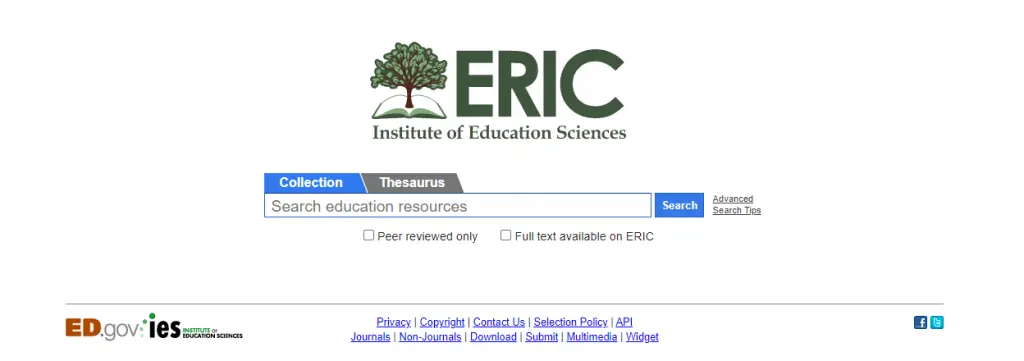
ERIC (short for educational resources information center) is a great academic search engine that focuses on education-related literature. It is sponsored by the U.S. Department of Education and produced by the Institute of Education Sciences.
ERIC indexes over a million articles, reports, conference papers, and other resources on all aspects of education from early childhood to higher education. So, search results are more relevant to Education on ERIC.
- Extensive coverage: ERIC indexes over a million articles, reports, and other resources on all aspects of education from early childhood to higher education.
- You can limit your results to peer-reviewed journals by clicking on the “Peer-Reviewed” tab.
- Great search engine for educators, as abstracts are available for most articles.
ERIC is a free online database of education-related literature.
You might also like:
- SCI Journal: Science Journal Impact Factor
- 15 Best Websites to Download Research Papers for Free
- 11 Best Academic Writing Tools For Researchers 2024
- 10 Best Reference Management Software for Research 2024
- Academic Tools
#3. Wolfram Alpha

Wolfram Alpha is a “computational knowledge engine” that can answer factual questions posed in natural language. It can be a useful search tool.
Type in a question like “What is the square root of 64?” or “What is the boiling point of water?” and Wolfram Alpha will give you an answer.
Wolfram Alpha can also be used to find academic articles. Just type in your keywords and Wolfram Alpha will generate a list of academic articles that match your query.
Tip: You can restrict your results to peer-reviewed journals by clicking on the “Scholarly” tab.
- Can answer factual questions posed in natural language.
- Can be used to find academic articles.
- Results are ranked by relevance.
- Results can be overwhelming, so it’s important to narrow down your search criteria as much as possible.
- The experience feels a bit more structured but it could also be a bit restrictive
Wolfram Alpha offers a few pricing options, including a “Pro” subscription that gives you access to additional features, such as the ability to create custom reports. You can also purchase individual articles or download them for offline use.
Pro costs $5.49 and Pro Premium costs $9.99
#4. iSEEK Education
- 15 Best Websites To Download Research Papers For Free
- 30+ Essential Software For Researchers
- 15 Best Academic Research Trend Prediction Platforms
- 15 Best Academic Networking And Collaboration Platforms
iSEEK is a search engine targeting students, teachers, administrators, and caregiver. It’s designed to be safe with editor-reviewed content.
iSEEK Education also includes a “Cited by” feature which shows you how often an article has been cited by other researchers.
- Editor-reviewed content.
- “Cited by” feature shows how often an article has been cited by other researchers.
- Limited to academic content.
- Doesn’t have the breadth of coverage that some of the other academic search engines have.
iSEEK Education is free to use.
#5. BASE (Bielefeld Academic Search Engine)
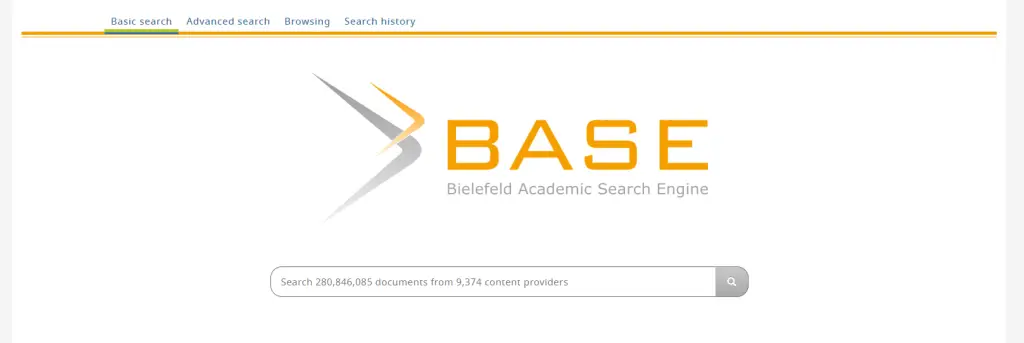
BASE is hosted at Bielefeld University in Germany and that’s where it name stems from (Bielefeld Academic Search Engine).
Known as “one of the most comprehensive academic web search engines,” it contains over 100 million documents from 4,000 different sources.
Users can narrow their search using the advanced search option, so regardless of whether you need a book, a review, a lecture, a video or a thesis, BASE has what you need.
BASE indexes academic articles from a variety of disciplines, including the arts, humanities, social sciences, and natural sciences.
- One of the world’s most voluminous search engines,
- Indexes academic articles from a variety of disciplines, especially for academic web resources
- Includes an “Advanced Search” feature that lets you restrict your results to peer-reviewed journals.
- Doesn’t include abstracts for most articles.
- Doesn’t have related articles, references, cited by
BASE is free to use.
- 10 Best Reference Management Software for Research 2023
- 15 Best Academic Networking and Collaboration Platforms
- 30+ Essential Software for Researchers
- 15 Best Academic Blogging and Content Management
- 11 Best Academic Writing Tools For Researchers
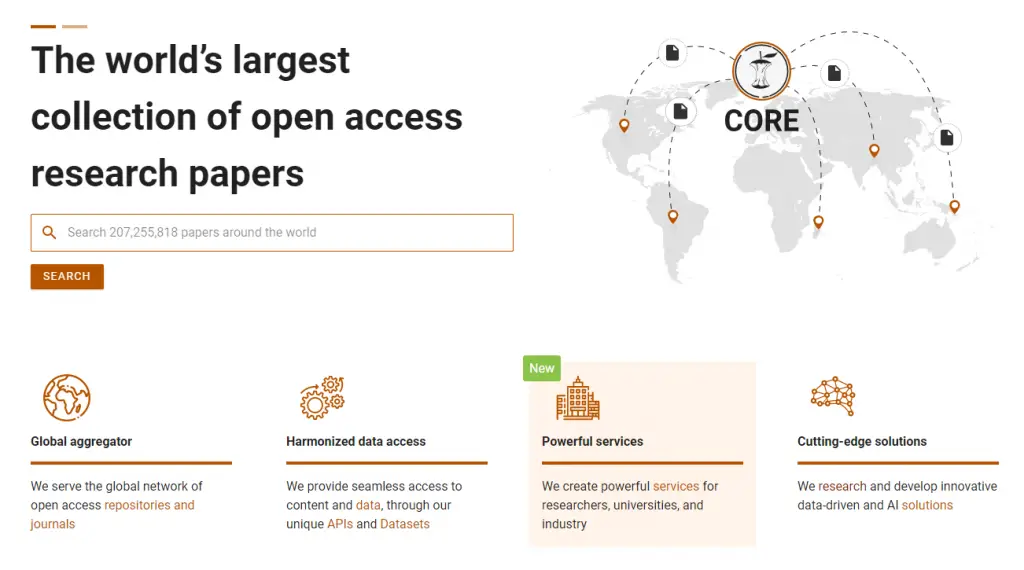
CORE is an academic search engine that focuses on open access research papers. A link to the full text PDF or complete text web page is supplied for each search result. It’s academic search engine dedicated to open access research papers.
- Focused on open access research papers.
- Links to full text PDF or complete text web page are supplied for each search result.
- Export formats include BibTeX, Endnote, RefWorks, Zotero.
- Coverage is limited to open access research papers.
- No abstracts are available for most articles.
- No related articles, references, or cited by features.
CORE is free to use.
- Best Plagiarism Checkers for Research Papers in 2024
#7. Science.gov

Science.gov is a search engine developed and managed by the United States government. It includes results from a variety of scientific databases, including NASA, EPA, USGS, and NIST.
US students are more likely to have early exposure to this tool for scholarly research.
- Coverage from a variety of scientific databases (200 million articles and reports).
- Links to full text are available for some articles.
Science.gov is free to use.
- 15 Best Academic Journal Discovery Platforms
- Sci Hub Review
#8. Semantic Scholar

Semantic Scholar is a recent entrant to the field. Its goal is to provide more relevant and effective search results via artificial intelligence-powered methods that detect hidden relationships and connections between research topics.
- Powered by artificial intelligence, which enhances search results.
- Covers a large number of academic articles (approx. 40 million).
- Related articles, references, and cited by features are all included.
- Links to full text are available for most articles.
Semantic Scholar is free to use.
- 11 Best Academic Writing Tools For Researchers
- 10 Best Reference Management Software for Research
- 15 Best Academic Journal Discovery Platforms
#9. RefSeek

RefSeek searches more than five billion documents, including web pages, books, encyclopedias, journals, and newspapers.
This is one of the free search engines that feels like Yahoo with a massive directory. It could be good when you are just looking for research ideas from unexpected angles. It could lead you to some other database that you might not know such as the CIA The World Factbook, which is a great reference tool.
- Searches more than five billion documents.
- The Documents tab is very focused on research papers and easy to use.
- Results can be filtered by date, type of document, and language.
- Good source for free academic articles, open access journals, and technical reports.
- The navigation and user experience is very dated even to millenials…
- It requires more than 3 clicks to dig up interesting references (which is how it could lead to you something beyond the 1st page of Google)
- The top part of the results are ALL ads (well… it’s free to use)
RefSeek is free to use.
#10. ResearchGate

A mixture of social networking site + forum + content databases where researchers can build their profile, share research papers, and interact with one another.
Although it is not an academic search engine that goes outside of its site, ResearchGate ‘s library of works offers an excellent choice for any curious scholar.
There are more than 100 million publications available on the site from over 11 million researchers. It is possible to search by publication, data, and author, as well as to ask the researchers questions.
- A great place to find research papers and researchers.
- Can follow other researchers and get updates when they share new papers or make changes to their profile.
- The network effect can be helpful in finding people who have expertise in a particular topic.
- Interface is not as user friendly
- Can be overwhelming when trying to find relevant papers.
- Some papers are behind a paywall.
ResearchGate is free to use.
- 15 Best Academic Research Trend Prediction Platforms
- 25 Best Tools for Tracking Research Impact and Citations
#11. DataONE Search (formerly CiteULike)
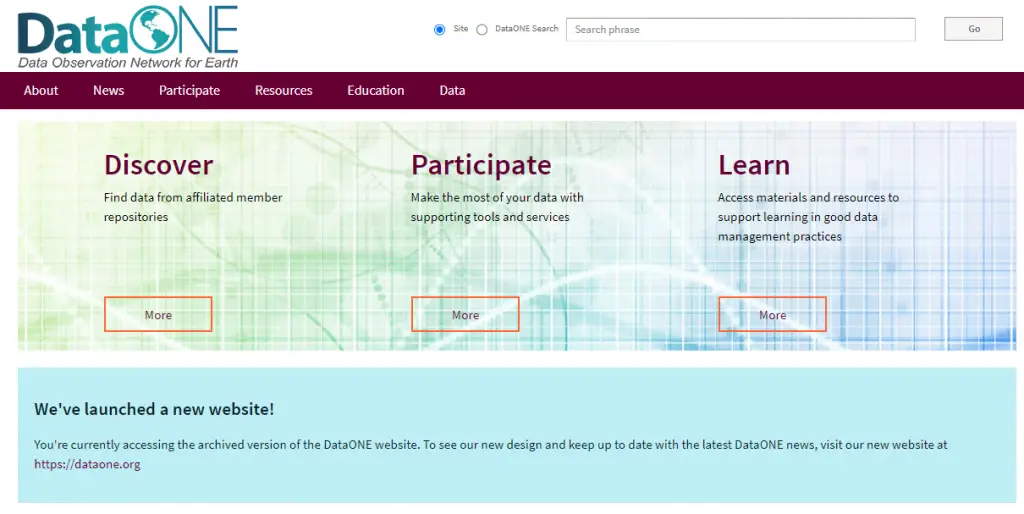
A social networking site for academics who want to share and discover academic articles and papers.
- A great place to find academic papers that have been shared by other academics.
- Some papers are behind a paywall
CiteULike is free to use.
#12. DataElixir

DataElixir is deigned to help you find, understand and use data. It includes a curated list of the best open datasets, tools and resources for data science.
- Dedicated resource for finding open data sets, tools, and resources for data science.
- The website is easy to navigate.
- The content is updated regularly
- The resources are grouped by category.
- Not all of the resources are applicable to academic research.
- Some of the content is outdated.
DataElixir is free to use.
#13. LazyScholar – browser extension
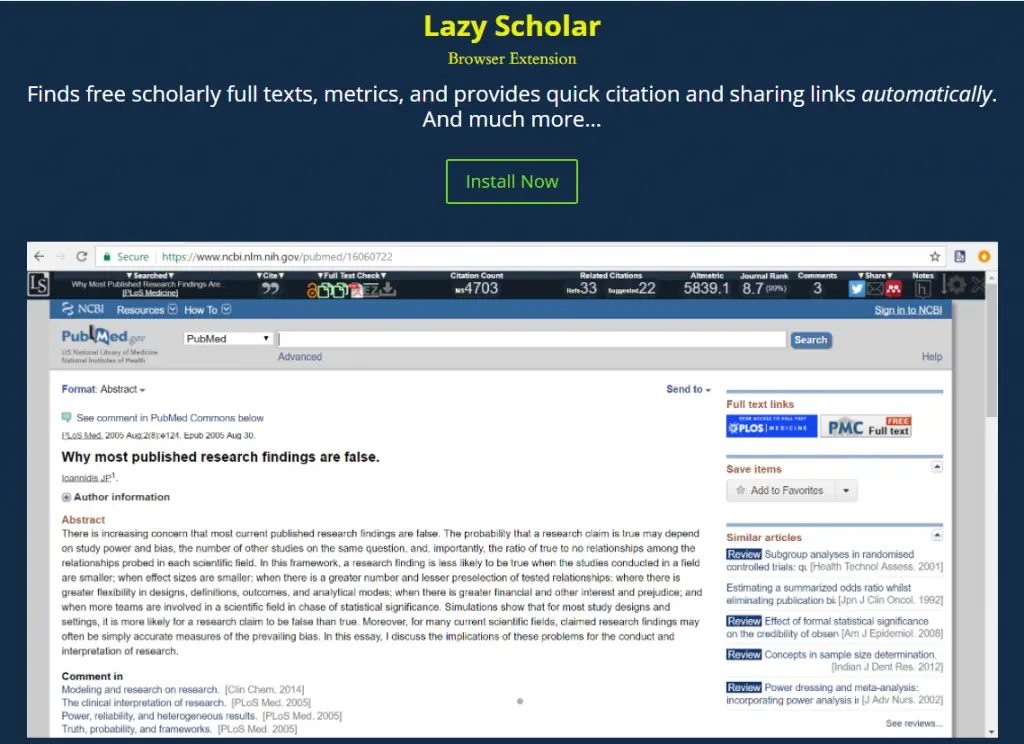
LazyScholar is a free browser plugin that helps you discover free academic full texts, metrics, and instant citation and sharing links. Lazy Scholar is created Colby Vorland, a postdoctoral fellow at Indiana University.
- It can integrate with your library to find full texts even when you’re off-campus.
- Saves your history and provides an interface to find it.
- A pre-formed citation is availlable in over 900 citation styles.
- Can recommend you topics and scans new PubMed listings to suggest new papers
- Results can be a bit hit or miss
LazyScholar is free to use.
#14. CiteseerX – digital library from PenState

CiteseerX is a digital library stores and indexes research articles in Computer Science and related fields. The site has a robust search engine that allows you to filter results by date, author.
- Searches a large number of academic papers.
- Results can be filtered by date, author, and topic.
- The website is easy to use.
- You can create an account and save your searches for future reference.
CiteseerX is free to use.
- Surfer Review: Is It Worth It?
- 25 Best Tools For Tracking Research Impact And Citations
#15. The Lens – patents search
The Lens or the Patent Lens is an online patent and scholarly literature search facility, provided by Cambia, an Australia-based non-profit organization.

- Searches for a large number of academic papers.
The price range can be free for non-profit use to $5,000 for commercial enterprise.
#16. Fatcat – wiki for bibliographic catalog
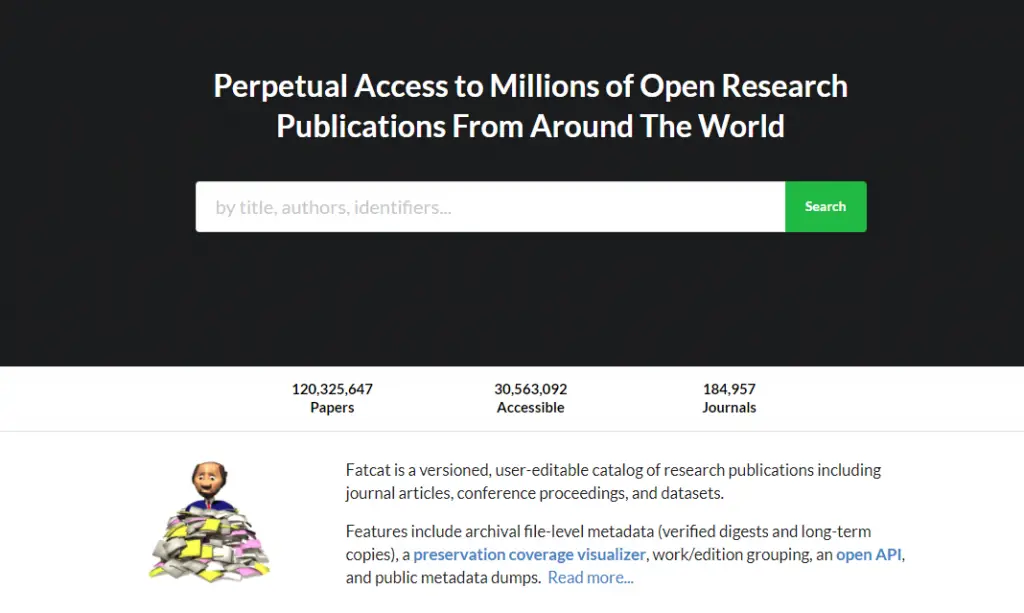
Fatcat is an open bibliographic catalog of written works. The scope of works is somewhat flexible, with a focus on published research outputs like journal articles, pre-prints, and conference proceedings. Records are collaboratively editable, versioned, available in bulk form, and include URL-agnostic file-level metadata.
- Open source and collaborative
- You can be part of the community that is very focused on its mission
- The archival file-level metadata (verified digests and long-term copies) is a great feature.
- Could prove to be another rabbit hole
- People either love or hate the text-only interface
#17. Lexis Web – Legal database
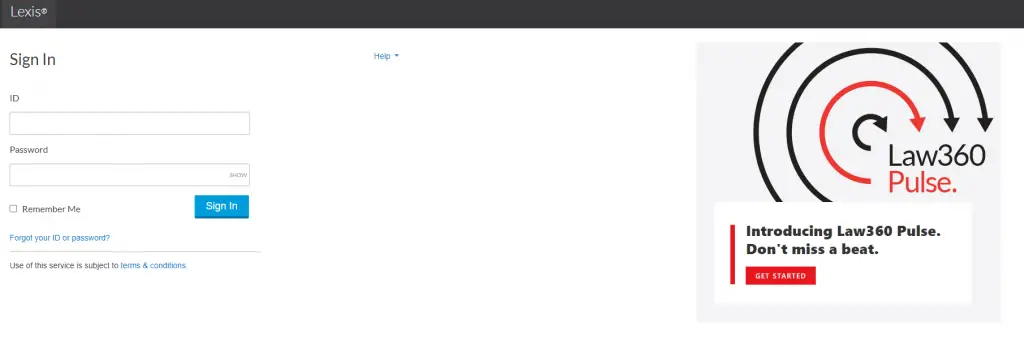
Are you researching legal topics? You can turn to Lexis Web for any law-related questions you may have. The results are drawn from legal sites and can be filtered based on criteria such as news, blogs, government, and commercial. Additionally, users can filter results by jurisdiction, practice area, source and file format.
- Results are drawn from legal sites.
- Filters are available based on criteria such as news, blogs, government, and commercial.
- Users can filter results by jurisdiction, practice area, source and file format.
- Not all law-related questions will be answered by this search engine.
- Coverage is limited to legal sites only.
Lexis Web is free for up to three searches per day. After that, a subscription is required.
#18. Infotopia – part of the VLRC family
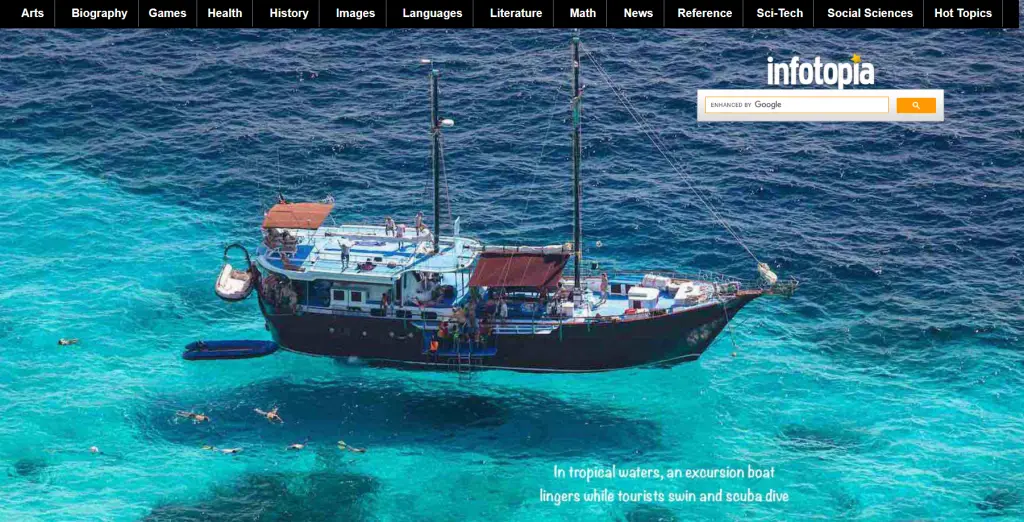
Infotopia touts itself as an “alternative to Google safe search.” Scholarly book results are curated by librarians, teachers, and other educational workers. Users can select from a range of topics such as art, health, and science and technology, and then see a list of resources pertaining to the topic.
Consequently, if you aren’t able to find what you are looking for within Infotopia’s pages, you will probably find it on one of its many suggested websites.
#19. Virtual Learning Resources Center
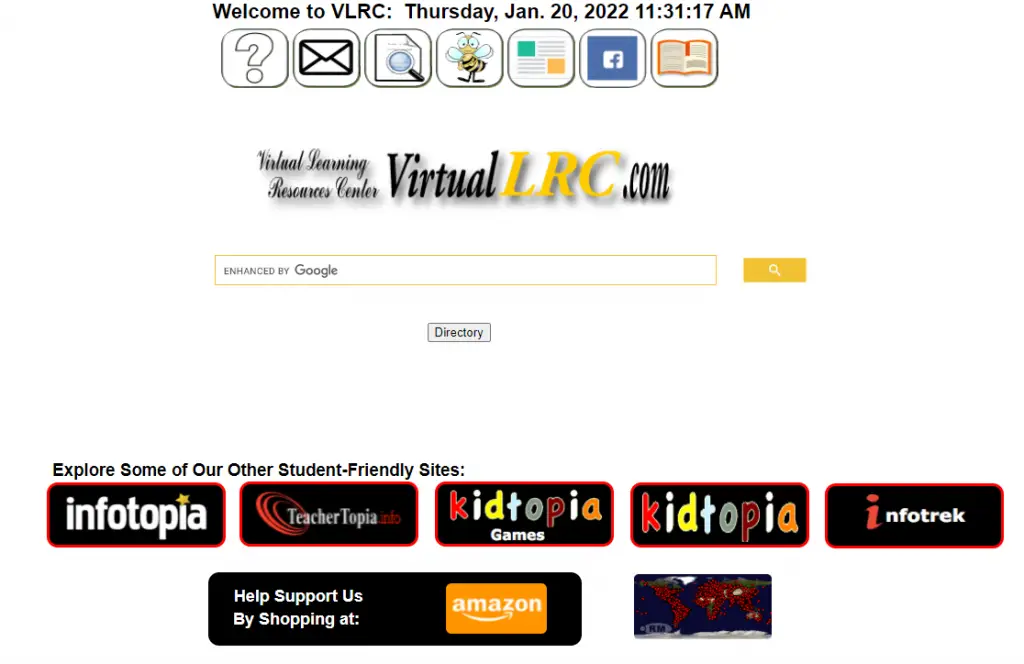
Virtual Learning Resources Center (VLRC) is an academic search engine that features thousands of academic sites chosen by educators and librarians worldwide. Using an index generated from a research portal, university, and library internet subject guides, students and instructors can find current, authoritative information for school.
- Thousands of academic information websites indexed by it. You will also be able to get more refined results with custom Google search, which will speed up your research.
- Many people consider VLRC as one of the best free search engines to start looking for research material.
- TeachThought rated the Virtual LRC #3 in it’s list of 100 Search Engines For Academic Research
- More relevant to education
- More relevant to students

Powered by Google Custom Search Engine (CSE), Jurn is a free online search engine for accessing and downloading free full-text scholarly papers. It was created by David Haden in a public open beta version in February 2009, initially for locating open access electronic journal articles in the arts and humanities.
After the indexing process was completed, a website containing additional public directories of web links to indexed publications was introduced in mid-2009. The Jurn search service and directory has been regularly modified and cleaned since then.
- A great resource for finding academic papers that are behind paywalls.
- The content is updated regularly.uren
Jurn is free to use.
#21. WorldWideScience
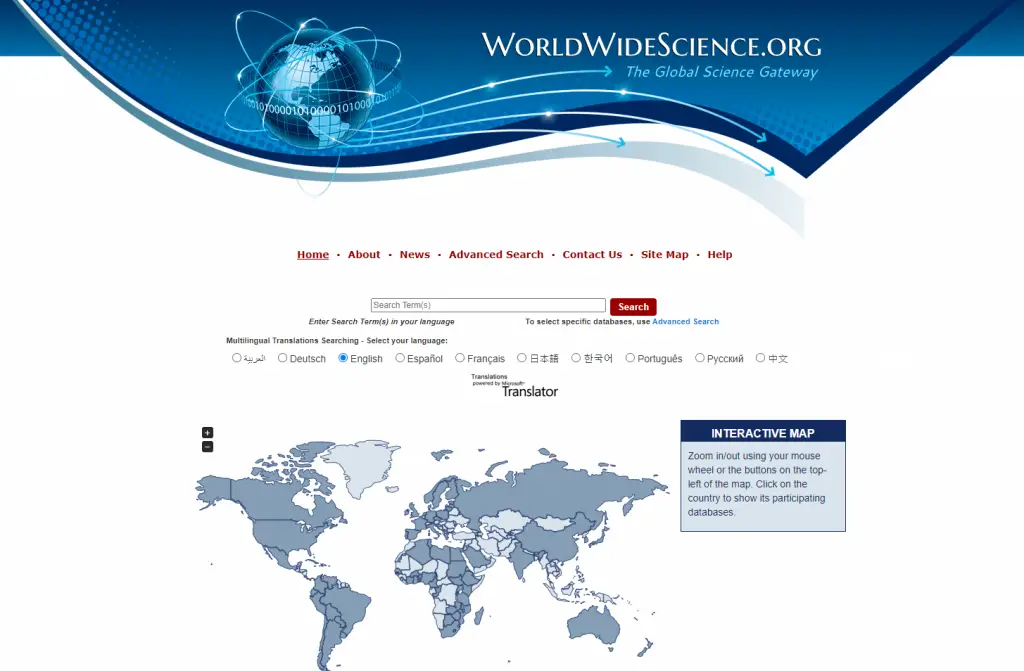
The Office of Scientific and Technical Information—a branch of the Office of Science within the U.S. Department of Energy—hosts the portal WorldWideScience , which has dubbed itself “The Global Science Gateway.”
Over 70 countries’ databases are used on the website. When a user enters a query, it contacts databases from all across the world and shows results in both English and translated journals and academic resources.
- Results can be filtered by language and type of resource
- Interface is easy to use
- Contains both academic journal articles and translated academic resources
- The website can be difficult to navigate.
WorldWideScience is free to use.
#22. Google Books

A user can browse thousands of books on Google Books, from popular titles to old titles, to find pages that include their search terms. You can look through pages, read online reviews, and find out where to buy a hard copy once you find the book you are interested in.
#23. DOAJ (Directory of Open Access Journals)
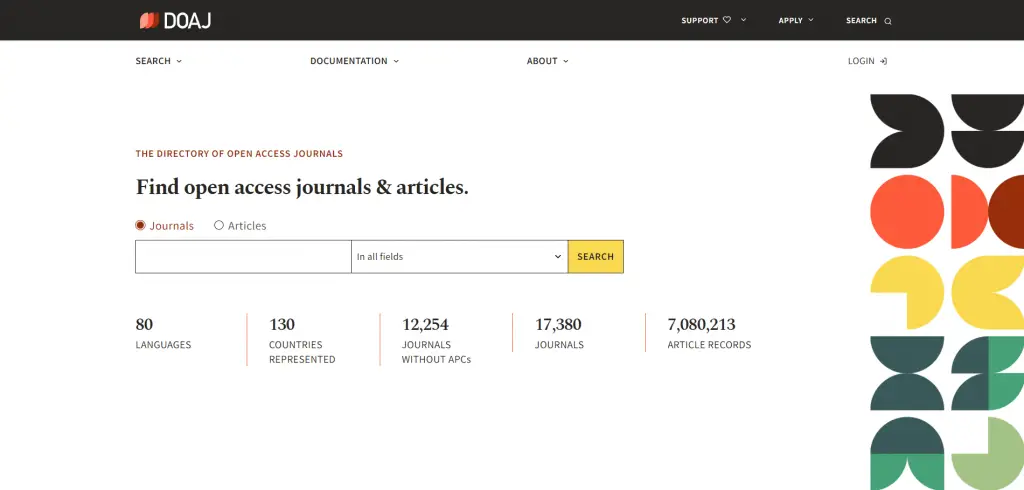
DOAJ is a free search engine for scientific and scholarly materials. It is a searchable database with over 8,000 peer-reviewed research papers organized by subject. It’s one of the most comprehensive libraries of scientific and scholarly resources, with over 8,000 journals available on a variety of themes.
#24. Baidu Scholar

Baidu Xueshu (Academic) is the Chinese version for Google Scholar. IDU Scholar indexes academic papers from a variety of disciplines in both Chinese and English.
- Articles are available in full text PDF.
- Covers a variety of academic disciplines.
- No abstracts are available for most articles, but summaries are provided for some.
- A great portal that takes you to different specialized research platform
- You need to be able to read Chinese to use the site
- Since 2021 there is a rise of focus on China and the Chinese Communist Party
Baidu Scholar is free to use.
#25. PubMed Central
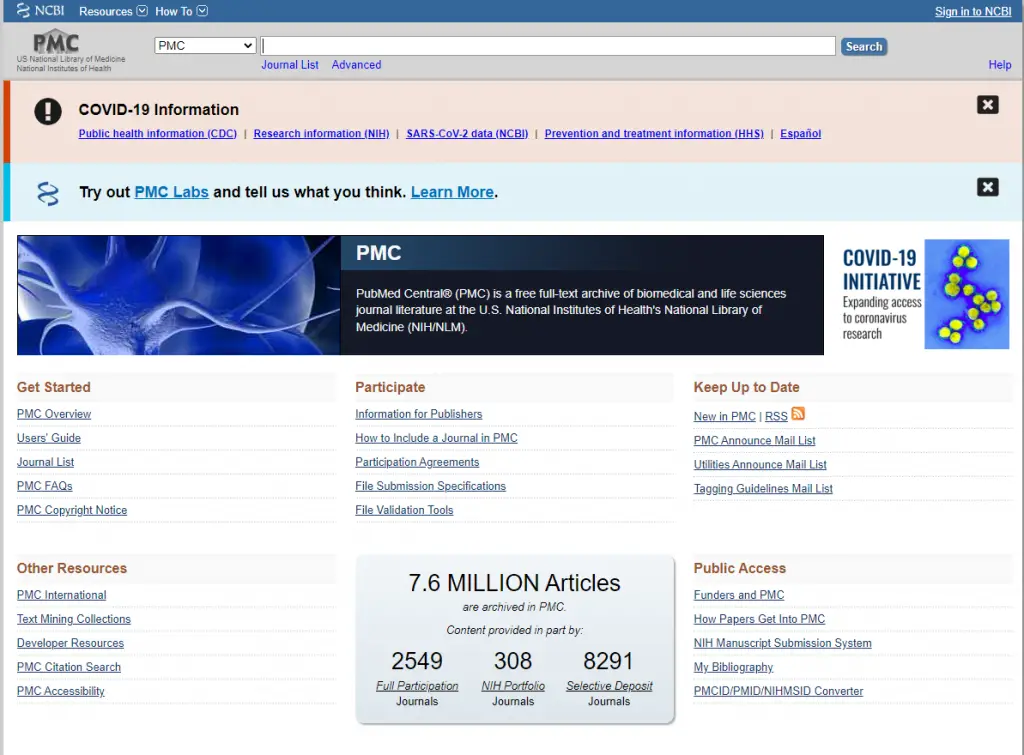
PubMed is a free search engine that provides references and abstracts for medical, life sciences, and biomedical topics.
If you’re studying anything related to healthcare or science, this site is perfect. PublicMed Central is operated by the National Center for Biotechnology Information, a division of the U.S. National Library of Medicine. It contains more than 3 million full-text journal articles.
It’s similar to PubMed Health, which focuses on health-related research and includes abstracts and citations to over 26 million articles.
#26. MEDLINE®
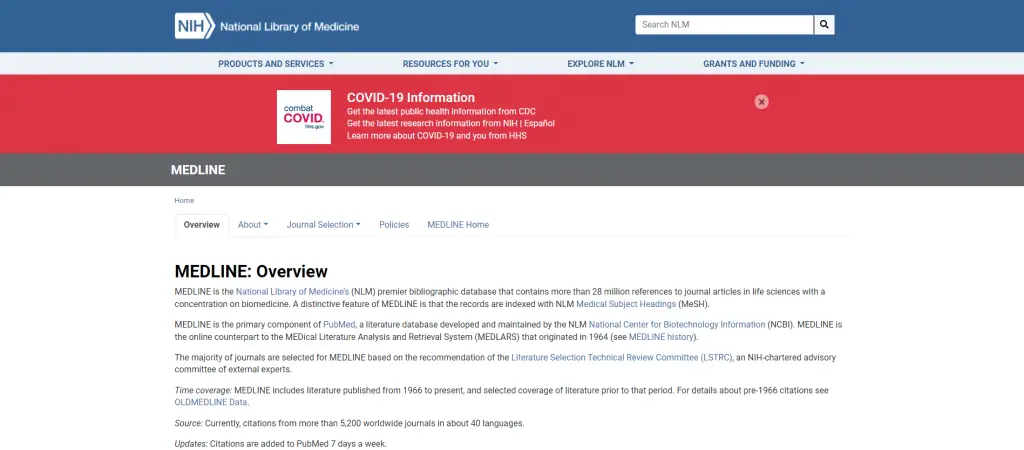
MEDLINE® is a paid subscription database for life sciences and biomedicine that includes more than 28 million citations to journal articles. For finding reliable, carefully chosen health information, Medline Plus provides a powerful search tool and even a dictionary.
- A great database for life sciences and biomedicine.
- Contains more than 28 million references to journal articles.
- References can be filtered by date, type of document, and language.
- The database is expensive to access.
- Some people find it difficult to navigate and find what they are looking for.
MEDLINE is not free to use ( pricing information ).
Defunct Academic Search Engines
#27. microsoft academic .
Microsoft Academic
Microsoft Academic Search seemed to be a failure from the beginning. It ended in 2012, then re-launched in 2016 as Microsoft Academic. It provides the researcher with the opportunity to search academic publications,
Microsoft Academic used to be the second-largest academic search engine after Google Scholar. Microsoft Academic provides a wealth of data for free, but Microsoft has announced that it will shut Microsoft Academic down in by 2022.
#28. Scizzle
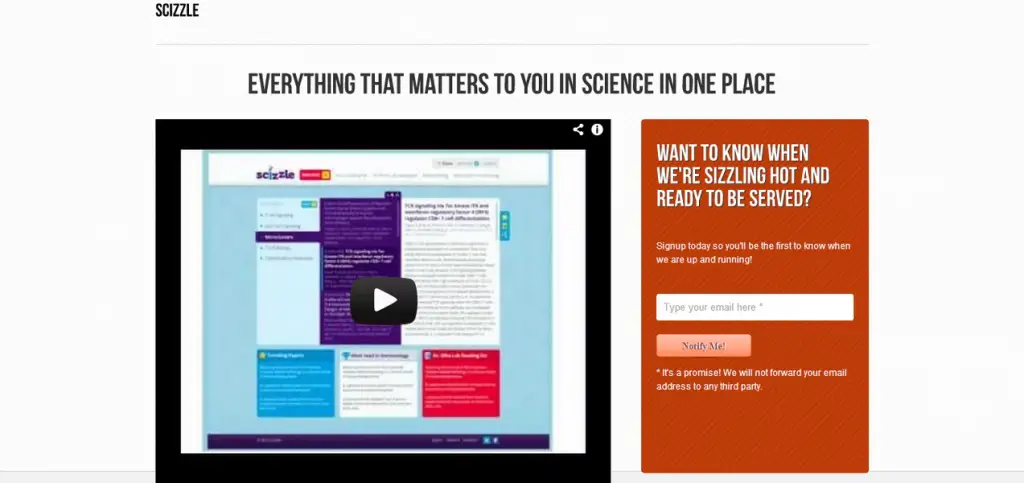
Designed to help researchers stay on top of the literature by setting up email alerts, based on key terms, for newspapers.
Unfortunately, academic search engines come and go. These are two that are no longer available.
Final Thoughts
There are many academic search engines that can help researchers and scholars find the information they need. This list provides a variety of options, starting with more familiar engines and moving on to less well-known ones.
Keeping an open mind and exploring different sources is essential for conducting effective online research. With so much information at our fingertips, it’s important to make sure we’re using the best tools available to us.
Tell us in the comment below which academic search engine have you not heard of? Which database do you think we should add? What database do your professional societies use? What are the most useful academic websites for research in your opinion?
There is more.
Check out our other articles on the Best Academic Tools Series for Research below.
- Learn how to get more done with these Academic Writing Tools
- Learn how to proofread your work with these Proofreading Tools
- Learn how to broaden your research landscape with these Academic Search Engines
- Learn how to manage multiple research projects with these Project Management Tools
- Learn how to run effective survey research with these Survey Tools for Research
- Learn how get more insights from important conversations and interviews with Transcription Tools
- Learn how to manage the ever-growing list of references with these Reference Management Software
- Learn how to double your productivity with literature reviews with these AI-Based Summary Generators
- Learn how to build and develop your audience with these Academic Social Network Sites
- Learn how to make sure your content is original and trustworthy with these Plagiarism Checkers
- Learn how to talk about your work effectively with these Science Communication Tools
10 thoughts on “28 Best Academic Search Engines That make your research easier”
Thank you so much Joannah..I have found this information useful to me as librarian in an academic library
You are welcome! We are happy to hear that!
Thank You Team, for providing a comprehensive list of academic search engines that can help make research easier for students and scholars. The variety of search engines included offers a range of options for finding scholarly articles, journals, and other academic resources. The article also provides a brief summary of each search engine’s features, which helps in determining which one is the best fit for a specific research topic. Overall, this article is a valuable resource for anyone looking for a quick and easy way to access a wealth of academic information.
Thank you for taking the time to share your feedback with us. We are delighted to hear that you found our list of academic search engines helpful in making research easier for students and scholars. We understand the importance of having a variety of options when it comes to finding scholarly articles, journals, and other academic resources, and we strive to provide a comprehensive list of resources to meet those needs.
We are glad that you found the brief summary of each search engine’s features helpful in determining which one is the best fit for a specific research topic. Our goal is to make it easy for our readers to access valuable academic information and we’re glad that we were able to achieve that for you.
We appreciate your support and thank you for your kind words. We will continue to provide valuable resources for students and researchers in the future. Please let us know if you have any further questions or suggestions.
No more questions Thank You
I cannot thank you enough!!! thanks alot 🙂
Typography animation is a technique that combines text and motion to create visually engaging and dynamic animations. It involves animating individual letters, words, or phrases in various ways to convey a message, evoke emotions, or enhance the visual impact of a design or video. – Typography Animation Techniques Tools and Online Software {43}
Hi Joannah! Here’s another one you may want to add! Expontum ( https://www.expontum.com/ ) – Helps researchers quickly find knowledge gaps and identify what research projects have been completed before. Thanks!
Expontum – Helps researchers quickly find knowledge gaps and identify what research projects have been completed before. Expontum is free, open access, and available to all globally with no paid versions of the site. Automated processes scan research article information 24/7 so this website is constantly updating. By looking at over 35 million research publications (240 million by the end of 2023), the site has 146 million tagged research subjects and 122 million tagged research attributes. Learn more about methodology and sources on the Expontum About Page ( https://www.expontum.com/about.php )
Hey Ryan, I clicked and checked your site and thought it was very relevant to our reader. Thank you for sharing. And, we will be reviewing your site soon.
Sounds good! Thanks, Joannah!
Leave a Comment Cancel reply
Save my name, email, and website in this browser for the next time I comment.
We maintain and update science journals and scientific metrics. Scientific metrics data are aggregated from publicly available sources. Please note that we do NOT publish research papers on this platform. We do NOT accept any manuscript.
2012-2024 © scijournal.org
21 Legit Research Databases for Free Journal Articles in 2024
#scribendiinc
Written by Scribendi
Has this ever happened to you? While looking for websites for research, you come across a research paper site that claims to connect academics to a peer-reviewed article database for free.
Intrigued, you search for keywords related to your topic, only to discover that you must pay a hefty subscription fee to access the service. After the umpteenth time being duped, you begin to wonder if there's even such a thing as free journal articles.
Subscription fees and paywalls are often the bane of students and academics, especially those at small institutions who don't provide access to many free article directories and repositories.
Whether you're working on an undergraduate paper, a PhD dissertation, or a medical research study, we want to help you find tools to locate and access the information you need to produce well-researched, compelling, and innovative work.
Below, we discuss why peer-reviewed articles are superior and list out the best free article databases to use in 2024.
Download Our Free Research Database Roundup PDF
Why peer-reviewed scholarly journal articles are more authoritative.

Determining what sources are reliable can be challenging. Peer-reviewed scholarly journal articles are the gold standard in academic research. Reputable academic journals have a rigorous peer-review process.
The peer review process provides accountability to the academic community, as well as to the content of the article. The peer review process involves qualified experts in a specific (often very specific) field performing a review of an article's methods and findings to determine things like quality and credibility.
Peer-reviewed articles can be found in peer-reviewed article databases and research databases, and if you know that a database of journals is reliable, that can offer reassurances about the reliability of a free article. Peer review is often double blind, meaning that the author removes all identifying information and, likewise, does not know the identity of the reviewers. This helps reviewers maintain objectivity and impartiality so as to judge an article based on its merit.
Where to Find Peer-Reviewed Articles
Peer-reviewed articles can be found in a variety of research databases. Below is a list of some of the major databases you can use to find peer-reviewed articles and other sources in disciplines spanning the humanities, sciences, and social sciences.
What Are Open Access Journals?
An open access (OA) journal is a journal whose content can be accessed without payment. This provides scholars, students, and researchers with free journal articles. OA journals use alternate methods of funding to cover publication costs so that articles can be published without having to pass those publication costs on to the reader.

Some of these funding models include standard funding methods like advertising, public funding, and author payment models, where the author pays a fee in order to publish in the journal. There are OA journals that have non-peer-reviewed academic content, as well as journals that focus on dissertations, theses, and papers from conferences, but the main focus of OA is peer-reviewed scholarly journal articles.
The internet has certainly made it easier to access research articles and other scholarly publications without needing access to a university library, and OA takes another step in that direction by removing financial barriers to academic content.
Choosing Wisely
Features of legitimate oa journals.
There are things to look out for when trying to decide if a free publication journal is legitimate:
Mission statement —The mission statement for an OA journal should be available on their website.
Publication history —Is the journal well established? How long has it been available?
Editorial board —Who are the members of the editorial board, and what are their credentials?
Indexing —Can the journal be found in a reliable database?
Peer review —What is the peer review process? Does the journal allow enough time in the process for a reliable assessment of quality?
Impact factor —What is the average number of times the journal is cited over a two-year period?
Features of Illegitimate OA Journals
There are predatory publications that take advantage of the OA format, and they are something to be wary of. Here are some things to look out for:
Contact information —Is contact information provided? Can it be verified?
Turnaround —If the journal makes dubious claims about the amount of time from submission to publication, it is likely unreliable.
Editorial board —Much like determining legitimacy, looking at the editorial board and their credentials can help determine illegitimacy.
Indexing —Can the journal be found in any scholarly databases?
Peer review —Is there a statement about the peer review process? Does it fit what you know about peer review?
How to Find Scholarly Articles
Identify keywords.
Keywords are included in an article by the author. Keywords are an excellent way to find content relevant to your research topic or area of interest. In academic searches, much like you would on a search engine, you can use keywords to navigate through what is available to find exactly what you're looking for.
Authors provide keywords that will help you easily find their article when researching a related topic, often including general terms to accommodate broader searches, as well as some more specific terms for those with a narrower scope. Keywords can be used individually or in combination to refine your scholarly article search.
Narrow Down Results
Sometimes, search results can be overwhelming, and searching for free articles on a journal database is no exception, but there are multiple ways to narrow down your results. A good place to start is discipline.
What category does your topic fall into (psychology, architecture, machine learning, etc.)? You can also narrow down your search with a year range if you're looking for articles that are more recent.
A Boolean search can be incredibly helpful. This entails including terms like AND between two keywords in your search if you need both keywords to be in your results (or, if you are looking to exclude certain keywords, to exclude these words from the results).
Consider Different Avenues
If you're not having luck using keywords in your search for free articles, you may still be able to find what you're looking for by changing your tactics. Casting a wider net sometimes yields positive results, so it may be helpful to try searching by subject if keywords aren't getting you anywhere.
You can search for a specific publisher to see if they have OA publications in the academic journal database. And, if you know more precisely what you're looking for, you can search for the title of the article or the author's name.
Determining the Credibility of Scholarly Sources
Ensuring that sources are both credible and reliable is crucial to academic research. Use these strategies to help evaluate the usefulness of scholarly sources:
- Peer Review : Look for articles that have undergone a rigorous peer-review process. Peer-reviewed articles are typically vetted by experts in the field, ensuring the accuracy of the research findings.
Tip: To determine whether an article has undergone rigorous peer review, review the journal's editorial policies, which are often available on the journal's website. Look for information about the peer-review process, including the criteria for selecting reviewers, the process for handling conflicts of interest, and any transparency measures in place.
- Publisher Reputation : Consider the reputation of the publisher. Established publishers, such as well-known academic journals, are more likely to adhere to high editorial standards and publishing ethics.
- Author Credentials : Evaluate the credentials and expertise of the authors. Check their affiliations, academic credentials, and past publications to assess their authority in the field.
- Citations and References : Examine the citations and references provided in the article. A well-researched article will cite credible sources to support its arguments and findings. Verify the accuracy of the cited sources and ensure they are from reputable sources.
- Publication Date : Consider the publication date of the article. While older articles may still be relevant, particularly in certain fields, it is best to prioritize recent publications for up-to-date research and findings.
- Journal Impact Factor : Assess the journal's impact factor or other metrics that indicate its influence and reputation within the academic community. Higher impact factor journals are generally considered more prestigious and reliable.
Tip: Journal Citation Reports (JCR), produced by Clarivate Analytics, is a widely used source for impact factor data. You can access JCR through academic libraries or directly from the Clarivate Analytics website if you have a subscription.
- Peer Recommendations : Seek recommendations from peers, mentors, or professors in your field. They can provide valuable insights and guidance on reputable sources and journals within your area of study.
- Cross-Verification : Cross-verify the information presented in the article with other credible sources. Compare findings, methodologies, and conclusions with similar studies to ensure consistency and reliability.
By employing these strategies, researchers can confidently evaluate the credibility and reliability of scholarly sources, ensuring the integrity of their research contributions in an ever-evolving landscape.
The Top 21 Free Online Journal and Research Databases
Navigating OA journals, research article databases, and academic websites trying to find high-quality sources for your research can really make your head spin. What constitutes a reliable database? What is a useful resource for your discipline and research topic? How can you find and access full-text, peer-reviewed articles?
Fortunately, we're here to help. Having covered some of the ins and outs of peer review, OA journals, and how to search for articles, we have compiled a list of the top 21 free online journals and the best research databases. This list of databases is a great resource to help you navigate the wide world of academic research.
These databases provide a variety of free sources, from abstracts and citations to full-text, peer-reviewed OA journals. With databases covering specific areas of research and interdisciplinary databases that provide a variety of material, these are some of our favorite free databases, and they're totally legit!
CORE is a multidisciplinary aggregator of OA research. CORE has the largest collection of OA articles available. It allows users to search more than 219 million OA articles. While most of these link to the full-text article on the original publisher's site, or to a PDF available for download, five million records are hosted directly on CORE.
CORE's mission statement is a simple and straightforward commitment to offering OA articles to anyone, anywhere in the world. They also host communities that are available for researchers to join and an ambassador community to enhance their services globally. In addition to a straightforward keyword search, CORE offers advanced search options to filter results by publication type, year, language, journal, repository, and author.
CORE's user interface is easy to use and navigate. Search results can be sorted based on relevance or recency, and you can search for relevant content directly from the results screen.
Collection : 219,537,133 OA articles
Other Services : Additional services are available from CORE, with extras that are geared toward researchers, repositories, and businesses. There are tools for accessing raw data, including an API that provides direct access to data, datasets that are available for download, and FastSync for syncing data content from the CORE database.
CORE has a recommender plug-in that suggests relevant OA content in the database while conducting a search and a discovery feature that helps you discover OA versions of paywalled articles. Other features include tools for managing content, such as a dashboard for managing repository output and the Repository Edition service to enhance discoverability.
Good Source of Peer-Reviewed Articles : Yes
Advanced Search Options : Language, author, journal, publisher, repository, DOI, year
2. ScienceOpen
Functioning as a research and publishing network, ScienceOpen offers OA to more than 74 million articles in all areas of science. Although you do need to register to view the full text of articles, registration is free. The advanced search function is highly detailed, allowing you to find exactly the research you're looking for.
The Berlin- and Boston-based company was founded in 2013 to "facilitate open and public communications between academics and to allow ideas to be judged on their merit, regardless of where they come from." Search results can be exported for easy integration with reference management systems.
You can also bookmark articles for later research. There are extensive networking options, including your Science Open profile, a forum for interacting with other researchers, the ability to track your usage and citations, and an interactive bibliography. Users have the ability to review articles and provide their knowledge and insight within the community.
Collection : 74,560,631
Other Services : None
Advanced Search Options : Content type, source, author, journal, discipline
3. Directory of Open Access Journals
A multidisciplinary, community-curated directory, the Directory of Open Access Journals (DOAJ) gives researchers access to high-quality peer-reviewed journals. It has archived more than two million articles from 17,193 journals, allowing you to either browse by subject or search by keyword.
The site was launched in 2003 with the aim of increasing the visibility of OA scholarly journals online. Content on the site covers subjects from science, to law, to fine arts, and everything in between. DOAJ has a commitment to "increase the visibility, accessibility, reputation, usage and impact of quality, peer-reviewed, OA scholarly research journals globally, regardless of discipline, geography or language."
Information about the journal is available with each search result. Abstracts are also available in a collapsible format directly from the search screen. The scholarly article website is somewhat simple, but it is easy to navigate. There are 16 principles of transparency and best practices in scholarly publishing that clearly outline DOAJ policies and standards.
Collection : 6,817,242
Advanced Search Options : Subject, journal, year
4. Education Resources Information Center
The Education Resources Information Center (ERIC) of the Institution of Education Sciences allows you to search by topic for material related to the field of education. Links lead to other sites, where you may have to purchase the information, but you can search for full-text articles only. You can also search only peer-reviewed sources.
The service primarily indexes journals, gray literature (such as technical reports, white papers, and government documents), and books. All sources of material on ERIC go through a formal review process prior to being indexed. ERIC's selection policy is available as a PDF on their website.
The ERIC website has an extensive FAQ section to address user questions. This includes categories like general questions, peer review, and ERIC content. There are also tips for advanced searches, as well as general guidance on the best way to search the database. ERIC is an excellent database for content specific to education.
Collection : 1,292,897
Advanced Search Options : Boolean
5. arXiv e-Print Archive
The arXiv e-Print Archive is run by Cornell University Library and curated by volunteer moderators, and it now offers OA to more than one million e-prints.
There are advisory committees for all eight subjects available on the database. With a stated commitment to an "emphasis on openness, collaboration, and scholarship," the arXiv e-Print Archive is an excellent STEM resource.
The interface is not as user-friendly as some of the other databases available, and the website hosts a blog to provide news and updates, but it is otherwise a straightforward math and science resource. There are simple and advanced search options, and, in addition to conducting searches for specific topics and articles, users can browse content by subject. The arXiv e-Print Archive clearly states that they do not peer review the e-prints in the database.
Collection : 1,983,891
Good Source of Peer-Reviewed Articles : No
Advanced Search Options : Subject, date, title, author, abstract, DOI
6. Social Science Research Network
The Social Science Research Network (SSRN) is a collection of papers from the social sciences community. It is a highly interdisciplinary platform used to search for scholarly articles related to 67 social science topics. SSRN has a variety of research networks for the various topics available through the free scholarly database.
The site offers more than 700,000 abstracts and more than 600,000 full-text papers. There is not yet a specific option to search for only full-text articles, but, because most of the papers on the site are free access, it's not often that you encounter a paywall. There is currently no option to search for only peer-reviewed articles.
You must become a member to use the services, but registration is free and enables you to interact with other scholars around the world. SSRN is "passionately committed to increasing inclusion, diversity and equity in scholarly research," and they encourage and discuss the use of inclusive language in scholarship whenever possible.
Collection : 1,058,739 abstracts; 915,452 articles
Advanced Search Options : Term, author, date, network
7. Public Library of Science
Public Library of Science (PLOS) is a big player in the world of OA science. Publishing 12 OA journals, the nonprofit organization is committed to facilitating openness in academic research. According to the site, "all PLOS content is at the highest possible level of OA, meaning that scientific articles are immediately and freely available to anyone, anywhere."
PLOS outlines four fundamental goals that guide the organization: break boundaries, empower researchers, redefine quality, and open science. All PLOS journals are peer-reviewed, and all 12 journals uphold rigorous ethical standards for research, publication, and scientific reporting.
PLOS does not offer advanced search options. Content is organized by topic into research communities that users can browse through, in addition to options to search for both articles and journals. The PLOS website also has resources for peer reviewers, including guidance on becoming a reviewer and on how to best participate in the peer review process.
Collection : 12 journals
Advanced Search Options : None
8. OpenDOAR
OpenDOAR, or the Directory of Open Access Repositories, is a comprehensive resource for finding free OA journals and articles. Using Google Custom Search, OpenDOAR combs through OA repositories around the world and returns relevant research in all disciplines.
The repositories it searches through are assessed and categorized by OpenDOAR staff to ensure they meet quality standards. Inclusion criteria for the database include requirements for OA content, global access, and categorically appropriate content, in addition to various other quality assurance measures. OpenDOAR has metadata, data, content, preservation, and submission policies for repositories, in addition to two OA policy statements regarding minimum and optimum recommendations.
This database allows users to browse and search repositories, which can then be selected, and articles and data can be accessed from the repository directly. As a repository database, much of the content on the site is geared toward the support of repositories and OA standards.
Collection : 5,768 repositories
Other Services : OpenDOAR offers a variety of additional services. Given the nature of the platform, services are primarily aimed at repositories and institutions, and there is a marked focus on OA in general. Sherpa services are OA archiving tools for authors and institutions.
They also offer various resources for OA support and compliance regarding standards and policies. The publication router matches publications and publishers with appropriate repositories.
There are also services and resources from JISC for repositories for cost management, discoverability, research impact, and interoperability, including ORCID consortium membership information. Additionally, a repository self-assessment tool is available for members.
Advanced Search Options : Name, organization name, repository type, software name, content type, subject, country, region
9. Bielefeld Academic Search Engine
The Bielefeld Academic Search Engine (BASE) is operated by the Bielefeld University Library in Germany, and it offers more than 240 million documents from more than 8,000 sources. Sixty percent of its content is OA, and you can filter your search accordingly.
BASE has rigorous inclusion requirements for content providers regarding quality and relevance, and they maintain a list of content providers for the sake of transparency, which can be easily found on their website. BASE has a fairly elegant interface. Search results can be organized by author, title, or date.
From the search results, items can be selected and exported, added to favorites, emailed, and searched in Google Scholar. There are basic and advanced search features, with the advanced search offering numerous options for refining search criteria. There is also a feature on the website that saves recent searches without additional steps from the user.
Collection : 276,019,066 documents; 9,286 content providers
Advanced Search Options : Author, subject, year, content provider, language, document type, access, terms of reuse

10. Digital Library of the Commons Repository
Run by Indiana University, the Digital Library of the Commons (DLC) Repository is a multidisciplinary journal repository that allows users to access thousands of free and OA articles from around the world. You can browse by document type, date, author, title, and more or search for keywords relevant to your topic.
DCL also offers the Comprehensive Bibliography of the Commons, an image database, and a keyword thesaurus for enhanced search parameters. The repository includes books, book chapters, conference papers, journal articles, surveys, theses and dissertations, and working papers. DCL advanced search features drop-down menus of search types with built-in Boolean search options.
Searches can be sorted by relevance, title, date, or submission date in ascending or descending order. Abstracts are included in selected search results, with access to full texts available, and citations can be exported from the same page. Additionally, the image database search includes tips for better search results.
Collection : 10,784
Advanced Search Options : Author, date, title, subject, sector, region, conference
11. CIA World Factbook
The CIA World Factbook is a little different from the other resources on this list in that it is not an online journal directory or repository. It is, however, a useful free online research database for academics in a variety of disciplines.
All the information is free to access, and it provides facts about every country in the world, which are organized by category and include information about history, geography, transportation, and much more. The World Factbook can be searched by country or region, and there is also information about the world's oceans.
This site contains resources related to the CIA as an organization rather than being a scientific journal database specifically. The site has a user interface that is easy to navigate. The site also provides a section for updates regarding changes to what information is available and how it is organized, making it easier to interact with the information you are searching for.
Collection : 266 countries
12. Paperity
Paperity boasts its status as the "first multidisciplinary aggregator of OA journals and papers." Their focus is on helping you avoid paywalls while connecting you to authoritative research. In addition to providing readers with easy access to thousands of journals, Paperity seeks to help authors reach their audiences and help journals increase their exposure to boost readership.
Paperity has journal articles for every discipline, and the database offers more than a dozen advanced search options, including the length of the paper and the number of authors. There is even an option to include, exclude, or exclusively search gray papers.
Paperity is available for mobile, with both a mobile site and the Paperity Reader, an app that is available for both Android and Apple users. The database is also available on social media. You can interact with Paperity via Twitter and Facebook, and links to their social media are available on their homepage, including their Twitter feed.
Collection : 8,837,396
Advanced Search Options : Title, abstract, journal title, journal ISSN, publisher, year of publication, number of characters, number of authors, DOI, author, affiliation, language, country, region, continent, gray papers
13. dblp Computer Science Bibliography
The dblp Computer Science Bibliography is an online index of major computer science publications. dblp was founded in 1993, though until 2010 it was a university-specific database at the University of Trier in Germany. It is currently maintained by the Schloss Dagstuhl – Leibniz Center for Informatics.
Although it provides access to both OA articles and those behind a paywall, you can limit your search to only OA articles. The site indexes more than three million publications, making it an invaluable resource in the world of computer science. dblp entries are color-coded based on the type of item.
dblp has an extensive FAQ section, so questions that might arise about topics like the database itself, navigating the website, or the data on dblp, in addition to several other topics, are likely to be answered. The website also hosts a blog and has a section devoted to website statistics.
Collection : 5,884,702
14. EconBiz
EconBiz is a great resource for economic and business studies. A service of the Leibniz Information Centre for Economics, it offers access to full texts online, with the option of searching for OA material only. Their literature search is performed across multiple international databases.
EconBiz has an incredibly useful research skills section, with resources such as Guided Walk, a service to help students and researchers navigate searches, evaluate sources, and correctly cite references; the Research Guide EconDesk, a help desk to answer specific questions and provide advice to aid in literature searches; and the Academic Career Kit for what they refer to as Early Career Researchers.
Other helpful resources include personal literature lists, a calendar of events for relevant calls for papers, conferences, and workshops, and an economics terminology thesaurus to help in finding keywords for searches. To stay up-to-date with EconBiz, you can sign up for their newsletter.
Collection : 1,075,219
Advanced Search Options : Title, subject, author, institution, ISBN/ISSN, journal, publisher, language, OA only
15. BioMed Central
BioMed Central provides OA research from more than 300 peer-reviewed journals. While originally focused on resources related to the physical sciences, math, and engineering, BioMed Central has branched out to include journals that cover a broader range of disciplines, with the aim of providing a single platform that provides OA articles for a variety of research needs. You can browse these journals by subject or title, or you can search all articles for your required keyword.
BioMed Central has a commitment to peer-reviewed sources and to the peer review process itself, continually seeking to help and improve the peer review process. They're "committed to maintaining high standards through full and stringent peer review."
Additionally, the website includes resources to assist and support editors as part of their commitment to providing high-quality, peer-reviewed OA articles.
Collection : 507,212
Other Services : BMC administers the International Standard Randomised Controlled Trial Number (ISRCTN) registry. While initially designed for registering clinical trials, since its creation in 2000, the registry has broadened its scope to include other health studies as well.
The registry is recognized by the International Committee of Medical Journal Editors, as well as the World Health Organization (WHO), and it meets the requirements established by the WHO International Clinical Trials Registry Platform.
The study records included in the registry are all searchable and free to access. The ISRCTN registry "supports transparency in clinical research, helps reduce selective reporting of results and ensures an unbiased and complete evidence base."
Advanced Search Options : Author, title, journal, list
A multidisciplinary search engine, JURN provides links to various scholarly websites, articles, and journals that are free to access or OA. Covering the fields of the arts, humanities, business, law, nature, science, and medicine, JURN has indexed almost 5,000 repositories to help you find exactly what you're looking for.
Search features are enhanced by Google, but searches are filtered through their index of repositories. JURN seeks to reach a wide audience, with their search engine tailored to researchers from "university lecturers and students seeking a strong search tool for OA content" and "advanced and ambitious students, age 14-18" to "amateur historians and biographers" and "unemployed and retired lecturers."
That being said, JURN is very upfront about its limitations. They admit to not being a good resource for educational studies, social studies, or psychology, and conference archives are generally not included due to frequently unstable URLs.
Collection : 5,064 indexed journals
Other Services : JURN has a browser add-on called UserScript. This add-on allows users to integrate the JURN database directly into Google Search. When performing a search through Google, the add-on creates a link that sends the search directly to JURN CSE. JURN CSE is a search service that is hosted by Google.
Clicking the link from the Google Search bar will run your search through the JURN database from the Google homepage. There is also an interface for a DuckDuckGo search box; while this search engine has an emphasis on user privacy, for smaller sites that may be indexed by JURN, DuckDuckGo may not provide the same depth of results.
Advanced Search Options : Google search modifiers
Dryad is a digital repository of curated, OA scientific research data. Launched in 2009, it is run by a not-for-profit membership organization, with a community of institutional and publisher members for whom their services have been designed. Members include institutions such as Stanford, UCLA, and Yale, as well as publishers like Oxford University Press and Wiley.
Dryad aims to "promote a world where research data is openly available, integrated with the scholarly literature, and routinely reused to create knowledge." It is free to access for the search and discovery of data. Their user experience is geared toward easy self-depositing, supports Creative Commons licensing, and provides DOIs for all their content.
Note that there is a publishing charge associated if you wish to publish your data in Dryad. When searching datasets, they are accompanied by author information and abstracts for the associated studies, and citation information is provided for easy attribution.
Collection : 44,458
Advanced Search Options : No
Run by the British Library, the E-Theses Online Service (EThOS) allows you to search over 500,000 doctoral theses in a variety of disciplines. All of the doctoral theses available on EThOS have been awarded by higher education institutions in the United Kingdom.
Although some full texts are behind paywalls, you can limit your search to items available for immediate download, either directly through EThOS or through an institution's website. More than half of the records in the database provide access to full-text theses.
EThOS notes that they do not hold all records for all institutions, but they strive to index as many doctoral theses as possible, and the database is constantly expanding, with approximately 3,000 new records added and 2,000 new full-text theses available every month. The availability of full-text theses is dependent on multiple factors, including their availability in the institutional repository and the level of repository development.
Collection : 500,000+
Advanced Search Options : Abstract, author's first name, author's last name, awarding body, current institution, EThOS ID, year, language, qualifications, research supervisor, sponsor/funder, keyword, title
PubMed is a research platform well-known in the fields of science and medicine. It was created and developed by the National Center for Biotechnology Information (NCBI) at the National Library of Medicine (NLM). It has been available since 1996 and offers access to "more than 33 million citations for biomedical literature from MEDLINE, life science journals, and online books."
While PubMed does not provide full-text articles directly, and many full-text articles may be behind paywalls or require subscriptions to access them, when articles are available from free sources, such as through PubMed Central (PMC), those links are provided with the citations and abstracts that PubMed does provide.
PMC, which was established in 2000 by the NLM, is a free full-text archive that includes more than 6,000,000 records. PubMed records link directly to corresponding PMC results. PMC content is provided by publishers and other content owners, digitization projects, and authors directly.
Collection : 33,000,000+
Advanced Search Options : Author's first name, author's last name, identifier, corporation, date completed, date created, date entered, date modified, date published, MeSH, book, conflict of interest statement, EC/RN number, editor, filter, grant number, page number, pharmacological action, volume, publication type, publisher, secondary source ID, text, title, abstract, transliterated title
20. Semantic Scholar
A unique and easy-to-use resource, Semantic Scholar defines itself not just as a research database but also as a "search and discovery tool." Semantic Scholar harnesses the power of artificial intelligence to efficiently sort through millions of science-related papers based on your search terms.
Through this singular application of machine learning, Semantic Scholar expands search results to include topic overviews based on your search terms, with the option to create an alert for or further explore the topic. It also provides links to related topics.
In addition, search results produce "TLDR" summaries in order to provide concise overviews of articles and enhance your research by helping you to navigate quickly and easily through the available literature to find the most relevant information. According to the site, although some articles are behind paywalls, "the data [they] have for those articles is limited," so you can expect to receive mostly full-text results.
Collection : 203,379,033
Other Services : Semantic Scholar supports multiple popular browsers. Content can be accessed through both mobile and desktop versions of Firefox, Microsoft Edge, Google Chrome, Apple Safari, and Opera.
Additionally, Semantic Scholar provides browser extensions for both Chrome and Firefox, so AI-powered scholarly search results are never more than a click away. The mobile interface includes an option for Semantic Swipe, a new way of interacting with your research results.
There are also beta features that can be accessed as part of the Beta Program, which will provide you with features that are being actively developed and require user feedback for further improvement.
Advanced Search Options : Field of study, date range, publication type, author, journal, conference, PDF
Zenodo, powered by the European Organization for Nuclear Research (CERN), was launched in 2013. Taking its name from Zenodotus, the first librarian of the ancient library of Alexandria, Zenodo is a tool "built and developed by researchers, to ensure that everyone can join in open science." Zenodo accepts all research from every discipline in any file format.
However, Zenodo also curates uploads and promotes peer-reviewed material that is available through OA. A DOI is assigned to everything that is uploaded to Zenodo, making research easily findable and citable. You can sort by keyword, title, journal, and more and download OA documents directly from the site.
While there are closed access and restricted access items in the database, the vast majority of research is OA material. Search results can be filtered by access type, making it easy to view the free articles available in the database.
Collection : 2,220,000+
Advanced Search Options : Access, file type, keywords
Check out our roundup of free research databases as a handy one-page PDF.
How to find peer-reviewed articles.
There are a lot of free scholarly articles available from various sources. The internet is a big place. So how do you go about finding peer-reviewed articles when conducting your research? It's important to make sure you are using reputable sources.
The first source of the article is the person or people who wrote it. Checking out the author can give you some initial insight into how much you can trust what you’re reading. Looking into the publication information of your sources can also indicate whether the article is reliable.
Aspects of the article, such as subject and audience, tone, and format, are other things you can look at when evaluating whether the article you're using is valid, reputable, peer-reviewed material. So, let's break that down into various components so you can assess your research to ensure that you're using quality articles and conducting solid research.
Check the Author
Peer-reviewed articles are written by experts or scholars with experience in the field or discipline they're writing about. The research in a peer-reviewed article has to pass a rigorous evaluation process, so it's a foregone conclusion that the author(s) of a peer-reviewed article should have experience or training related to that research.
When evaluating an article, take a look at the author's information. What credentials does the author have to indicate that their research has scholarly weight behind it? Finding out what type of degree the author has—and what that degree is in—can provide insight into what kind of authority the author is on the subject.
Something else that might lend credence to the author's scholarly role is their professional affiliation. A look at what organization or institution they are affiliated with can tell you a lot about their experience or expertise. Where were they trained, and who is verifying their research?
Identify Subject and Audience
The ultimate goal of a study is to answer a question. Scholarly articles are also written for scholarly audiences, especially articles that have gone through the peer review process. This means that the author is trying to reach experts, researchers, academics, and students in the field or topic the research is based on.
Think about the question the author is trying to answer by conducting this research, why, and for whom. What is the subject of the article? What question has it set out to answer? What is the purpose of finding the information? Is the purpose of the article of importance to other scholars? Is it original content?
Research should also be approached analytically. Is the methodology sound? Is the author using an analytical approach to evaluate the data that they have obtained? Are the conclusions they've reached substantiated by their data and analysis? Answering these questions can reveal a lot about the article's validity.
Format Matters
Reliable articles from peer-reviewed sources have certain format elements to be aware of. The first is an abstract. An abstract is a short summary or overview of the article. Does the article have an abstract? It's unlikely that you're reading a peer-reviewed article if it doesn't. Peer-reviewed journals will also have a word count range. If an article seems far too short or incredibly long, that may be reason to doubt it.
Another feature of reliable articles is the sections the information is divided into. Peer-reviewed research articles will have clear, concise sections that appropriately organize the information. This might include a literature review, methodology, results (in the case of research articles), and a conclusion.
One of the most important sections is the references or bibliography. This is where the researcher lists all the sources of their information. A peer-reviewed source will have a comprehensive reference section.
An article that has been written to reach an academic community will have an academic tone. The language that is used, and the way this language is used, is important to consider. If the article is riddled with grammatical errors, confusing syntax, and casual language, it almost definitely didn't make it through the peer review process.
Also consider the use of terminology. Every discipline is going to have standard terminology or jargon that can be used and understood by other academics in the discipline. The language in a peer-reviewed article is going to reflect that.
If the author is going out of their way to explain simple terms, or terms that are standard to the field or discipline, it's unlikely that the article has been peer reviewed, as this is something that the author would be asked to address during the review process.
Publication
The source of the article will be a very good indicator of the likelihood that it was peer reviewed. Where was the article published? Was it published alongside other academic articles in the same discipline? Is it a legitimate and reputable scholarly publication?
A trade publication or newspaper might be legitimate or reputable, but it is not a scholarly source, and it will not have been subject to the peer review process. Scholarly journals are the best resource for peer-reviewed articles, but it's important to remember that not all scholarly journals are peer reviewed.
It's helpful to look at a scholarly source's website, as peer-reviewed journals will have a clear indication of the peer review process. University libraries, institutional repositories, and reliable databases (and now you have a list of legit ones) can also help provide insight into whether an article comes from a peer-reviewed journal.

Common Research Mistakes to Avoid
Research is a lot of work. Even with high standards and good intentions, it's easy to make mistakes. Perhaps you searched for access to scientific journals for free and found the perfect peer-reviewed sources, but you forgot to document everything, and your references are a mess. Or, you only searched for free online articles and missed out on a ground-breaking study that was behind a paywall.
Whether your research is for a degree or to get published or to satisfy your own inquisitive nature, or all of the above, you want all that work to produce quality results. You want your research to be thorough and accurate.
To have any hope of contributing to the literature on your research topic, your results need to be high quality. You might not be able to avoid every potential mistake, but here are some that are both common and easy to avoid.
Sticking to One Source
One of the hallmarks of good research is a healthy reference section. Using a variety of sources gives you a better answer to your question. Even if all of the literature is in agreement, looking at various aspects of the topic may provide you with an entirely different picture than you would have if you looked at your research question from only one angle.
Not Documenting Every Fact
As you conduct your research, do yourself a favor and write everything down. Everything you include in your paper or article that you got from another source is going to need to be added to your references and cited.
It's important, especially if your aim is to conduct ethical, high-quality research, that all of your research has proper attribution. If you don't document as you go, you could end up making a lot of work for yourself if the information you don't write down is something that later, as you write your paper, you really need.
Using Outdated Materials
Academia is an ever-changing landscape. What was true in your academic discipline or area of research ten years ago may have since been disproven. If fifteen studies have come out since the article that you're using was published, it's more than a little likely that you're going to be basing your research on flawed or dated information.
If the information you're basing your research on isn't as up-to-date as possible, your research won't be of quality or able to stand up to any amount of scrutiny. You don't want all of your hard work to be for naught.
Relying Solely on Open Access Journals
OA is a great resource for conducting academic research. There are high-quality journal articles available through OA, and that can be very helpful for your research. But, just because you have access to free articles, that doesn't mean that there's nothing to be found behind a paywall.
Just as dismissing high-quality peer-reviewed articles because they are OA would be limiting, not exploring any paid content at all is equally short-sighted. If you're seeking to conduct thorough and comprehensive research, exploring all of your options for quality sources is going to be to your benefit.
Digging Too Deep or Not Deep Enough
Research is an art form, and it involves a delicate balance of information. If you conduct your research using only broad search terms, you won't be able to answer your research question well, or you'll find that your research provides information that is closely related to your topic but, ultimately, your findings are vague and unsubstantiated.
On the other hand, if you delve deeply into your research topic with specific searches and turn up too many sources, you might have a lot of information that is adjacent to your topic but without focus and perhaps not entirely relevant. It's important to answer your research question concisely but thoroughly.
Different Types of Scholarly Articles
Different types of scholarly articles have different purposes. An original research article, also called an empirical article, is the product of a study or an experiment. This type of article seeks to answer a question or fill a gap in the existing literature.
Research articles will have a methodology, results, and a discussion of the findings of the experiment or research and typically a conclusion.
Review articles overview the current literature and research and provide a summary of what the existing research indicates or has concluded. This type of study will have a section for the literature review, as well as a discussion of the findings of that review. Review articles will have a particularly extensive reference or bibliography section.
Theoretical articles draw on existing literature to create new theories or conclusions, or look at current theories from a different perspective, to contribute to the foundational knowledge of the field of study.
10 Tips for Navigating Journal Databases
Use the right academic journal database for your search, be that interdisciplinary or specific to your field. Or both!
If it's an option, set the search results to return only peer-reviewed sources.
Start by using search terms that are relevant to your topic without being overly specific.
Try synonyms, especially if your keywords aren't returning the desired results.

Even if you've found some good articles, try searching using different terms.
Explore the advanced search features of the database(s).
Learn to use Booleans (AND, OR, NOT) to expand or narrow your results.
Once you've gotten some good results from a more general search, try narrowing your search.
Read through abstracts when trying to find articles relevant to your research.
Keep track of your research and use citation tools. It'll make life easier when it comes time to compile your references.
7 Frequently Asked Questions
1. how do i get articles for free.
Free articles can be found through free online academic journals, OA databases, or other databases that include OA journals and articles. These resources allow you to access free papers online so you can conduct your research without getting stuck behind a paywall.
Academics don't receive payment for the articles they contribute to journals. There are often, in fact, publication fees that scholars pay in order to publish. This is one of the funding structures that allows OA journals to provide free content so that you don't have to pay fees or subscription costs to access journal articles.
2. How Do I Find Journal Articles?
Journal articles can be found in databases and institutional repositories that can be accessed at university libraries. However, online research databases that contain OA articles are the best resource for getting free access to journal articles that are available online.
Peer-reviewed journal articles are the best to use for academic research, and there are a number of databases where you can find peer-reviewed OA journal articles. Once you've found a useful article, you can look through the references for the articles the author used to conduct their research, and you can then search online databases for those articles, too.
3. How Do I Find Peer-Reviewed Articles?
Peer-reviewed articles can be found in reputable scholarly peer-reviewed journals. High-quality journals and journal articles can be found online using academic search engines and free research databases. These resources are excellent for finding OA articles, including peer-reviewed articles.
OA articles are articles that can be accessed for free. While some scholarly search engines and databases include articles that aren't peer reviewed, there are also some that provide only peer-reviewed articles, and databases that include non-peer-reviewed articles often have advanced search features that enable you to select "peer review only." The database will return results that are exclusively peer-reviewed content.
4. What Are Research Databases?
A research database is a list of journals, articles, datasets, and/or abstracts that allows you to easily search for scholarly and academic resources and conduct research online. There are databases that are interdisciplinary and cover a variety of topics.
For example, Paperity might be a great resource for a chemist as well as a linguist, and there are databases that are more specific to a certain field. So, while ERIC might be one of the best educational databases available for OA content, it's not going to be one of the best databases for finding research in the field of microbiology.
5. How Do I Find Scholarly Articles for Specific Fields?
There are interdisciplinary research databases that provide articles in a variety of fields, as well as research databases that provide articles that cater to specific disciplines. Additionally, a journal repository or index can be a helpful resource for finding articles in a specific field.
When searching an interdisciplinary database, there are frequently advanced search features that allow you to narrow the search results down so that they are specific to your field. Selecting "psychology" in the advanced search features will return psychology journal articles in your search results. You can also try databases that are specific to your field.
If you're searching for law journal articles, many law reviews are OA. If you don't know of any databases specific to history, visiting a journal repository or index and searching "history academic journals" can return a list of journals specific to history and provide you with a place to begin your research.
6. Are Peer-Reviewed Articles Really More Legitimate?
The short answer is yes, peer-reviewed articles are more legitimate resources for academic research. The peer review process provides legitimacy, as it is a rigorous review of the content of an article that is performed by scholars and academics who are experts in their field of study. The review provides an evaluation of the quality and credibility of the article.
Non-peer-reviewed articles are not subject to a review process and do not undergo the same level of scrutiny. This means that non-peer-reviewed articles are unlikely, or at least not as likely, to meet the same standards that peer-reviewed articles do.
7. Are Free Article Directories Legitimate?
Yes! As with anything, some databases are going to be better for certain requirements than others. But, a scholarly article database being free is not a reason in itself to question its legitimacy.
Free scholarly article databases can provide access to abstracts, scholarly article websites, journal repositories, and high-quality peer-reviewed journal articles. The internet has a lot of information, and it's often challenging to figure out what information is reliable.
Research databases and article directories are great resources to help you conduct your research. Our list of the best research paper websites is sure to provide you with sources that are totally legit.
Get Professional Academic Editing
Hire an expert academic editor , or get a free sample, about the author.

Scribendi's in-house editors work with writers from all over the globe to perfect their writing. They know that no piece of writing is complete without a professional edit, and they love to see a good piece of writing transformed into a great one. Scribendi's in-house editors are unrivaled in both experience and education, having collectively edited millions of words and obtained numerous degrees. They love consuming caffeinated beverages, reading books of various genres, and relaxing in quiet, dimly lit spaces.
Have You Read?
"The Complete Beginner's Guide to Academic Writing"
Related Posts

How to Write a Research Proposal

How to Write a Scientific Paper

How to Write a Thesis or Dissertation
Upload your file(s) so we can calculate your word count, or enter your word count manually.
We will also recommend a service based on the file(s) you upload.
English is not my first language. I need English editing and proofreading so that I sound like a native speaker.
I need to have my journal article, dissertation, or term paper edited and proofread, or I need help with an admissions essay or proposal.
I have a novel, manuscript, play, or ebook. I need editing, copy editing, proofreading, a critique of my work, or a query package.
I need editing and proofreading for my white papers, reports, manuals, press releases, marketing materials, and other business documents.
I need to have my essay, project, assignment, or term paper edited and proofread.
I want to sound professional and to get hired. I have a resume, letter, email, or personal document that I need to have edited and proofread.
Prices include your personal % discount.
Prices include % sales tax ( ).

Finding Scholarly Articles: Home

What's a Scholarly Article?
Your professor has specified that you are to use scholarly (or primary research or peer-reviewed or refereed or academic) articles only in your paper. What does that mean?
Scholarly or primary research articles are peer-reviewed , which means that they have gone through the process of being read by reviewers or referees before being accepted for publication. When a scholar submits an article to a scholarly journal, the manuscript is sent to experts in that field to read and decide if the research is valid and the article should be published. Typically the reviewers indicate to the journal editors whether they think the article should be accepted, sent back for revisions, or rejected.
To decide whether an article is a primary research article, look for the following:
- The author’s (or authors') credentials and academic affiliation(s) should be given;
- There should be an abstract summarizing the research;
- The methods and materials used should be given, often in a separate section;
- There are citations within the text or footnotes referencing sources used;
- Results of the research are given;
- There should be discussion and conclusion ;
- With a bibliography or list of references at the end.
Caution: even though a journal may be peer-reviewed, not all the items in it will be. For instance, there might be editorials, book reviews, news reports, etc. Check for the parts of the article to be sure.
You can limit your search results to primary research, peer-reviewed or refereed articles in many databases. To search for scholarly articles in HOLLIS , type your keywords in the box at the top, and select Catalog&Articles from the choices that appear next. On the search results screen, look for the Show Only section on the right and click on Peer-reviewed articles . (Make sure to login in with your HarvardKey to get full-text of the articles that Harvard has purchased.)
Many of the databases that Harvard offers have similar features to limit to peer-reviewed or scholarly articles. For example in Academic Search Premier , click on the box for Scholarly (Peer Reviewed) Journals on the search screen.
Review articles are another great way to find scholarly primary research articles. Review articles are not considered "primary research", but they pull together primary research articles on a topic, summarize and analyze them. In Google Scholar , click on Review Articles at the left of the search results screen. Ask your professor whether review articles can be cited for an assignment.
A note about Google searching. A regular Google search turns up a broad variety of results, which can include scholarly articles but Google results also contain commercial and popular sources which may be misleading, outdated, etc. Use Google Scholar through the Harvard Library instead.
About Wikipedia . W ikipedia is not considered scholarly, and should not be cited, but it frequently includes references to scholarly articles. Before using those references for an assignment, double check by finding them in Hollis or a more specific subject database .
Still not sure about a source? Consult the course syllabus for guidance, contact your professor or teaching fellow, or use the Ask A Librarian service.
- Last Updated: Oct 3, 2023 3:37 PM
- URL: https://guides.library.harvard.edu/FindingScholarlyArticles
Harvard University Digital Accessibility Policy
Peer-reviewed journal articles
- Overview of peer review
- Scholarly and academic - good enough?
- Find peer-reviewed articles
Use Library Search
Is a journal peer reviewed, check the journal.
Resources listed in Library Search that are peer reviewed will include the Peer Reviewed icon.

For example:

If you have not used Library Search to find the article, which may indicate if it's peer reviewed, you can use Ulrichsweb to check.
- Go to Ulrichsweb

Screenshot of search box in UlrichsWeb © Proquest
- Enter the journal title in the search box.
Screenshot of results list in UlrichsWeb © Proquest
- If there are no results, do a search in Ulrichsweb to find journals in your field that are peer reviewed.
Be aware that not all articles in peer reviewed journals are refereed or peer reviewed, for example, editorials and book reviews.
If the journal is not listed in Ulrichsweb :
- Go to the journal's website
- Check for information on a peer review process for the journal. Try the Author guidelines , Instructions for authors or About this journal sections.
If you can find no evidence that a journal is peer reviewed, but you are required to have a refereed article, you may need to choose a different article.
- << Previous: Find peer-reviewed articles
- Last Updated: May 28, 2024 2:49 PM
- URL: https://guides.library.uq.edu.au/how-to-find/peer-reviewed-articles
Thank you for visiting nature.com. You are using a browser version with limited support for CSS. To obtain the best experience, we recommend you use a more up to date browser (or turn off compatibility mode in Internet Explorer). In the meantime, to ensure continued support, we are displaying the site without styles and JavaScript.
- View all journals
- Explore content
- About the journal
- Publish with us
- Sign up for alerts
Peer Review
On this page, general information, online manuscript review, criteria for publication, the review process, selecting peer-reviewers, access to the literature, writing the review, ai use by peer reviewers.
- Double anonymized peer review
Transparent peer review
Editing referees' reports, the peer-review system, peer-review publication policies, ethics and security, nature portfolio journals' editorials.
The following types of contribution to Nature Portfolio journals are peer-reviewed: Articles, Letters, Brief Communications, Matters Arising, Technical Reports, Analysis, Resources, Reviews, Perspectives and Insight articles. Correspondence and all forms of published correction may also be peer-reviewed at the discretion of the editors.
Other contributed articles are not usually peer-reviewed. Nevertheless, articles published in these sections, particularly if they present technical information, may be peer-reviewed at the discretion of the editors.
For any general questions and comments about the peer-review process, the journal or its editorial policies that are not addressed here, we encourage reviewers to contact us using the feedback links in the box at the top right of each page in the authors & referees' website.
Questions about a specific manuscript should be directed to the editor who is handling the manuscript.
The peer-review policies of the Nature Reviews journals can be found on their websites .
Top of page ⤴
We ask peer-reviewers to submit their reports via our secure online system by following the link provided in the editor's email. There is an online help guide to assist in using this system, and a helpdesk email account for any technical problems.
In general, to be acceptable, a paper should represent an advance in understanding likely to influence thinking in the field, with strong evidence for their conclusions. There should be a discernible reason why the work deserves the visibility of publication in a Nature Portfolio journal rather than the best of the specialist journals.
Nature Portfolio journals recognize the importance of post-publication commentary on published research as necessary to advancing scientific discourse. Formal post-publication commentary on published papers can involve challenges, clarifications or, in some cases, replication of the published work and may, after peer review, be published online as Matters Arising, usually alongside a Reply from the original Nature journal authors.
Details of the submission criteria and peer review process for Matters Arising are provided in the Guide to Authors for each individual journal.
All submitted manuscripts are read by the editorial staff. To save time for authors and peer-reviewers, only those papers that seem most likely to meet our editorial criteria are sent for formal review. Those papers judged by the editors to be of insufficient general interest or otherwise inappropriate are rejected promptly without external review (although these decisions may be based on informal advice from specialists in the field).
Manuscripts judged to be of potential interest to our readership are sent for formal review, typically to two or three reviewers, but sometimes more if special advice is needed (for example on statistics or a particular technique). The editors then make a decision based on the reviewers' advice, from among several possibilities:
- Accept, with or without editorial revisions
- Invite the authors to revise their manuscript to address specific concerns before a final decision is reached
- Reject, but indicate to the authors that further work might justify a resubmission
- Reject outright, typically on grounds of specialist interest, lack of novelty, insufficient conceptual advance or major technical and/or interpretational problems
Reviewers are welcome to recommend a particular course of action, but they should bear in mind that the other reviewers of a particular paper may have different technical expertise and/or views, and the editors may have to make a decision based on conflicting advice. The most useful reports, therefore, provide the editors with the information on which a decision should be based. Setting out the arguments for and against publication is often more helpful to the editors than a direct recommendation one way or the other.
Editorial decisions are not a matter of counting votes or numerical rank assessments, and we do not always follow the majority recommendation. We try to evaluate the strength of the arguments raised by each reviewer and by the authors, and we may also consider other information not available to either party. Our primary responsibilities are to our readers and to the scientific community at large, and in deciding how best to serve them, we must weigh the claims of each paper against the many others also under consideration.
We may return to reviewers for further advice, particularly in cases where they disagree with each other, or where the authors believe they have been misunderstood on points of fact. We therefore ask that reviewers should be willing to provide follow-up advice as requested. We are very aware, however, that reviewers are usually reluctant to be drawn into prolonged disputes, so we try to keep consultation to the minimum we judge necessary to provide a fair hearing for the authors.
When reviewers agree to assess a paper, we consider this a commitment to review subsequent revisions. However, editors will not send a resubmitted paper back to the reviewers if it seems that the authors have not made a serious attempt to address the criticisms.
We take reviewers' criticisms seriously; in particular, we are very reluctant to disregard technical criticisms. In cases where one reviewer alone opposes publication, we may consult the other reviewers as to whether they are applying an unduly critical standard. We occasionally bring in additional reviewers to resolve disputes, but we prefer to avoid doing so unless there is a specific issue, for example a specialist technical point, on which we feel a need for further advice.
Reviewer selection is critical to the publication process, and we base our choice on many factors, including expertise, reputation, specific recommendations and our own previous experience of a reviewer's characteristics. For instance, we select referees who are quick, careful and provide reasoning for their views, whether robustly critical or forgiving.
We check with potential reviewers before sending them manuscripts to review. Reviewers should bear in mind that these messages contain confidential information, which should be treated as such.
Springer Nature is committed to diversity, equity and inclusion; Nature Portfolio journals strive for diverse demographic representation of peer reviewers. Authors are strongly encouraged to consider geographical regions, gender identities, racial/ethnic groups, and other groups when providing suggestions for peer reviewers.
If a reviewer does not have access to any published paper that is necessary for evaluation of a submitted manuscript, the journal will supply the reviewer with a copy. Under these circumstances, the reviewer should send the publication reference of the paper required to the editor who sent them the paper to review. The editor will obtain the paper, paying any necessary fees, and send it to the reviewer.
The primary purpose of the review is to provide the editors with the information needed to reach a decision but the review should also instruct the authors on how they can strengthen their paper to the point where it may be acceptable. As far as possible, a negative review should explain to the authors the major weaknesses of their manuscript, so that rejected authors can understand the basis for the decision and see in broad terms what needs to be done to improve the manuscript for publication elsewhere. Referees should be aware that when declined manuscripts are transferred to another journal in the Nature Portfolio portfolio the referee comments are also transferred, and can be used to determine suitability of publication at the receiving journal. In the case of manuscript transfers between Nature Portfolio journals with in-house editors, referee identities are also transferred.
Confidential comments to the editor are welcome, but they should not contradict the main points as stated in the comments for transmission to the authors.
We ask reviewers the following questions, to provide an assessment of the various aspects of a manuscript:
- Key results: Please summarise what you consider to be the outstanding features of the work.
- Validity: Does the manuscript have flaws which should prohibit its publication? If so, please provide details.
- Originality and significance: If the conclusions are not original, please provide relevant references. On a more subjective note, do you feel that the results presented are of immediate interest to many people in your own discipline, and/or to people from several disciplines?
- Data & methodology: Please comment on the validity of the approach, quality of the data and quality of presentation. Please note that we expect our reviewers to review all data, including any extended data and supplementary information. Is the reporting of data and methodology sufficiently detailed and transparent to enable reproducing the results?
- Appropriate use of statistics and treatment of uncertainties: All error bars should be defined in the corresponding figure legends; please comment if that’s not the case. Please include in your report a specific comment on the appropriateness of any statistical tests, and the accuracy of the description of any error bars and probability values.
- Conclusions: Do you find that the conclusions and data interpretation are robust, valid and reliable?
- Suggested improvements: Please list additional experiments or data that could help strengthening the work in a revision.
- References: Does this manuscript reference previous literature appropriately? If not, what references should be included or excluded?
- Clarity and context: Is the abstract clear, accessible? Are abstract, introduction and conclusions appropriate?
- Inflammatory material: Does the manuscript contain any language that is inappropriate or potentially libelous?
- Springer Nature is committed to diversity, equity and inclusion; please raise any concerns that may in your view have an impact on this commitment.
- Please indicate any particular part of the manuscript, data, or analyses that you feel is outside the scope of your expertise, or that you were unable to assess fully.
- Please address any other specific question asked by the editor via email.
Reports do not necessarily need to follow this specific order but should document the referees’ thought process. All statements should be justified and argued in detail, naming facts and citing supporting references, commenting on all aspects that are relevant to the manuscript and that the referees feel qualified commenting on. Not all of the above aspects will necessarily apply to every paper, due to discipline-specific standards. When in doubt about discipline-specific refereeing standards, reviewer can contact the editor for guidance.
It is our policy to remain neutral with respect to jurisdictional claims in published maps and institutional affiliations, and the naming conventions used in maps and affiliation are left to the discretion of authors. Referees should not, therefore, request authors to make any changes to such unless it is critical to the clarity of the scientific content of a manuscript.
Peer reviewers play a vital role in scientific publishing. Their expert evaluations and recommendations guide editors in their decisions and ensure that published research is valid, rigorous, and credible. Editors select peer reviewers primarily because of their in-depth knowledge of the subject matter or methods of the work they are asked to evaluate. This expertise is invaluable and irreplaceable. Peer reviewers are accountable for the accuracy and views expressed in their reports, and the peer review process operates on a principle of mutual trust between authors, reviewers and editors. Despite rapid progress, generative AI tools have considerable limitations: they can lack up-to-date knowledge and may produce nonsensical, biased or false information. Manuscripts may also include sensitive or proprietary information that should not be shared outside the peer review process. For these reasons we ask that, while Springer Nature explores providing our peer reviewers with access to safe AI tools, peer reviewers do not upload manuscripts into generative AI tools.
If any part of the evaluation of the claims made in the manuscript was in any way supported by an AI tool, we ask peer reviewers to declare the use of such tools transparently in the peer review report.
Nature Portfolio journals are committed to rapid editorial decisions and publication, and we believe that an efficient editorial process is a valuable service both to our authors and to the scientific community as a whole. We therefore ask reviewers to respond promptly within the number of days agreed. If reviewers anticipate a longer delay than previously expected, we ask them to let us know so that we can keep the authors informed and, where necessary, find alternatives.
We do not release referees' identities to authors or to other reviewers unless a referee voluntarily signs their comments to the authors. To increase the transparency of the reviewing process, reviewers may sign their reports, if they feel comfortable doing so. Before revealing their identities, referees should consider the following: (1) Referee reports, whether signed or not, are subsequently shared with the other reviewers and with other Nature Portfolio journals if the manuscript were to be transferred and (2) Reviewers may be asked to comment on the criticisms of other reviewers and on further revisions of the manuscript and identified reviewers may find these discussions more challenging.
We ask reviewers not to identify themselves to authors while the manuscript is under consideration without the editor's knowledge. If this is not practicable, we ask authors to inform the editor as soon as possible after a reviewer has revealed his or her identity to the author.
We deplore any attempt by authors to confront reviewer or determine their identities. Our own policy is to neither confirm nor deny any speculation about reviewers' identities.
Double anonymized peer review
Some Nature-branded journals and Communications journals offer a double-anonymized peer review option. Please visit the journal website for information on the peer review options available. Authors who choose the double-anonymized peer review option at submission remain anonymous to the referees throughout the consideration process. The authors are responsible for anonymizing their manuscript accordingly; a checklist is provided to help with this process. More information is available in Editorials, including this Nature announcement and earlier publications related to trials that started in 2013 in Nature Geoscience and Nature Climate Change .
Several Nature journals (see list below) follow a transparent peer review system, publishing details about the peer review process as part of the publication (including the reviewer comments to the authors, author rebuttal letters, as well as the editorial decision letters in some cases). With the exception of Nature Communications, Communications Earth & Environment, and Communications Psychology , for which transparent peer review is applied to all published articles, authors are provided the opportunity to opt in to this scheme at the completion of the peer review process, before the paper is accepted. Please refer to the journal website for more information on the specific application of this policy. If the manuscript was transferred to us from another Nature Portfolio journal, we will not publish reviewer reports or author rebuttals of versions of the manuscript considered by the originating Nature Portfolio journal. The peer review file is published online as a supplementary peer review file. Although we hope that the peer review files will provide a detailed and useful view into our peer review process, it is important to note that these files will not contain all the information considered in the editorial decision making process, such as the discussions between editors or any confidential comments made by reviewers or authors to the editors. List of journals offering transparent peer review: Nature, Nature Communications, Communications Biology, Communications Chemistry, Communications Physics, Communications Earth & Environment, Communications Materials, Communications Medicine, Communications Psychology, Nature Biomedical Engineering, Nature Cell Biology, Nature Ecology & Evolution, Nature Human Behaviour, Nature Immunology, Nature Microbiology and Nature Structural & Molecular Biology.
As a matter of policy, we do not suppress reviewers' reports; any comments that were intended for the authors are transmitted, regardless of what we may think of the content. On rare occasions, we may edit a report to remove offensive language or comments that reveal confidential information about other matters. We ask reviewers to avoid statements that may cause needless offence; conversely, we strongly encourage reviewers to state plainly their opinion of a paper. Authors should recognize that criticisms are not necessarily unfair simply because they are expressed in robust language.
It is editors' experience that the peer-review process is an essential part of the publication process, which improves the manuscripts our journals publish. Not only does peer review provide an independent assessment of the importance and technical accuracy of the results described, but the feedback from referees conveyed to authors with the editors' advice frequently results in manuscripts being refined so that their structure and logic is more readily apparent to readers.
Nature Portfolio journals are appreciative of its peer-reviewers, of whom there are many tens of thousands. It is only by collaboration with our reviewers that editors can ensure that the manuscripts we publish are among the most important in their disciplines of scientific research. We appreciate the time that reviewers devote to assessing the manuscripts we send them, which helps ensure that Nature Portfolio journals publish only material of the very highest quality. In particular, many submitted manuscripts contain large volumes of additional (supplementary) data and other material, which take time to evaluate. We thank our reviewers for their continued commitment to our publication process.
Much has been written, in Nature Portfolio journals and elsewhere, on the peer-review system as a whole. Alternative systems have been proposed in outline: for example, signed peer-review, anonymized peer-review and open peer review. The system has been exhaustively studied, reported on, and assessed -- both positively and negatively.
Nature Portfolio journals' position on the value of the peer-review system is represented in the following extract from an editorial in Nature Immunology.
Reviewing peer review
The goals of peer review are both lofty and mundane. It is the responsibility of journals to administer an effective review system. Peer review is designed to select technically valid research of significant interest. Referees are expected to identify flaws, suggest improvements and assess novelty. If the manuscript is deemed important enough to be published in a high visibility journal, referees ensure that it is internally consistent, thereby ferreting out spurious conclusions or clumsy frauds.
One problem with manuscript selection is the inherent tension between referees and authors. Referees wish for only the most solid science to be published, yet when they 'switch hats' to that of author, they desire quick publication of their novel ideas and approaches. Authors of papers that blow against the prevailing winds bear a far greater burden of proof than normally expected in publishing their challenge to the current paradigm. Veering too far in one direction or the other leads to complaints either that peer review isn't stringent enough, or that it is stifling the freshest research. It is the job of the editors to try to avoid both extremes.
Journal editors do not expect peer review to ferret out cleverly concealed, deliberate deceptions. A peer reviewer can only evaluate what the authors chose to include in the manuscript. This contrasts with the expectation in the popular press that peer review is a process by which fraudulent data is detected before publication (although that sometimes happens).
We are continually impressed with peer review's positive impact on almost every paper we publish. Even papers that are misunderstood by reviewers are usually rewritten and improved before resubmission. Mistakes are made, but peer review, through conscientious effort on the part of referees, helps to protect the literature, promote good science and select the best. Until a truly viable alternative is provided, we wouldn't have it any other way.
The full text of this editorial is available through Nature Immunology.
In 2006, Nature published a comprehensive web focus on the peer review system . All articles in this focus are open for readers' comments via a link at the end of each article.
All contributions submitted to Nature Portfolio journals that are selected for peer review are sent to at least one, but usually two or more, independent reviewers, selected by the editors. Authors are welcome to suggest suitable independent reviewers and may also request that the journal excludes one or two individuals or laboratories. The journal sympathetically considers such requests and usually honours them, but the editor's decision on the choice of referees is final.
Editors, authors and reviewers are required to keep confidential all details of the editorial and peer review process on submitted manuscripts. Unless otherwise declared as a part of open peer review, the peer review process is confidential and conducted anonymously; identities of reviewers are not released. Reviewers must maintain confidentiality of manuscripts. If a reviewer wishes to seek advice from colleagues while assessing a manuscript, the reviewer must consult with the editor and should ensure that confidentiality is maintained and that the names of any such colleagues are provided to the journal with the final report. Regardless of whether a submitted manuscript is eventually published, correspondence with the journal, referees' reports and other confidential material must not be published, disclosed or otherwise publicised without prior written consent. Reviewers should be aware that it is our policy to keep their names confidential and that we do our utmost to ensure this confidentiality. We cannot, however, guarantee to maintain this confidentiality in the face of a successful legal action to disclose identity.
Nature Portfolio reserves the right to contact funders, regulatory bodies, journals and the authors’ institutions in cases of suspected research or publishing misconduct.
Nature Portfolio journal editors may seek advice about submitted papers not only from technical reviewers but also on any aspect of a paper that raises concerns. These may include, for example, ethical issues or issues of data or materials access. Very occasionally, concerns may also relate to the implications to society of publishing a paper, including threats to security. In such circumstances, advice will usually be sought simultaneously with the technical peer-review process. As in all publishing decisions, the ultimate decision whether to publish is the responsibility of the editor of the journal concerned.
Our most recent editorials on peer review
- Double-blind peer review is now available at all Nature Portfolio journals. Nature Biotechnology . Double-blind peer review, March 2015.
- Exploring avenues to optimize the peer- review process and improve author experience. Nature Cell Biology . Improving author experience, December 2014.
- Reporting on a double-blind peer review trial. Nature Geoscience. Peer-review variations , January 2014. Nature Climate Change . Blind stock-taking , January 2014.
- Advice on responding to criticism during and after peer review. Nature Methods . The way you say it , October 2013.
About the peer review process
- Exploring avenues to optimize the peer-review process and improve author experience. Nature Cell Biology. Improving author experience , December 2014.
- UK Parliament concludes that pre- publication peer review is vital and cannot be dismantled. Nature Cell Biology. UK Parliament comments on peer review, October 2011.
- Nature Photonics’ peer review process explained. Nature Photonics . All about review , August 2011.
- The role of editors and referees in peer review. Nature . There's a time to be critical , May 2011.
- Blogs complement the current system of peer review. Nature Medicine . Perfecting peer review? January 2011.
- How can peer review be improved? Nature Immunology . Support for peer review , December 2010.
- Seeking to optimize the peer-review system. Nature Neuroscience . Striving for excellence , January 2009.
- Nature Chemical Biology ’s peer review process explained. Nature Chemical Biology. Decoding decisions , December 2008.
- Nature Cell Biology 's peer review process, and planned enhancements. Nature Cell Biology. What to publish? March 2008.
- Peer-review for strong claims. Nature . Replicator review, November 2007.
- Nature Immunology ’s peer review process explained in light of a Nature open peer review trial. Nature Immunology. Under review , August 2006.
- Nature Methods ’s peer review process explained. Nature Methods . A method for peer review, a peer review for methods , May 2006.
- Nature Cell Biology ’s peer review process explained. Nature Cell Biology . Editorial procedures reviewed , July 2003.
- Assessing the efficacy of peer review. Nature Immunology . Reviewing peer-review , April 2003.
Excellence in peer review
- Peer review is an essential part of scientific discourse, and referees deserve formal recognition for the service they provide. Nature Methods . In praise of referees , August 2012.
- Highlighting the central elements of the ideal referee report. Nature Cell Biology . Reviewing refereeing, February 2011.
- What makes the ideal referee report? Nature Chemistry. The perfect peer , October 2011.
- Rewards for peer-reviewing, and what constitutes a good report. Nature Cell Biology . Good review , April 2008.
- What do we seek in reviewers? And how do we retain the best reviewers? Nature Medicine . Why review? August 2007.
Authors and peer review
- Responding to referee comments constructively improves the quality of published papers. Nature Neuroscience . Crafting a revision , August 2011.
- Conduct guide for authors responding to referees. Nature Chemistry. Revision notes , November 2010.
- When and how should an author appeal a rejection? Nature Immunology . Reviewing appeals, June 2007.
- Advice for authors responding to peer review. Nature Neuroscience . Making the most of peer-review, July 2000.
Double-anonymized peer review
- Nature Biotechnology
- Nature Cell Biology
- Nature Chemical Biology
- Nature Communications
- Nature Genetics
- Nature Immunology
- Nature Materials
- Nature Medicine
- Nature Nanotechnology
- Nature Photonics
- Nature Physics
- Nature Structural and Molecular Biology
- Reporting on a double-blind peer review trial. Nature Geoscience . Peer-review variations , January 2014. Nature Climate Change . Blind stock-taking , January 2014.
- Announcing a double-blind peer review trial. Nature Geoscience . Double-blind peer review, June 2013. Nature Climate Change . Blind faith , June 2013.
- Should there be author anonymity in peer review? Nature . Working double-blind , 7 February 2008.
Open peer review
- Would published peer reviews benefit scientific debate? Nature Materials . Transparency in peer review, January 2011.
- In a recent trial Nature explored ways to improve the peer review system. Nature Cell Biology . Opening up peer review , January 2007.
- A brief discussion of fraud in light of the results of a Nature open peer review trial. Nature . Peer review and fraud , December 2006.
- Announcing an open peer review trial. Nature . Peer review on trial , June 2006. Nature Chemical Biology . Reviewing all options , August 2006.
- What are some arguments for and against open peer review? Nature Neuroscience . Pros and cons of open peer-review, March 1999.
Quick links
- Explore articles by subject
- Guide to authors
- Editorial policies
An official website of the United States government
The .gov means it’s official. Federal government websites often end in .gov or .mil. Before sharing sensitive information, make sure you’re on a federal government site.
The site is secure. The https:// ensures that you are connecting to the official website and that any information you provide is encrypted and transmitted securely.
- Publications
- Account settings
Preview improvements coming to the PMC website in October 2024. Learn More or Try it out now .
- Advanced Search
- Journal List
- Reumatologia
- v.59(1); 2021

Peer review guidance: a primer for researchers
Olena zimba.
1 Department of Internal Medicine No. 2, Danylo Halytsky Lviv National Medical University, Lviv, Ukraine
Armen Yuri Gasparyan
2 Departments of Rheumatology and Research and Development, Dudley Group NHS Foundation Trust (Teaching Trust of the University of Birmingham, UK), Russells Hall Hospital, Dudley, West Midlands, UK
The peer review process is essential for quality checks and validation of journal submissions. Although it has some limitations, including manipulations and biased and unfair evaluations, there is no other alternative to the system. Several peer review models are now practised, with public review being the most appropriate in view of the open science movement. Constructive reviewer comments are increasingly recognised as scholarly contributions which should meet certain ethics and reporting standards. The Publons platform, which is now part of the Web of Science Group (Clarivate Analytics), credits validated reviewer accomplishments and serves as an instrument for selecting and promoting the best reviewers. All authors with relevant profiles may act as reviewers. Adherence to research reporting standards and access to bibliographic databases are recommended to help reviewers draft evidence-based and detailed comments.
Introduction
The peer review process is essential for evaluating the quality of scholarly works, suggesting corrections, and learning from other authors’ mistakes. The principles of peer review are largely based on professionalism, eloquence, and collegiate attitude. As such, reviewing journal submissions is a privilege and responsibility for ‘elite’ research fellows who contribute to their professional societies and add value by voluntarily sharing their knowledge and experience.
Since the launch of the first academic periodicals back in 1665, the peer review has been mandatory for validating scientific facts, selecting influential works, and minimizing chances of publishing erroneous research reports [ 1 ]. Over the past centuries, peer review models have evolved from single-handed editorial evaluations to collegial discussions, with numerous strengths and inevitable limitations of each practised model [ 2 , 3 ]. With multiplication of periodicals and editorial management platforms, the reviewer pool has expanded and internationalized. Various sets of rules have been proposed to select skilled reviewers and employ globally acceptable tools and language styles [ 4 , 5 ].
In the era of digitization, the ethical dimension of the peer review has emerged, necessitating involvement of peers with full understanding of research and publication ethics to exclude unethical articles from the pool of evidence-based research and reviews [ 6 ]. In the time of the COVID-19 pandemic, some, if not most, journals face the unavailability of skilled reviewers, resulting in an unprecedented increase of articles without a history of peer review or those with surprisingly short evaluation timelines [ 7 ].
Editorial recommendations and the best reviewers
Guidance on peer review and selection of reviewers is currently available in the recommendations of global editorial associations which can be consulted by journal editors for updating their ethics statements and by research managers for crediting the evaluators. The International Committee on Medical Journal Editors (ICMJE) qualifies peer review as a continuation of the scientific process that should involve experts who are able to timely respond to reviewer invitations, submitting unbiased and constructive comments, and keeping confidentiality [ 8 ].
The reviewer roles and responsibilities are listed in the updated recommendations of the Council of Science Editors (CSE) [ 9 ] where ethical conduct is viewed as a premise of the quality evaluations. The Committee on Publication Ethics (COPE) further emphasizes editorial strategies that ensure transparent and unbiased reviewer evaluations by trained professionals [ 10 ]. Finally, the World Association of Medical Editors (WAME) prioritizes selecting the best reviewers with validated profiles to avoid substandard or fraudulent reviewer comments [ 11 ]. Accordingly, the Sarajevo Declaration on Integrity and Visibility of Scholarly Publications encourages reviewers to register with the Open Researcher and Contributor ID (ORCID) platform to validate and publicize their scholarly activities [ 12 ].
Although the best reviewer criteria are not listed in the editorial recommendations, it is apparent that the manuscript evaluators should be active researchers with extensive experience in the subject matter and an impressive list of relevant and recent publications [ 13 ]. All authors embarking on an academic career and publishing articles with active contact details can be involved in the evaluation of others’ scholarly works [ 14 ]. Ideally, the reviewers should be peers of the manuscript authors with equal scholarly ranks and credentials.
However, journal editors may employ schemes that engage junior research fellows as co-reviewers along with their mentors and senior fellows [ 15 ]. Such a scheme is successfully practised within the framework of the Emerging EULAR (European League Against Rheumatism) Network (EMEUNET) where seasoned authors (mentors) train ongoing researchers (mentees) how to evaluate submissions to the top rheumatology journals and select the best evaluators for regular contributors to these journals [ 16 ].
The awareness of the EQUATOR Network reporting standards may help the reviewers to evaluate methodology and suggest related revisions. Statistical skills help the reviewers to detect basic mistakes and suggest additional analyses. For example, scanning data presentation and revealing mistakes in the presentation of means and standard deviations often prompt re-analyses of distributions and replacement of parametric tests with non-parametric ones [ 17 , 18 ].
Constructive reviewer comments
The main goal of the peer review is to support authors in their attempt to publish ethically sound and professionally validated works that may attract readers’ attention and positively influence healthcare research and practice. As such, an optimal reviewer comment has to comprehensively examine all parts of the research and review work ( Table I ). The best reviewers are viewed as contributors who guide authors on how to correct mistakes, discuss study limitations, and highlight its strengths [ 19 ].
Structure of a reviewer comment to be forwarded to authors
Some of the currently practised review models are well positioned to help authors reveal and correct their mistakes at pre- or post-publication stages ( Table II ). The global move toward open science is particularly instrumental for increasing the quality and transparency of reviewer contributions.
Advantages and disadvantages of common manuscript evaluation models
Since there are no universally acceptable criteria for selecting reviewers and structuring their comments, instructions of all peer-reviewed journal should specify priorities, models, and expected review outcomes [ 20 ]. Monitoring and reporting average peer review timelines is also required to encourage timely evaluations and avoid delays. Depending on journal policies and article types, the first round of peer review may last from a few days to a few weeks. The fast-track review (up to 3 days) is practised by some top journals which process clinical trial reports and other priority items.
In exceptional cases, reviewer contributions may result in substantive changes, appreciated by authors in the official acknowledgments. In most cases, however, reviewers should avoid engaging in the authors’ research and writing. They should refrain from instructing the authors on additional tests and data collection as these may delay publication of original submissions with conclusive results.
Established publishers often employ advanced editorial management systems that support reviewers by providing instantaneous access to the review instructions, online structured forms, and some bibliographic databases. Such support enables drafting of evidence-based comments that examine the novelty, ethical soundness, and implications of the reviewed manuscripts [ 21 ].
Encouraging reviewers to submit their recommendations on manuscript acceptance/rejection and related editorial tasks is now a common practice. Skilled reviewers may prompt the editors to reject or transfer manuscripts which fall outside the journal scope, perform additional ethics checks, and minimize chances of publishing erroneous and unethical articles. They may also raise concerns over the editorial strategies in their comments to the editors.
Since reviewer and editor roles are distinct, reviewer recommendations are aimed at helping editors, but not at replacing their decision-making functions. The final decisions rest with handling editors. Handling editors weigh not only reviewer comments, but also priorities related to article types and geographic origins, space limitations in certain periods, and envisaged influence in terms of social media attention and citations. This is why rejections of even flawless manuscripts are likely at early rounds of internal and external evaluations across most peer-reviewed journals.
Reviewers are often requested to comment on language correctness and overall readability of the evaluated manuscripts. Given the wide availability of in-house and external editing services, reviewer comments on language mistakes and typos are categorized as minor. At the same time, non-Anglophone experts’ poor language skills often exclude them from contributing to the peer review in most influential journals [ 22 ]. Comments should be properly edited to convey messages in positive or neutral tones, express ideas of varying degrees of certainty, and present logical order of words, sentences, and paragraphs [ 23 , 24 ]. Consulting linguists on communication culture, passing advanced language courses, and honing commenting skills may increase the overall quality and appeal of the reviewer accomplishments [ 5 , 25 ].
Peer reviewer credits
Various crediting mechanisms have been proposed to motivate reviewers and maintain the integrity of science communication [ 26 ]. Annual reviewer acknowledgments are widely practised for naming manuscript evaluators and appreciating their scholarly contributions. Given the need to weigh reviewer contributions, some journal editors distinguish ‘elite’ reviewers with numerous evaluations and award those with timely and outstanding accomplishments [ 27 ]. Such targeted recognition ensures ethical soundness of the peer review and facilitates promotion of the best candidates for grant funding and academic job appointments [ 28 ].
Also, large publishers and learned societies issue certificates of excellence in reviewing which may include Continuing Professional Development (CPD) points [ 29 ]. Finally, an entirely new crediting mechanism is proposed to award bonus points to active reviewers who may collect, transfer, and use these points to discount gold open-access charges within the publisher consortia [ 30 ].
With the launch of Publons ( http://publons.com/ ) and its integration with Web of Science Group (Clarivate Analytics), reviewer recognition has become a matter of scientific prestige. Reviewers can now freely open their Publons accounts and record their contributions to online journals with Digital Object Identifiers (DOI). Journal editors, in turn, may generate official reviewer acknowledgments and encourage reviewers to forward them to Publons for building up individual reviewer and journal profiles. All published articles maintain e-links to their review records and post-publication promotion on social media, allowing the reviewers to continuously track expert evaluations and comments. A paid-up partnership is also available to journals and publishers for automatically transferring peer-review records to Publons upon mutually acceptable arrangements.
Listing reviewer accomplishments on an individual Publons profile showcases scholarly contributions of the account holder. The reviewer accomplishments placed next to the account holders’ own articles and editorial accomplishments point to the diversity of scholarly contributions. Researchers may establish links between their Publons and ORCID accounts to further benefit from complementary services of both platforms. Publons Academy ( https://publons.com/community/academy/ ) additionally offers an online training course to novice researchers who may improve their reviewing skills under the guidance of experienced mentors and journal editors. Finally, journal editors may conduct searches through the Publons platform to select the best reviewers across academic disciplines.
Peer review ethics
Prior to accepting reviewer invitations, scholars need to weigh a number of factors which may compromise their evaluations. First of all, they are required to accept the reviewer invitations if they are capable of timely submitting their comments. Peer review timelines depend on article type and vary widely across journals. The rules of transparent publishing necessitate recording manuscript submission and acceptance dates in article footnotes to inform readers of the evaluation speed and to help investigators in the event of multiple unethical submissions. Timely reviewer accomplishments often enable fast publication of valuable works with positive implications for healthcare. Unjustifiably long peer review, on the contrary, delays dissemination of influential reports and results in ethical misconduct, such as plagiarism of a manuscript under evaluation [ 31 ].
In the times of proliferation of open-access journals relying on article processing charges, unjustifiably short review may point to the absence of quality evaluation and apparently ‘predatory’ publishing practice [ 32 , 33 ]. Authors when choosing their target journals should take into account the peer review strategy and associated timelines to avoid substandard periodicals.
Reviewer primary interests (unbiased evaluation of manuscripts) may come into conflict with secondary interests (promotion of their own scholarly works), necessitating disclosures by filling in related parts in the online reviewer window or uploading the ICMJE conflict of interest forms. Biomedical reviewers, who are directly or indirectly supported by the pharmaceutical industry, may encounter conflicts while evaluating drug research. Such instances require explicit disclosures of conflicts and/or rejections of reviewer invitations.
Journal editors are obliged to employ mechanisms for disclosing reviewer financial and non-financial conflicts of interest to avoid processing of biased comments [ 34 ]. They should also cautiously process negative comments that oppose dissenting, but still valid, scientific ideas [ 35 ]. Reviewer conflicts that stem from academic activities in a competitive environment may introduce biases, resulting in unfair rejections of manuscripts with opposing concepts, results, and interpretations. The same academic conflicts may lead to coercive reviewer self-citations, forcing authors to incorporate suggested reviewer references or face negative feedback and an unjustified rejection [ 36 ]. Notably, several publisher investigations have demonstrated a global scale of such misconduct, involving some highly cited researchers and top scientific journals [ 37 ].
Fake peer review, an extreme example of conflict of interest, is another form of misconduct that has surfaced in the time of mass proliferation of gold open-access journals and publication of articles without quality checks [ 38 ]. Fake reviews are generated by manipulating authors and commercial editing agencies with full access to their own manuscripts and peer review evaluations in the journal editorial management systems. The sole aim of these reviews is to break the manuscript evaluation process and to pave the way for publication of pseudoscientific articles. Authors of these articles are often supported by funds intended for the growth of science in non-Anglophone countries [ 39 ]. Iranian and Chinese authors are often caught submitting fake reviews, resulting in mass retractions by large publishers [ 38 ]. Several suggestions have been made to overcome this issue, with assigning independent reviewers and requesting their ORCID IDs viewed as the most practical options [ 40 ].
Conclusions
The peer review process is regulated by publishers and editors, enforcing updated global editorial recommendations. Selecting the best reviewers and providing authors with constructive comments may improve the quality of published articles. Reviewers are selected in view of their professional backgrounds and skills in research reporting, statistics, ethics, and language. Quality reviewer comments attract superior submissions and add to the journal’s scientific prestige [ 41 ].
In the era of digitization and open science, various online tools and platforms are available to upgrade the peer review and credit experts for their scholarly contributions. With its links to the ORCID platform and social media channels, Publons now offers the optimal model for crediting and keeping track of the best and most active reviewers. Publons Academy additionally offers online training for novice researchers who may benefit from the experience of their mentoring editors. Overall, reviewer training in how to evaluate journal submissions and avoid related misconduct is an important process, which some indexed journals are experimenting with [ 42 ].
The timelines and rigour of the peer review may change during the current pandemic. However, journal editors should mobilize their resources to avoid publication of unchecked and misleading reports. Additional efforts are required to monitor published contents and encourage readers to post their comments on publishers’ online platforms (blogs) and other social media channels [ 43 , 44 ].
The authors declare no conflict of interest.
Peer review
Rigorous, constructive, efficient, and transparent
Two phases: independent review and interactive, collaborative review
Identity transparency: single anonymized: reviewer identity is not made visible to author, author identity is visible to reviewer, reviewer and author identity is visible to the decision-making editor
Reviewers interact with the handling editor and the authors
Review information published: reviewer identities, editor identities
Average time from submission to final decision: 61 days

How it works
Our collaborative peer review process maximizes quality while ensuring researchers' rights to submit their work for a rigorous, constructive, and transparent review.
Peer review is handled by active researchers, carefully appointed to our editorial boards according to strict excellence criteria, and who certify the validity of research with their names on the published article.
We believe peer review must be centered on objective criteria for the validity and quality of the work presented. It should be rigorous, fair, constructive, accountable, and transparent for everyone involved. Last, but not least, the process needs to be efficient.
To achieve this, we developed a unique, award-winning collaborative review forum that unites authors, reviewers, and the handling editor online and brings the highest quality service to all participants. We continuously innovate to provide cutting-edge tools and services for an efficient peer review.
All submissions, including those that are part of themed Research Topic article collections, undergo the same rigorous review process.
Frontiers Discover
We know researchers' time to contribute by engaging in peer review is limited. And the way researchers are invited to review can be inefficient. That's why we built Frontiers Discover - a platform that enables Frontiers' review editors to:
browse manuscripts that have been submitted to our journals
identify submissions that match their expertise
support their colleagues, and the community, by offering to review these submissions
contribute as a reviewer when it's convenient to them.
Visit discover.frontiersin.org to find out more.
Frontiers Discover also allows our editors to maintain control of the peer review process. All review editors that volunteer through the platform are vetted by our associate editors, specialty chief editors, or field chief editors, to ensure the best possible peer review experience.
Principles of peer review
Frontiers upholds strict quality standards for manuscripts and the peer review process through clear criteria and dedicated teams. Manuscripts that pass these criteria are accepted, those that do not pass the criteria are rejected. We don't reject manuscripts based on their perceived potential impact, nor do we set a rejection rate – formal or informal. Instead, we judge the value and validity of presented work through rigorous quality checks and empower our editorial boards to take charge of content decisions.
Handling editors and reviewers can recommend rejection at any time; editors make acceptance decisions; and chief editors make acceptance and rejection decisions. Frontiers' in-house research integrity team performs pre- and post-review quality screens and can reject articles that do not meet acceptance criteria (listed below). This model ensures rigorous peer review, rapid decisions, and the publication of high-quality research.
What is expected of everyone involved?
Authors must submit a manuscript that has significant scholarly value and falls within the scope of the journal. They must comply with all editorial and ethical policies and take all reviewer and editor comments into consideration.
Reviewers are subject experts and evaluate manuscripts by using the quality assessment tool and designated review questionnaire that prioritize scientific quality, rigor, and validity. They evaluate the methodology of a study for solidity and rigor, and ensure the research provides valid conclusions and is supported by sufficient data.
Editors are subject experts and assess the peer-review process and manuscripts meticulously. They only endorse publication if the reviewers validate the contents of a manuscript.
Chief editors, handling editors, reviewers, and authors are guided and supported by our peer review team, which upholds and ensures high quality standards for manuscripts and the peer review itself, certifying the quality, scientific rigor, and validity of research articles and promoting collaboration among authors, reviewers, and editors.
If an editor, reviewer, or author is in doubt on how to proceed during the peer-review process, the peer review team is the main point of contact for guidance, with two specialized sub-teams: research integrity and editorial review operations.

Manuscript quality standards
Our research integrity team ensures that manuscripts adhere to high quality research and ethical standards and prevents the publication of any manuscripts that are below our quality standards.
At any stage before official publication, if a manuscript does not meet our editorial criteria and standards for publication, or if peer-review or research integrity concerns are raised by any review participant or reader (abstracts are published online ahead of official publication), the journal's chief editors and Frontiers' Chief Executive Editor will investigate these concerns, regardless of peer review or acceptance stage.
Frontiers applies the following criteria for acceptance and rejection of manuscripts. See further information on our editorial and ethical policies below, as well as in our author guidelines , Frontiers policies and publication ethics , and terms and conditions .
Peer review quality standards
Our editorial review operations team ensures a high quality, rigorous, and efficient peer-review process for all manuscripts submitted to Frontiers. The team establishes and upholds the peer-review guidelines for editors, reviewers, and authors, which incorporate the best practices and editorial policies.
The team is responsible for upholding the following quality standards:
Editors and reviewers are experts in the subject of the manuscript, with necessary expertise to evaluate the research by having established a sufficient research work or publication record on the same or related research area
Editors and reviewers have no relationship to the authors and/or research that would affect the objectivity of the peer-review process
In case the peer review is ongoing, and it is discovered that editors or reviewers do not have the relevant expertise or have a conflict-of-interest, they can be revoked and replaced during review by the peer review team and/or the editor
In case editors or reviewers inappropriately request the citation of their own published papers or the journal's (coercive citations), they can be revoked and replaced during review
Reviewers thoroughly complete the subject-specific questionnaire provided to assess the scientific rigor, quality, and validity of the manuscript they are reviewing. Review reports are verified to ensure they provide a constructive assessment of the manuscripts' validity and quality to the authors
Final editorial checks to verify that the peer-review process adhered to the quality standards, that the reviewers' and editor's concerns have been addressed, and that the manuscript is ready for publication
Only high-quality manuscripts that pass our acceptance criteria (listed above) are published.
In accepting a peer-review assignment with Frontiers, editors and reviewers agree to:
have the necessary expertise to judge the manuscript's quality, rigor, and validity
submit thorough, high-quality review reports
provide feedback in a timely manner, remaining responsive to collaborate with the authors
behave in a professional, ethical way and be constructive during interactions with the editors, authors, and editorial team
abide by ethical publishing practices and refrain from requesting the addition of citations of their own articles, or the journal's articles (coercive citations), unless valid and justifiable academic reasons are conveyed.
As part of our quality standards, such practices will be monitored and may result in editors and reviewers being revoked from assignments and editorial board membership.
If an editor or reviewer fails to disclose ongoing collaborations that would affect their ability to perform an objective review, or be discovered to have otherwise manipulated the peer-review process using fake identities, fake or deceptive review reports, or a ring of members to expedite manuscript review (peer-review ring), all their involvement in peer review will be terminated, and any ongoing submissions rejected. The issue will be raised with the researchers' institutions.
The journal's chief editors and Frontiers' Chief Executive Editor retain the right after a decision has been made by the handling editor to request further manuscript revisions, additional expert evaluation, and to overrule either acceptance or rejection. This decisional power is part of Frontiers' editorial policies as well as the terms and conditions , which all authors agree to before manuscript submission. All submissions to Frontiers are subject to the same processes and editorial policies.
In parallel, for manuscripts to remain under consideration for publication, the authors must:
remain engaged with the peer-review process and responsive for queries from the editors, reviewers, or Frontiers' editorial office
behave in a professional way, use constructive, respectful language when communicating with the editorial board members, reviewers, or the editorial office, and collaborate effectively during the peer-review process.
Participants in the peer review will be removed from their assignments if they do not adhere to and meet these review standards. Manuscripts can also be rejected should the authors be unresponsive for an extended period of time (30 days) or use inappropriate, offensive language when communicating with the editorial board members or Frontiers' editorial office.
Pillars of peer review
Collaborative review.
Our collaborative review forum unites authors, reviewers, and the handling editor (called the associate editor for editorial board members, or topic editor for Research Topics) – and if need be, the specialty chief editor – in a direct online dialogue, enabling quick iterations and facilitating consensus. Editors and reviewers work with the authors to improve their manuscript.
Objective review
Frontiers promotes a strict separation between review and evaluation. Frontiers' editors and reviewers have the mandate to focus on objective criteria evaluating the quality, rigor, and validity of the study and to ensure that the results are valid, the analysis is correct, and the quality high. We publish all papers assessed to be valid and of good quality. Reviewers may recommend rejection based upon objective errors and the criteria for rejection. Judgments regarding the importance of a paper can be made through open post-publication reviews. We also use objective impact metrics – reflecting the opinion of the entire community – to spotlight outstanding discoveries.
Rigorous review
Frontiers provides a review questionnaire template to make reviews systematic and convene the efforts of reviewers on objective issues. The review must focus solely on the quality of both the research and the manuscript, and must aim at providing constructive comments to bring the final paper to its best quality. This allows fair, rapid, comprehensive, and comparable assessment of research. The evaluation of the research will be done successively by means of the article-level impact metrics. Moreover, Frontiers provides authors with the highest quality review service by assigning only the world's top researchers to the Frontiers' chief and associate editorial boards.
Transparent review
To guarantee the most rigorous and objective reviews, the identities of reviewers remain anonymous during the review period. When a manuscript is accepted for publication, the names of the reviewers who endorsed its publication appear on the published article, without exceptions . If a reviewer recommends rejection or withdraws during any stage of this process, their name will not be disclosed. The handling editor's name is also made public on the published article, acknowledging their contribution.
As a result of this process, reviews are conducted constructively, with editors and reviewers holding a level of accountability and responsibility for the paper by providing rigorous feedback that delivers the highest possible quality publication. Please also note that, as Frontiers operates a single anonymized peer review process, the authors' identities are known to the reviewers.
Efficient review
Frontiers' publishing platform is custom-built. We offer one of the fastest systems among academic publishers. Our collaborative review forum guides authors, reviewers, and editors smoothly through the review process and alerts them when any action is required. This has shortened the average time from submission to final decision to 61 days.
Full peer review guidelines
All article types undergo a full peer review, except for Editorials, Classifications, and Grand Challenges.
The full collaborative peer review process consists of two phases:
Independent review During the independent review phase, the reviewers assess the manuscript independently from each other and from the authors, according to a standardized review template. These templates are adapted to each article type.
Interactive review During the interactive review phase, authors and reviewers can interact with each other through real-time comments in the discussion forum – with the aim of addressing all concerns about the manuscript. The handling editor oversees the review process, and, if required, the specialty chief editor can also enter the review forum.
Post-submission steps
Once a manuscript is submitted, our editorial office conducts a pre-screening for validation of research integrity and quality standards. If a manuscript meets Frontiers' quality criteria, an editor from the relevant specialty section is invited to handle the manuscript's peer-review process. After a preliminary content check, the editor decides whether to send the manuscript for review or to recommend it for immediate rejection to the specialty chief editor.
In the latter case, the specialty chief editor may confirm the handling editor's recommendation of immediate rejection due to the following reasons:
Objective errors in the methods, applications, or interpretations were identified in the manuscript that prevent further consideration
Ethical issues were identified in the manuscript that prevent further review or publication
The manuscript does not fulfill the standards established for the journal to be considered for publication (see full rejection criteria above).
The specialty chief editor may, nevertheless, override the handling editor's recommendation and decide that the manuscript deserves being reviewed before a final decision is made. In this case they will assign the manuscript to a new handling editor for another assessment.
The handling editor invites experts to review the manuscript; most article types require at least two reviewers to complete a review. These reviewers can either be invited from the board of review editors or appropriately recruited among experts in the field.
Handling editors: reviewer invitations
If a manuscript is sent for peer review, the handling editor is accountable for inviting and overseeing expert reviewers. Most article types require at least two reviewers to complete a review. These reviewers can either be invited from the board of review editors or appropriately recruited among experts in the field.
It is the prerogative of a handling editor to manage the reviewer recommendations of a manuscript. When the reviewers make their recommendation – to reject, revise, or accept the manuscript – the handling editor must validate this decision in line with our clearly defined acceptance and rejection criteria (see above).
If the handling editor disagrees with the final recommendation of a reviewer, whether it is to reject or accept the manuscript, it is the handling editor who is afforded the right to seek further expert feedback and invite an additional reviewer(s). In 2020, in nine out of 10 cases, the handling editors followed the recommendations from reviewers, to accept or reject, without seeking additional expert opinions.
Frontiers remains independent of this process and does not set or seek to influence acceptance or rejection rates . We are confident in the quality of our editors and peer-review process, whose proficiency has enabled Frontiers' open access publications to become one of the most highly cited in the world.
Independent review phase
The reviewers are asked to submit the standardized independent review report via the online collaborative review forum within seven days after accepting the assignment. This is done independently by each reviewer. The handling editor is automatically notified as soon as each of the reports is submitted, along with the recommendation of that reviewer. If the reviewer recommends acceptance, they are able to immediately endorse the manuscript and finalize their review.
Once all reviewers have submitted a report, the editor is responsible for activating the next phase, the interactive review, to release the review reports to the authors. If the editor would like to recommend rejection during the independent review phase, they can do so by activating the interactive review phase with major concerns, providing the authors with the reports and a unique opportunity for rebuttal during a defined timeframe.
Interactive review phase
Once the editor activates the interactive review phase, authors are immediately notified and granted access to the collaborative review forum, where they are able to view the reviewers' comments. Authors are asked to respond and/or submit a revised manuscript within seven, 10, or 14 days, depending on the level of revisions requested by the editor. If the authors are unresponsive to multiple communication attempts, the editorial office will send a final email to the authors with a seven-day deadline to respond. Following this, the editorial office reserves the right to withdraw the manuscript from the review process.
The editor can access and post comments in the collaborative review forum at any time. The editor also monitors the discussions occurring between authors and reviewers within the forum and ensures not only the timeliness, but also the constructiveness, of the participants' interactions.
If a dispute arises at this stage, the editor acts as a mediator, working with all parties involved to resolve the issues and even inviting new reviewers for further opinions if needed. If the disagreement persists, the specialty chief editor is then invited to enter the interactive review phase, assess the situation, and take a final decision as to whether the review should be ended by rejecting the manuscript or continued – potentially, but not necessarily, with a new handling editor and set of reviewers.
When a disagreement cannot be resolved to the satisfaction of a reviewer, they can choose to recommend rejection of the manuscript. The handling editor is then informed of the rejection recommendation and the reason. A reviewer can also withdraw from the review at any time. In both cases of rejection recommendation and withdrawal, the reviewer will no longer participate in the review forum, but may continue to follow the manuscript status under their My Frontiers page. The editor is informed of the reviewer recommendations and may choose to further recommend rejection to the chief editor, or invite other reviewers to receive additional expert opinions. If a reviewer submitted an independent review report prior to withdrawal or rejection recommendation, the report will be maintained in the review forum for participants to access throughout the review process. It is not removed or lost.
During this phase, a manuscript may be rejected at any point for the following reasons:
Objective errors in the methods, applications, or interpretations were identified in this manuscript that prevent further consideration
Ethical issues were identified in this manuscript that prevent further review or publication
The manuscript does not fulfill the standards established for the journal to be considered for publication
The manuscript could not be sufficiently revised by the authors to address the concerns raised by the reviewers or editor during the review process
Other reasons that meet the rejection criteria (listed above).
The review is complete only once all reviewer and editor comments have been satisfactorily addressed by the author.
Author triggered arbitration
If a dispute arises regarding the rejection of a manuscript, the authors may rebut the decision and trigger an arbitration.
Authors should provide enough information as part of their rebuttal so that an informed decision can be made on whether the grievance is valid. For example, if a rebuttal relates to lack of ethics approval, an author should provide a letter obtained from the relevant ethics committee as part of the rebuttal. Rebuttals should be factual and constructive. We will not consider rebuttals that contain inappropriate or derogatory language.
As a first step, the editorial office will arbitrate. They may discuss the case with editors and reviewers to try and resolve the dispute, depending on the peer review stage where rejection occurs and the reasons for rejection. At the discretion of the editorial office, independent experts may also be called for confidential arbitration evaluation. This process can include an assessment of rebuttal validity and/or the peer review process.
Depending on case complexity, authors should expect the arbitration process to take anywhere from a few weeks to several months. While a decision can take a significant amount of time, authors should anticipate receiving updates every 2–4 weeks.
Should an arbitration rule in favor of the authors, the editorial office will consider reinstating a manuscript to the stage where the rejection occurred and/or restarting the peer review process with a newly appointed editor and/or reviewer(s).
A manuscript will remain rejected if the arbitration rules that any of the above rejection criteria are met. While arbitration for a rejected manuscript is ongoing, authors should not submit a revised version of the manuscript.
Reviewer triggered arbitration
Reviewers are also entitled to trigger an arbitration if they judge that the authors are reluctant to make required changes as part of peer review. Reviewers may of course recommend rejection at any time or withdraw from the review process if they disagree with the arbitration ruling (in both cases their identity remains undisclosed). The withdrawal of a reviewer requires the recruitment of a replacement, which slows down the peer review process; therefore, authors are encouraged to cooperate as much as possible in addressing the concerns of the reviewers involved with their manuscript. Should an arbitration rule in favor of the authors, then the manuscript can be accepted even if there was a previous rejection recommendation.
Manuscript acceptance
If the reviewers endorse the publication of the manuscript in its current form, they must finalize their review reports, which automatically notifies the handling editor. For acceptance to be considered, the manuscript must:
be VALID as defined in the acceptance criteria above
have an editor and the minimum number of independent reviewers assigned for the article type
be endorsed by a majority of the assigned, non-withdrawn reviewers.
The editor can then either accept the final version of the manuscript or request further changes as necessary, typically within a few days. Acceptance of a manuscript can be decided by the handling editor and does not require the approval of the specialty chief editor.
Acceptance by the handling editor moves the article into the final validation phase, during which Frontiers' peer review team performs final technical and quality checks, including whether the review was performed adequately. Should the manuscript fail the final checks, it can either be put back into review to address the identified issue(s) or else the provisional acceptance decision can be overridden and the manuscript will be rejected at this stage without publication.
The article processing charge (APC) is payable within 30 days of acceptance and is required before final publication of the manuscript.
Manuscript rejection
If the minimum required number of reviewers to endorse the manuscript is not met (usually two, and must be a majority), then the handling editor must recommend to the specialty chief editor that the manuscript be rejected for publication. The final rejection decision is usually made by the specialty chief editor but can also be made by the research integrity team based on the rejection criteria above.
If a manuscript is rejected, no APC or other fee is charged.
Short peer review guidelines
Two article types, Editorials and Classifications, undergo a shortened peer review.
Short peer reviews differ from full peer reviews in two aspects: they are directly forwarded to the interactive review phase and they may be reviewed by the handling editor alone. It is up to the editor's consideration if further reviewers are invited to the review process.
Therefore, following submission, an editor of the relevant Frontiers specialty is immediately invited to take on the manuscript editorial assignment, which encompasses the role of the reviewer, too. Since no independent review report is required, the manuscript enters the interactive review phase immediately.
Interactive review, manuscript acceptance, and rejection follow the same rules as for full peer reviews.
Editorial policies
Conflicts of interest.
Frontiers is committed to upholding the highest standards of publication ethics and takes publication malpractice and conflicts of interest very seriously. Personal, financial, and professional affiliations or relationships can be perceived as conflicts of interest. All authors and all members of Frontiers' editorial boards are required to disclose any actual and potential conflicts of interest at submission or upon accepting an editorial or review assignment.
Our review system is designed to guarantee transparent and objective editorial and review process, and because handling editor and reviewers' names are made public upon the publication of articles, conflicts of interest will be openly apparent.
Authors must disclose any potential conflict of interest during the submission process. Consider the following questions and make sure you disclose any positive answers. If you failed to disclose any of the potential conflict of interest below during submission, please contact the journal's editorial office with the details as soon as possible.
Handling, topic, and review editors
Handling (associate) editors, review editors, and external reviewers are requested to fill a questionnaire before taking on an assignment to disclose any potential conflicts of interest. Research Topic editors are also asked to complete the questionnaire upon assignment to a manuscript under their Research Topic. If you can answer yes to any of the questions below, Frontiers considers this to be a potential conflict of interest. Such potential conflicts might be between the editor and authors, the reviewers and authors, or the reviewers and editors. Editors are recommended to invite independent reviewers from a broad range of institutional and geographic locations to promote diversity of thought and to ensure an objective and fair peer review process.
If you have any doubt about whether a relationship or an interest qualifies as a conflict of interest, it is always better to disclose this potential conflict such that editors and the Frontiers editorial office can determine whether it necessitates disclosure on the article, or whether an alternate reviewer or editor should be assigned.
Editors must report actual or potential conflicts of interest to the journal's editorial office . Reviewers must report actual or potential conflicts of interest both to the journal's editorial office and the editor handling the manuscript.
In case of doubt, please contact your journal's office by email. You should provide the details of the situation and the potential conflict(s) that you would like to report.
External reviewers
External reviewers at Frontiers should hold a PhD or an equivalent degree, or the equivalent number of years to a recognized qualification, in the relevant field of research. It is also encouraged that all external reviewers have sufficient experience in scientific publishing, either from the perspective of an author or reviewer.
Frontiers wants to help the development of early career researchers by offering them exposure to the peer review process. To foster this development, we allow early career researchers to collaborate in the review process with a senior researcher. Please contact the editorial office for any questions on how to proceed in such cases.
External reviewers are subject to the same conflicts of interest restrictions as Frontiers review editors, and must report actual or potential conflicts of interest both to the journal's editorial office and the editor handling the manuscript.
AI use by editors and reviewers
Generative AI technologies should not be used to review the content of a submitted manuscript or used to make decisions as to the acceptance or rejection of a manuscript. Responsibility for the integrity of the review process must remain with the editors and reviewers who have accepted their roles as relevant experts.
The use of generative AI technologies in the writing or editing of a submitted manuscript remains under the discretion of the author following the policy outlined above.
Publication ethics
Frontiers takes issues relating to publication ethics very seriously. Frontiers endeavors to follow the guidelines and best practice recommendations published by the Committee on Publication Ethics ( COPE ). Frontiers is a member of COPE and is also represented on the COPE council by its Editorial Office Manager. Frontiers follows the International Committee of Medical Journal Editors ( ICMJE ) guidelines including its recommended authorship criteria. Frontiers in Cardiovascular Medicine is listed as a journal following ICMJE recommendations on its website.
Authors are expected to abide by ethical standards in regard to the attribution of authorship, conflicts of interest, respect of ethical considerations in the use of experimental animal and human participants, financial support disclosures, and participation in the peer review process. Additionally, cases of invalid or fraudulent data, plagiarism, and dual submissions will constitute grounds for rejection. Please refer to our terms and conditions for complete details on the authors' responsibilities.
Frontiers editors and reviewers are also expected to abide by ethical standards in regard to conflicts of interest, confidentiality of the reviewed papers, objective evaluation of the work, and preservation of reviewers' anonymity until acceptance, in addition to refraining from coercive citation. Editors bear the authority and responsibility for the acceptance of papers.
While Frontiers strives for transparency regarding the identity of reviewers and editors, the external posting of review reports or discussions from the review process is strictly prohibited. As contributions made to the interactive review process come from a number of different parties, the decision to share these contributions are not the reserve of any one party.
Malpractice and misconduct
Frontiers will investigate allegations of misconduct both before and after publication. Corrections or retractions will be published if necessary, in order to maintain the integrity of the academic record. Our research integrity team should be contacted immediately on suspicions of misconduct. Frontiers also investigates allegations made on social media or other relevant websites as we become aware of them.

Top Peer Review Sites for Market Researchers
- Market Research , Survey Tips
Knowing where to turn when you need more information is often the hardest part of finding that information. There are so many opinions and recommendations out there, who can you trust?
Because you might not know Alchemer, we didn’t just draw up a list of sites where we scored well (even though we did score well most everywhere). Instead, we turned to our market-research customers to find out where they turn for advice and information. Only seven of the most popular sources for advice are peer review sites, so let’s look at those.
Gartner Peer Insights
Financesonline, sourceforge, software advice.
Each site offers something different and consequently is frequented by different kinds of people. Additionally, it’s good to know the ownership structure. G2.com (formerly G2 Crowd) is independently owned, as is FinancesOnline. SourceForge is owned by Slashdot Media, which also owns Slashdot.org and several smaller review sites. Gartner owns Gartner Peer Insights and Gartner Digital Markets, which includes Capterra , GetApp , and Software Advice . Understanding that Gartner holds those peer review sites shows how each site is targeted at a specific market.
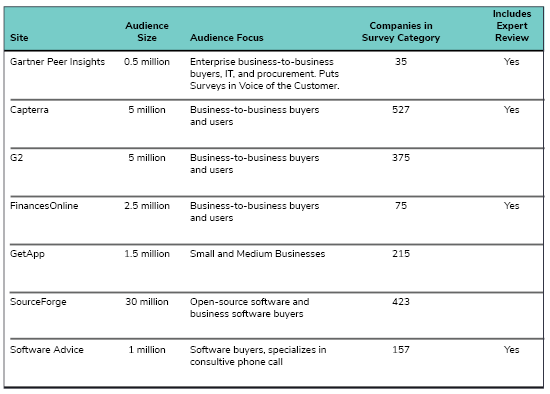
The Analysis
All five sites present the opportunity to compare solutions. However, the proficiency of the peers reviewing on the site can affect how each site rates the solutions. Gartner Peer Insights is connected with Gartner Research and their famous Gartner Magic Quadrant. They place Survey Software in the Voice of the Customer group.
Seasoned market researchers also migrate to Capterra and G2 to find new solutions when they’ve outgrown or become dissatisfied with their current solutions. If you are looking for peer reviews for an enterprise-class solution or one that can scale up to large enterprise installations, these sites are very popular.
FinancesOnline combines an expert analysis of solutions combined with peer reviews. Since the experts review the different software in a category, they have the advantage of seeing the best in each solution. When you combine this with peer reviews, you get a well-rounded approach that is well received in the market.
SourceForge and GetApp are more aligned with small and medium-sized businesses, especially those looking for new solutions. This is a great place to find peers who are looking for specific solutions to a need. SourceForge tends to have more of a do-it-yourself and technical audience since the site’s roots are in open-source software.
Software Advice is particularly good if you’re not sure what you need in a specific solution because you can get on a call with a consultant who talks with you about your needs and then helps you find the best solution.
If you’re looking for what market researchers find most important in a solution, read The 2022 Buyer’s Guide to Market Research Software . This will help you frame how you look at the different review sites.
Here are some examples of the kind of reviews you can expect.
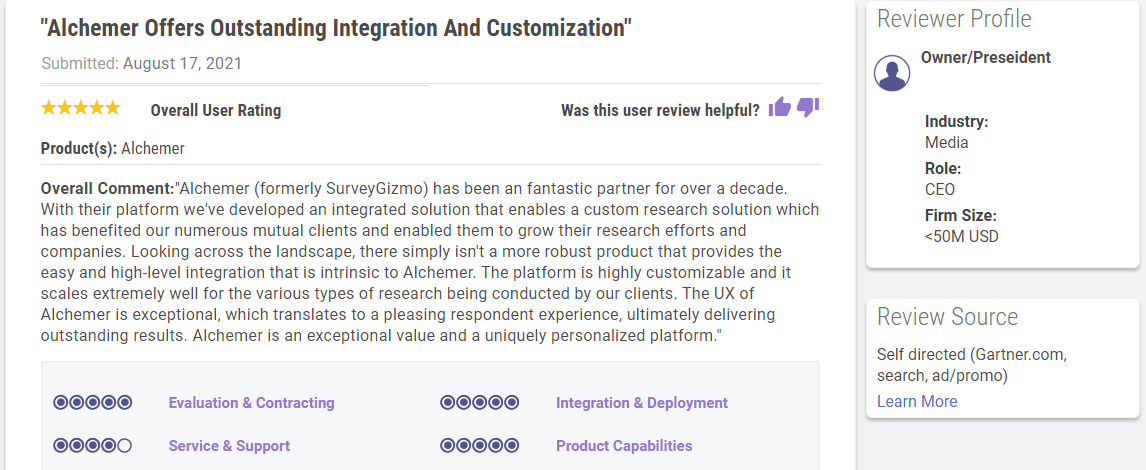
See all blog posts >

- Alchemer Digital , Customer Emotion & Sentiment

- Alchemer Digital , Alchemer Mobile , Customer Experience , Loyalty & Retention , Product Management

- Company News , Press Release
See it in Action

- Privacy Overview
- Strictly Necessary Cookies
- 3rd Party Cookies
This website uses cookies so that we can provide you with the best user experience possible. Cookie information is stored in your browser and performs functions such as recognising you when you return to our website and helping our team to understand which sections of the website you find most interesting and useful.
Strictly Necessary Cookie should be enabled at all times so that we can save your preferences for cookie settings.
If you disable this cookie, we will not be able to save your preferences. This means that every time you visit this website you will need to enable or disable cookies again.
This website uses Google Analytics to collect anonymous information such as the number of visitors to the site, and the most popular pages.
Keeping this cookie enabled helps us to improve our website.
Please enable Strictly Necessary Cookies first so that we can save your preferences!
Reference management. Clean and simple.
The top list of academic research databases

2. Web of Science
5. ieee xplore, 6. sciencedirect, 7. directory of open access journals (doaj), get the most out of your academic research database, frequently asked questions about academic research databases, related articles.
Whether you are writing a thesis , dissertation, or research paper it is a key task to survey prior literature and research findings. More likely than not, you will be looking for trusted resources, most likely peer-reviewed research articles.
Academic research databases make it easy to locate the literature you are looking for. We have compiled the top list of trusted academic resources to help you get started with your research:
Scopus is one of the two big commercial, bibliographic databases that cover scholarly literature from almost any discipline. Besides searching for research articles, Scopus also provides academic journal rankings, author profiles, and an h-index calculator .
- Coverage: 90.6 million core records
- References: N/A
- Discipline: Multidisciplinary
- Access options: Limited free preview, full access by institutional subscription only
- Provider: Elsevier

Web of Science also known as Web of Knowledge is the second big bibliographic database. Usually, academic institutions provide either access to Web of Science or Scopus on their campus network for free.
- Coverage: approx. 100 million items
- References: 1.4 billion
- Access options: institutional subscription only
- Provider: Clarivate (formerly Thomson Reuters)
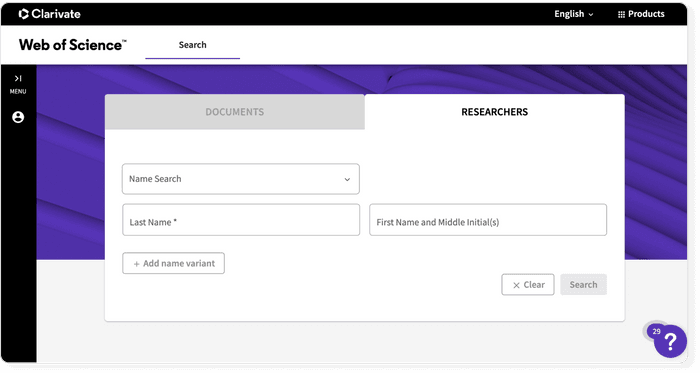
PubMed is the number one resource for anyone looking for literature in medicine or biological sciences. PubMed stores abstracts and bibliographic details of more than 30 million papers and provides full text links to the publisher sites or links to the free PDF on PubMed Central (PMC) .
- Coverage: approx. 35 million items
- Discipline: Medicine and Biological Sciences
- Access options: free
- Provider: NIH
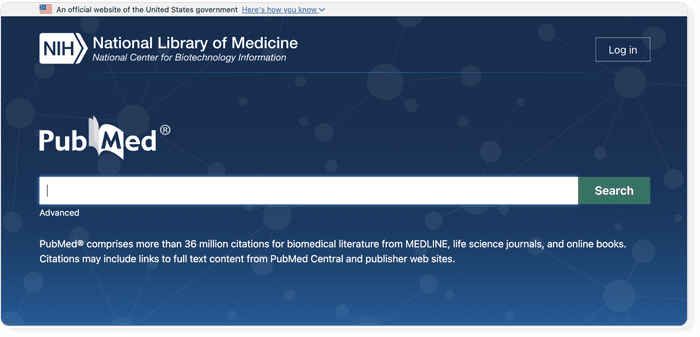
For education sciences, ERIC is the number one destination. ERIC stands for Education Resources Information Center, and is a database that specifically hosts education-related literature.
- Coverage: approx. 1.6 million items
- Discipline: Education
- Provider: U.S. Department of Education

IEEE Xplore is the leading academic database in the field of engineering and computer science. It's not only journal articles, but also conference papers, standards and books that can be search for.
- Coverage: approx. 6 million items
- Discipline: Engineering
- Provider: IEEE (Institute of Electrical and Electronics Engineers)
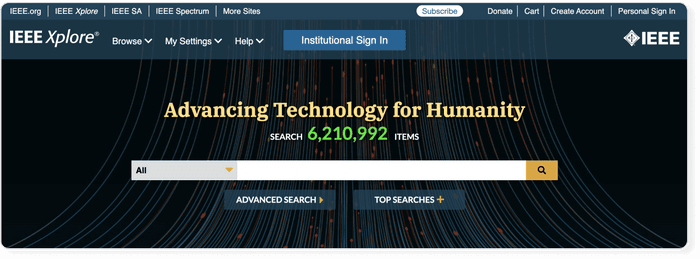
ScienceDirect is the gateway to the millions of academic articles published by Elsevier, 1.4 million of which are open access. Journals and books can be searched via a single interface.
- Coverage: approx. 19.5 million items
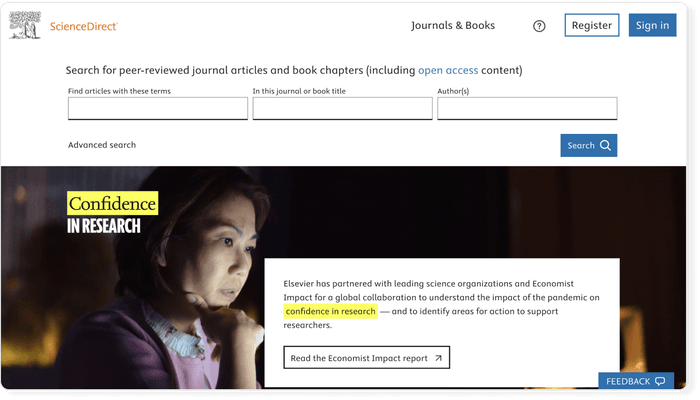
The DOAJ is an open-access academic database that can be accessed and searched for free.
- Coverage: over 8 million records
- Provider: DOAJ

JSTOR is another great resource to find research papers. Any article published before 1924 in the United States is available for free and JSTOR also offers scholarships for independent researchers.
- Coverage: more than 12 million items
- Provider: ITHAKA
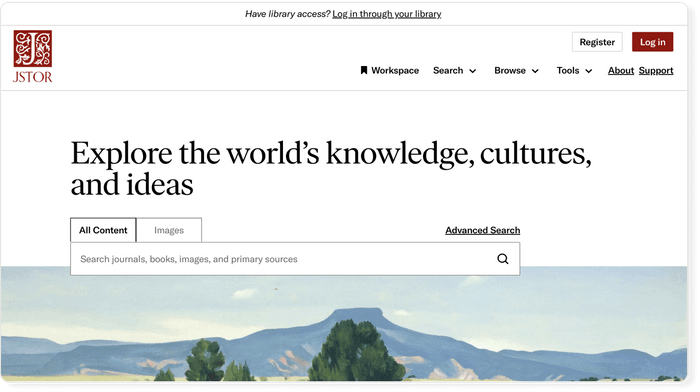
Start using a reference manager like Paperpile to save, organize, and cite your references. Paperpile integrates with PubMed and many popular databases, so you can save references and PDFs directly to your library using the Paperpile buttons:
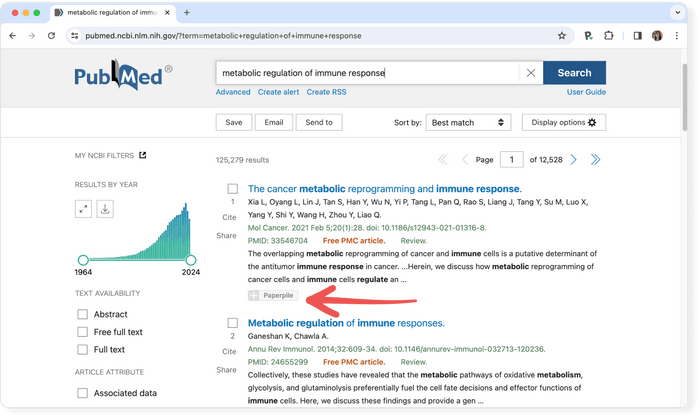
Scopus is one of the two big commercial, bibliographic databases that cover scholarly literature from almost any discipline. Beside searching for research articles, Scopus also provides academic journal rankings, author profiles, and an h-index calculator .
PubMed is the number one resource for anyone looking for literature in medicine or biological sciences. PubMed stores abstracts and bibliographic details of more than 30 million papers and provides full text links to the publisher sites or links to the free PDF on PubMed Central (PMC)

Top Web Hosting Companies for Growing Websites & Businesses
May 16, 2024
Our content is reader-supported . If you click on our links, we may earn a commission. How we review .
Starting a website is easier than ever. All you need is a domain name and web hosting. Though there are thousands of website hosts in the market, most of them aren’t worth your time. Before you decide which one to go with, let’s compare the best web hosts ⇣ on the market right now.
Key Takeaways:
Look for a web hosting company that offers reliable uptime and speedy loading times, as this can have a significant impact on your website’s user experience and search engine ranking.
Compare different hosting plans to find one that meets your website’s specific needs and scale as your site grows.
Read reviews from other users to get a sense of a company’s customer support, security features, and overall reputation within the industry.
But that doesn’t mean all website hosts are the same. There are some that are the best on the internet. Not only do they offer amazing support, but they are also good cheap web hosting services that make it easy for you to launch and manage your website.
Best Web Hosting: Our Shortlist

SiteGround stands out in the web hosting industry - they're not just about hosting your website but about enhancing your site's performance, security, and management. SiteGround's hosting package blends advanced technology and user-friendly features, ensuring your website operates at its best. Get premium website performance with Ultrafast PHP, optimized db setup, built-in caching & more! The ultimate hosting package with free email, SSL, CDN, backups, WP auto-updates, and much more.

Powering over 2 million sites on the Internet, Bluehost offers the ultimate web hosting for WordPress sites. Tuned for WordPress, you get WordPress-centric dashboards and tools along with 1-click installation, a FREE domain name, email, AI website builder + lots more. Whether you're starting a blog, running a business website, or setting up an online store, Bluehost's WordPress-focused hosting provides the tools and resources you need to succeed online.

Hostinger is highly regarded for its user-friendly and responsive custom hPanel, offering an intuitive and well-organized interface for managing web hosting features. The platform's shared hosting plans are lauded for their affordability and comprehensive features, including free SSL certificates, 1-click app installations, and tools for seamless website import and migration. Plans come with perks like free domain names and automatic daily backups. Performance-wise, Hostinger boasts impressive load times and a recent uptrend in reliability, positioning it as a competitive choice for those seeking feature-rich, yet budget-friendly web hosting solutions.

Cloudways m anaged WordPress hosting is renowned for its high performance, offering a user-friendly platform with extensive control over hosting elements like server selection, data center location, and cloud provider. It simplifies WordPress installations and boosts site speed with features like multisite installs, WooCommerce setups, CloudwaysCDN, and the Breeze plugin. Speed and security are robust, including Cloudflare Enterprise caching, SSL certificates, 'Bot Protection,' and SafeUpdates for safely testing WordPress changes.

GreenGeeks web hosting is recognized for its commitment to eco-friendly hosting, delivering high-speed, secure, and WordPress-optimized services. Their plans include a free domain name, website migrations, SSD storage, and LiteSpeed technology. Users benefit from GreenGeeks' 24/7 expert support and AI-powered performance optimizations, ensuring a smooth and responsive web experience. The platform is known for its environmentally responsible approach, offsetting three times its energy consumption with wind energy credits, and partnering with organizations to plant trees for each new hosting account.
Top Web Hosting Companies: Full List
Here I break down the best website hosting services in terms of features and price so that you have all the information you need to find the best web host to launch your website or online store.
At the end of this list, I also highlight three of the worst website hosts in 2024 that I strongly recommend you stay well clear of.
1. SiteGround (Best speed and security features)

Price: From $2.99 per month
Hosting Types: Shared, WordPress, WooCommerce, Cloud, Reseller
Performance : Ultrafast PHP, HTTP/2 and NGINX + SuperCacher caching. SiteGround CDN 2.0. Free SSH and SFTP Access
WordPress Hosting : Managed WordPress hosting. Easy WordPress 1-click installation. Officially recommended by WordPress.org
Servers: Google Cloud Platform (GCP)
Extras: On-demand backups. Staging + Git. White-labelling. WooCommerce integration
Current Deal: Get up to 83% OFF SiteGround's plans
Website: www.siteground.com
Siteground is one of the most popular hosts on the internet. They are trusted by thousands of businesses around the world.
- Friendly customer support team available 24/7.
- Trusted by thousands of businesses around the world.
- Free WordPress website migration on all plans.
- Powerful speed tools and performance features
- Hosted on Google Cloud infrastructure
- 30-day money-back guarantee
The best part about hosting your site with Siteground is that their friendly support team is available around the clock to answer your questions. It takes less than 2 minutes to get in touch with them through Live Chat. They will help you out if you get stuck anywhere in the process of starting your site.
If you already have your website hosted on some other web host, you don’t have to worry about spending hours migrating your site to Siteground. They offer a free site migration service for WordPress sites.
For non-WordPress sites and for those who want expert help transferring sites. SiteGround’s professional site migration service is done by experts and costs $30 per website.
- Affordable prices for beginners and small businesses.
- Unlimited email on all plans.
- Free daily automated backups on all plans.
- Free website migration service.
- Live chat support & telephone support from industry experts.
- Google Cloud shared VPS infrastructure.
- Renewal prices are much higher than first-time prices.
- No unlimited storage.
Visit SiteGround.com
… or read my detailed SiteGround review
2. Bluehost (Best beginner-friendly hosting in 2024)

Price: From $2.95 per month
Hosting Types: Shared, WordPress, VPS, Dedicated
Performance : PHP8, HTTP/2, NGINX+ Caching. Free CDN. Free backups
WordPress Hosting : Managed WordPress hosting. Easy WordPress 1-click installation. Online store builder. Officially recommended by WordPress.org
Servers: Fast SSD drives on all hosting plans
Extras: Free domain name for 1 year. $150 Google Ads credits. Custom WP themes
Current Deal: Get up to 75% off on hosting
Website: www.bluehost.com
Bluehost is one of the most popular hosts on the Internet. They are one of the only few officially recommended web hosts on the official site for WordPress (the most popular content management system used by millions of websites).
- Free domain name on annual plans.
- 24/7 customer support teams.
- Free Content Delivery Network
They are not only one of the most popular but also one of the most affordable on the market. They are known for their amazing support team and have won many awards for their 24/7 available customer support. If you ever get stuck in the process of starting your site, you can reach them at any time via email, live chat, or phone.
* The Choice Plus plan renews at $19.99/mo, and the Online Store plan renews at $24.95/mo.
- Affordable prices for small businesses (#1 best hosting option for a small business site)
- Easily scalable and WordPress for website creation tools.
- Award-Winning Customer Support team available 24/7.
- Best shared hosting company in 2024
- The renewal prices are higher than the starting prices.
- The domain name is only free for one year.
- Owned by Newfold Digital (expect lots of upselling)
Visit Bluehost.com
… or read my detailed Bluehost review
3. Hostinger (Cheapest web hosting you can get)

Hosting Types: Shared, WordPress, Cloud, VPS, Minecraft hosting
Performance : LiteSpeed, LSCache caching, HTTP/2, PHP8
WordPress Hosting : Managed WordPress hosting. Easy WordPress 1-click installation
Servers: LiteSpeed SSD hosting
Extras: Free domain. Google Ads credit. Free website builder
Current Deal: Get 75% OFF Hostinger's plans
Website: www.hostinger.com
Hostinger has made a name for itself by offering the cheapest web hosting packages in the industry. You can’t possibly find a web host that offers cheaper prices without losing quality.
- Cheapest prices on the market
- Free SSL certificates for all domains
- Free email accounts on all plans
- LiteSpeed powered servers
Their cheapest plans are great for anyone just starting out. The best part is Hostinger makes it very easy to scale your websites with simple plans that you can upgrade at any time.
Even though their pricing starts at From $2.99 per month (when you sign up for 48 months) they offer 24/7 support and are trusted by thousands of businesses around the world.
- Cheap web hosting is one of the most affordable prices on the market.
- Free SSL certificates on all domain names.
- 24/7 online support.
- Great for beginners who are just starting out.
- Great for other types of hosting like Minecraft servers .
- Free SSL is not included for addon domains.
- Renewal prices are much higher than starter prices.
Visit Hostinger.com
… or read my detailed Hostinger review
4. DreamHost (Best flexible pricing option)
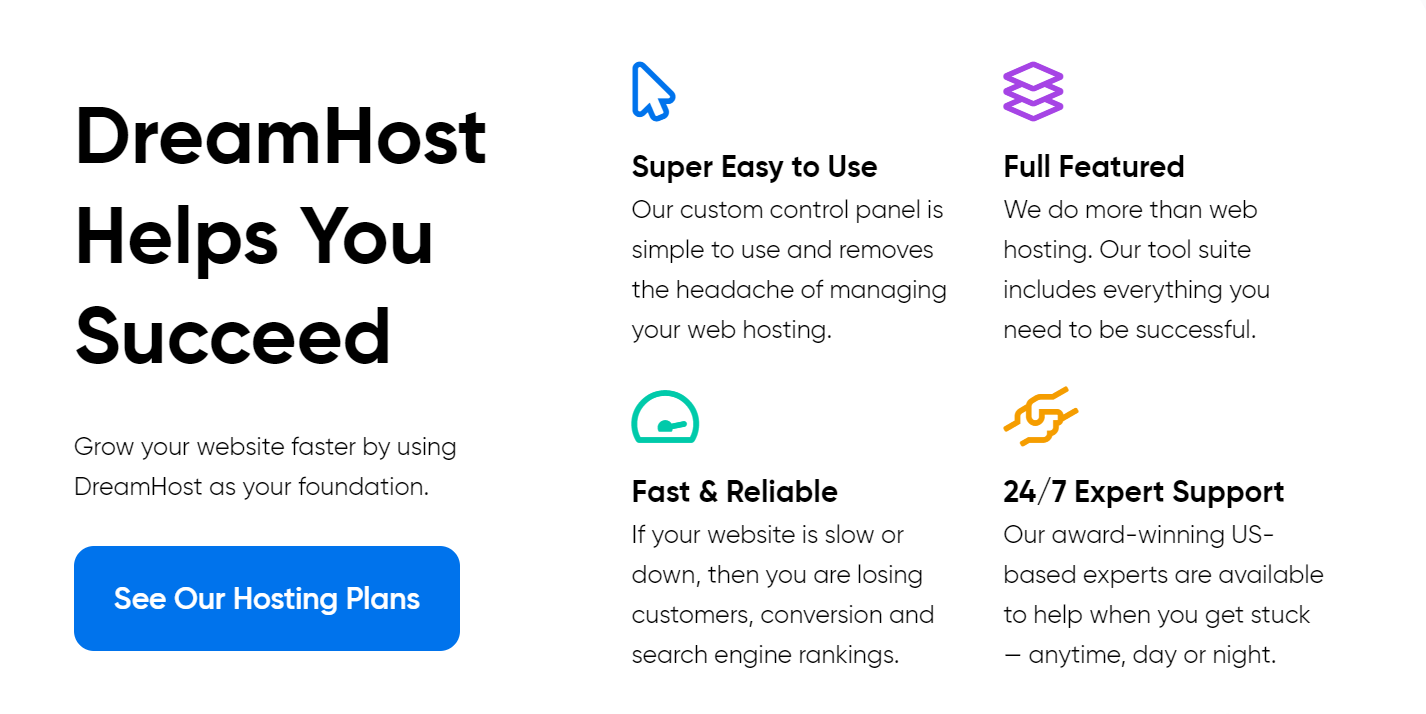
Price: From $2.59 per month
Hosting Types: Shared, WordPress, Cloud, VPS, Dedicated
Performance : HTTP/2, SSD, latest PHP and propriety built-in server caching
WordPress Hosting : Managed WordPress hosting. Easy WordPress comes pre-installed. Free site migration. Officially recommended by WordPress.org
Servers: Fast loading SSD drives
Extras: Free domain name for 1 year, incl. WHOIS privacy
Current Deal: Get started with DreamHost now! Save up to 79%
Website: www.dreamhost.com
DreamHost is one of the most popular choices among professional bloggers and small businesses. They offer affordable web hosting for businesses of all shapes and sizes. Over 1.5 million websites rely on DreamHost.
- 24/7 support via phone, email, and live chat.
- Free domain name with privacy on all plans.
- Flexible and worry-free month-to-month hosting, pay monthly and cancel anytime (no need to sign up for a 12/24/36 months plan).
- Free automated WordPress migrations on all plans.
- 97-day money-back guarantee.
If this is your first time launching a new website, don’t worry. DreamHost offers a 97-day money-back guarantee. You can ask for a refund within the first 97 days of service if you are unhappy with the service for any reason.
DreamHost offers a free domain name on all plans with free domain privacy, which others charge extra for. Domain registration information is publicly available and searchable by anyone. Domain privacy makes this information private.
- Free domain name on all plans.
- Free automated WordPress migration.
- 24/7 customer support.
- Free automated daily backups on all plans.
- No free email accounts on the Starter plan.
Visit DreamHost.com
… or read my detailed DreamHost review
5. Hostgator (Free website builder included)

Price: From $3.75 per month
Hosting Types: Shared, WordPress, VPS, Dedicated, Reseller
Performance : HTTP/2, NGINX Caching. Cloudflare CDN, Increased performance (3 vCPU's)
Extras: Free 1-year domain. Free website builder. Free website transfer
Current Deal: Get 70% OFF HostGator's plans
Website: www.hostgator.com
HostGator is one of the oldest and most popular web hosting companies on the Internet. They are trusted by thousands of business owners around the world. Hostgator is known for its shared web hosting and WP hosting services, but they also offer VPS and Dedicated Hosting.
- Free email on all plans.
- One of the best web hosting services for anyone just starting out.
- Unmetered disk space and bandwidth data transfers.
- 24/7 customer support you can reach via live chat.
Hostgator’s affordable plans are designed to scale your business. They all offer unmetered bandwidth and disk space. They also offer a 45-day money-back and uptime guarantee on all plans. And unlike a lot of other web hosting providers, they offer free email on all their plans.
- 45-day money-back guarantee
- Free email hosting on all plans. Get an email on your own domain name for free
- Free domain name on all plans for the first year
- Free automated daily backups you can restore at any time with a single click
Visit HostGator.com
… or read my detailed HostGator review
6. A2 Hosting (Best value for money option)

Performance :
Servers: LiteSpeed. NVMe SSD Storage
Extras: Anycast DNS. Dedicated IP address. Free site migration. Built-in staging
Current Deal: Use code webrating51 & get 51% OFF
Website: www.a2hosting.com
A2 Hosting offers affordable web hosting solutions to small businesses around the world. Whether you are in the process of starting your first site or own a business that gets thousands of visitors every day, A2 Hosting has the right solution for you. They offer everything from shared hosting to dedicated hosting.
- 24/7 support.
- 4 different data center locations to choose from.
- Free website migration service provided.
- LiteSpeed powered servers.
A2 Hosting gives you free email accounts on all plans and a free CDN service for all your websites. They also offer a free website migration service in which they migrate your website from any other web host to your A2 Hosting account for free without any downtime.
- Impressive speed and performance features on Turbo plans (powered by LiteSpeed)
- Free email accounts on your domain name on all plans.
- Free CDN on all plans to give your website a speed boost.
- Free website migration service on all plans.
- Free automated backups are not available on the starter plan.
Visit A2Hosting.com
… or read my detailed A2 Hosting review
7. GreenGeeks (Best LiteSpeed server hosting)

Hosting Types: Shared, WordPress, VPS, Reseller
Performance : LiteSpeed, LSCache caching, MariaDB, HTTP/2, PHP8
Servers: Solid state RAID-10 storage (SSD)
Extras: Free domain name for 1 year. Free website migration service
Current Deal: Get 70% OFF on all GreenGeeks plans
Website: www.greengeeks.com
GreenGeeks is popular for its green web hosting services. They were one of the first in the market to introduce green web hosting. Their servers run on green energy to reduce their carbon footprint. Hosting your website with GreenGeeks is the easiest way to reduce your carbon footprint.
- One of the few green website hosts on the internet.
- Private servers that run on green energy to reduce carbon footprint.
- Affordable prices for premium services trusted by businesses around the world.
- 30-day money-back guarantee.
GreenGeeks web hosting services offer free CDN service on all their plans. They also offer a free-of-charge domain name for the first year on all plans. The best part about GreenGeeks’ service is that their tech-savvy support team is available around the clock and will help you out whenever you get stuck with anything at all.
- Free email accounts on all plans.
- Eco-friendly “green” web hosting at affordable prices.
- 24/7 online support can reach via live chat, phone, and email.
- Free CDN to give your website a boost.
- Free-of-charge domain name on all plans for the first year.
Visit GreenGeeks.com
… or read my detailed GreenGeeks review
8. Scala Hosting (Cheapest cloud VPS hosting)
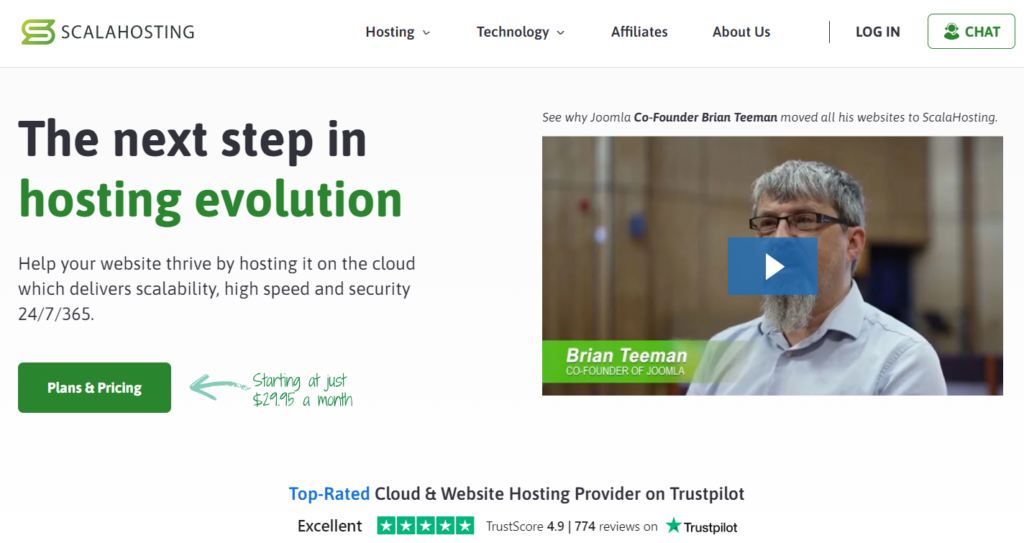
Price: From $29.95 per month
Hosting Types: Cloud VPS, Shared, WordPress
Performance : LiteSpeed, LSCache caching, HTTP/2, PHP8, NvME
WordPress Hosting : Managed WordPress cloud VPS hosting. WordPress comes preinstalled
Servers: LiteSpeed, SSD NvME. DigitalOcean & AWS data centers
Extras: Free website migration. Free domain name. Dedicated IP address
Current Deal: Save Up To 57% (No Setup Fee)
Website: www.scalahosting.com
Scala Hosting makes it easy for small businesses to build their websites on VPS Hosting. They offer Fully Managed VPS Hosting that removes the pain of maintenance and management from it.
- Fully Managed VPS Hosting at affordable prices.
- Most affordable cloud VPS service on the market.
- Free website migration from any other platform at no cost.
- Free custom control panel called SPanel.
With Scala Hosting, you can give your site a speed boost by hosting it on a VPS without having to learn any technical commands and codes to manage the server.
Although they are known for their Managed VPS Hosting, they also offer other services such as WP Hosting, Shared Hosting, and Unmanaged Hosting (VPS). Their support team is available 24/7 to help you get unstuck and answer any questions you might have.
- Free automated daily backups.
- Cloud VPS for the price of shared hosting.
- LiteSpeed powered Turbo-fast NVMe SSDs.
- Automated 2 free VPS snapshots of the last two days.
- A custom control panel called SPanel saves you money and makes it easy to manage your VPS.
- Generous amounts of resources for affordable prices.
- Virtual private server (VPS) isn’t suited for total beginners.
- A little more expensive than similar providers.
Visit ScalaHosting.com
… or read my detailed Scala Hosting review
9. Rocket.net (Fastest Cloudflare hosting right now)
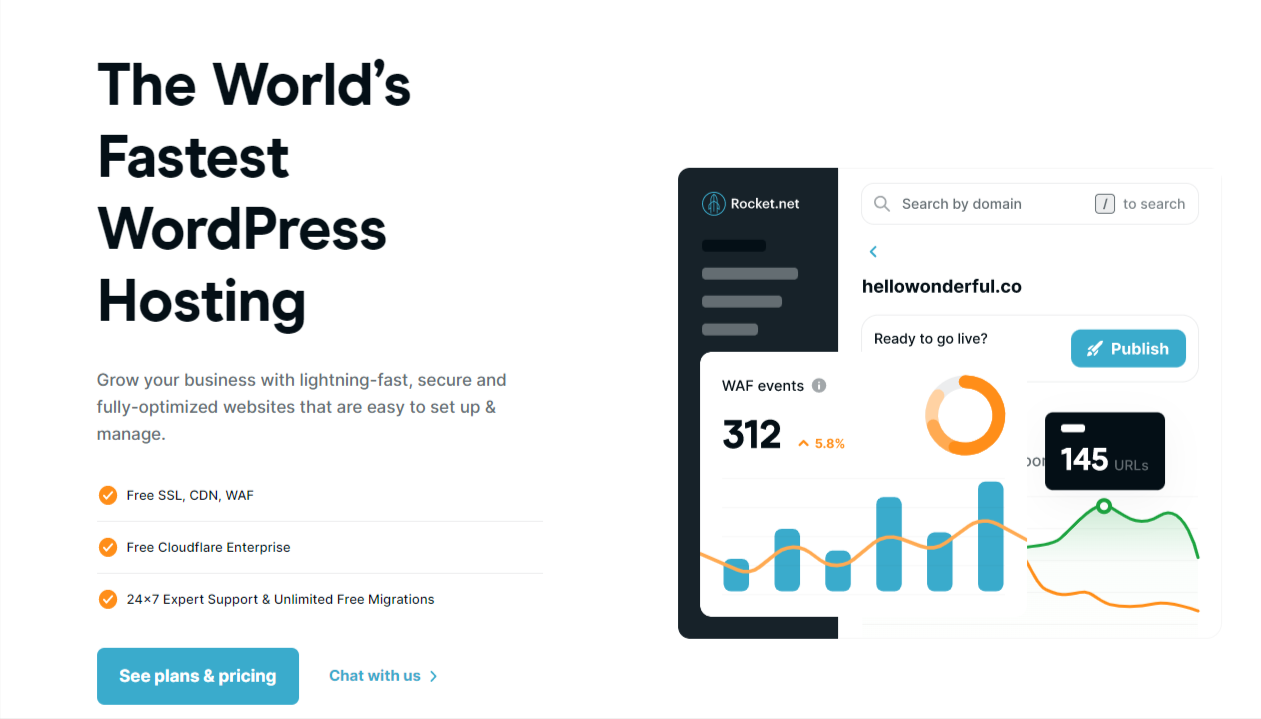
Price: From $25 per month
Hosting Types: WordPress & WooCommerce hosting
Performance : Optimized & delivered by Cloudflare Enterprise. Built-in CDN, WAF and edge caching. NVMe SSD storage. Unlimited PHP Workers. Free Redis & Object Cache Pro
WordPress Hosting : Managed WordPress cloud hosting
Servers: Apache + Nginx. 32+ CPU Cores with 128GB RAM. Dedicated CPU and RAM resources. NVMe SSD disk storage. Unlimited PHP Workers
Extras: Unlimited free site migrations, free automated backups, free CDN & dedicated IP. One-click staging
Current Deal: Ready for speed? Let Rocket do a FREE test migration for you!
Website: www.rocket.net
Rocket.net is a fully-managed WordPress hosting platform that offers high-performance hosting services, excellent security features, and easy website management. With its intuitive dashboard and 24/7 support team, Rocket.net ensures that users can focus on their website content and leave the technical aspects to the experts.
Key Features:
- Managed WordPress Hosting: Rocket.net is a fully-managed WordPress hosting platform that provides users with the ease and flexibility of managing their WordPress websites without worrying about the technical aspects.
- Fast Load Times: With Rocket.net, websites load faster due to its global content delivery network (CDN), which provides high-performance hosting services and reduces load times.
- Security: Rocket.net provides website security features such as malware scans, firewall protection, and automatic updates to keep websites safe and secure.
- Easy to Use: Rocket.net has an intuitive and user-friendly dashboard that allows users to manage their website easily, and its 24/7 support team provides assistance whenever needed.
- Automatic Backups: Rocket.net automatically backs up all website data, which ensures that users can restore their website to a previous version if necessary.
- #1 winner as the fastest WordPress hosting company in our testing
- Fast load times due to its global content delivery network
- Excellent security features to keep websites safe from cyber threats
- User-friendly interface and dashboard make it easy to manage websites
- Automatic backups ensure that website data is always secure
- 24/7 support team available to provide assistance when needed
- Limited flexibility in terms of customizing the hosting environment
- Higher pricing compared to other hosting providers
- Limited storage and bandwidth options for smaller plans.
Starter plan: $25/month when billed annually
- 1 WordPress site
- 250,000 monthly visitors
- 10 GB storage
- 50 GB bandwidth
Pro plan: $50/month when billed annually
- 3 WordPress sites
- 1,000,000 monthly visitors
- 20 GB storage
- 100 GB bandwidth
Business plan: $83/month when billed annually
- 10 WordPress sites
- 2,500,000 monthly visitors
- 40 GB storage
- 300 GB bandwidth
Expert plan: $166/month when billed annually
- 25 WordPress sites
- 5,000,000 monthly visitors
- 50 GB storage
- 500 GB bandwidth
Visit Rocket.net
… or read my detailed Rocket.net review
10. Cloudways (Cheapest cloud hosting)
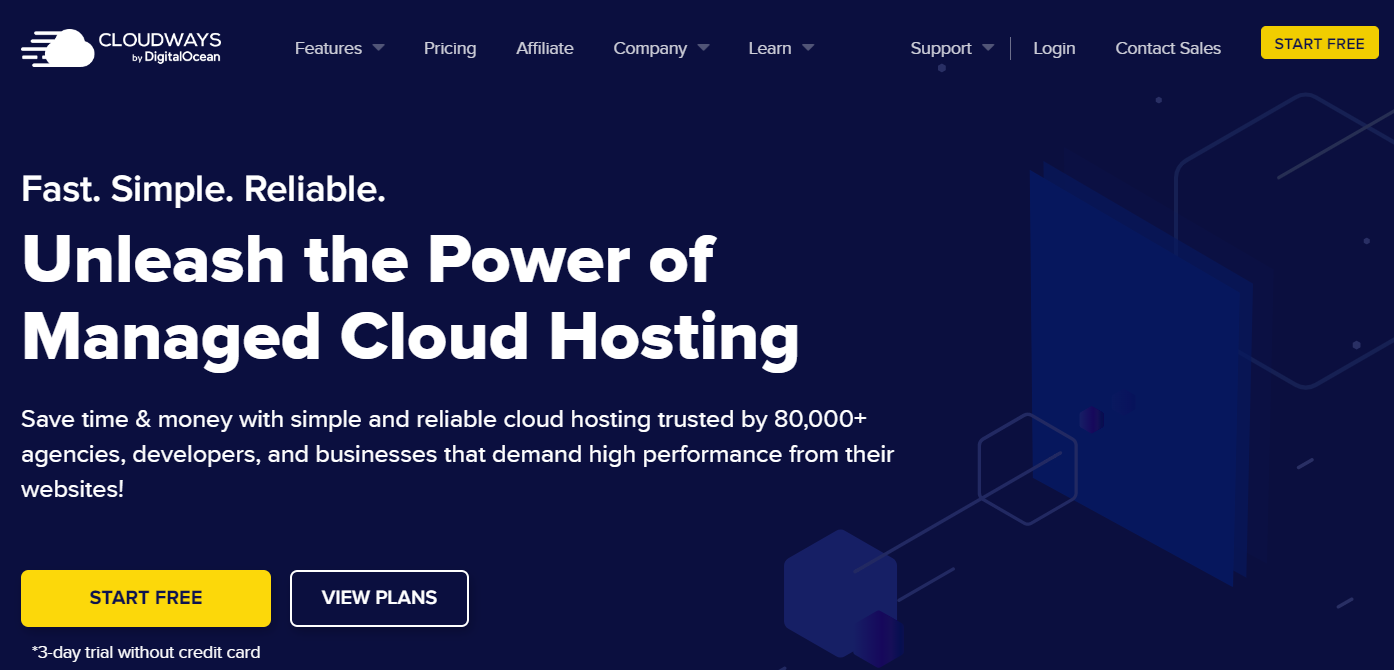
Price: From $11 per month
Hosting Types: Managed Cloud Hosting
Performance : NVMe SSD, Nginx/Apache servers, Varnish/Memcached caching, PHP8, HTTP/2, Redis support, Cloudflare Enterprise
WordPress Hosting : 1-click unlimited WordPress installations & staging sites, pre-installed WP-CLI and Git integration
Servers: DigitalOcean, Vultr, Linode, Amazon Web Services (AWS), Google Cloud Platform (GCP)
Extras: Free site migration service, free automated backups, SSL certificate, free CDN & dedicated IP
Current Deal: Get 10% OFF for 3 months using code WEBRATING
Website: www.cloudways.com
Cloudways offers fully managed VPS Hosting. They remove the management and maintenance part of Hosting that limits a lot of businesses from using them. The best part about Cloudways is that they let you pick between 5 different cloud hosting platforms including Google, AWS, and Digital Ocean.
- Affordable fully managed VPS hosting plans.
- Dozens of data centers to choose from.
- 5 different cloud hosting platforms to choose from.
- Cloud hosting plans using DigitalOcean servers start from From $11 per month
The choice of cloud platforms also increases your choice of data center locations. You can choose to host your website in any of the dozens of data center locations available.
If you already have your website hosted on some other platform or web host, Cloudways will migrate your website to your Cloudways account for free.
- Fully managed VPS hosting service that can give your website a speed boost.
- Choose between 5 different cloud hosting platforms that are trusted by some of the biggest tech companies in the world.
- 24/7 support to solve all your problems.
- No cPanel or a custom control panel such as SPanel is offered by Scala Hosting.
- No free CDN.
Visit Cloudways.com
… or read my detailed Cloudways review
11. Kinsta (Fastest Google Cloud hosting right now)
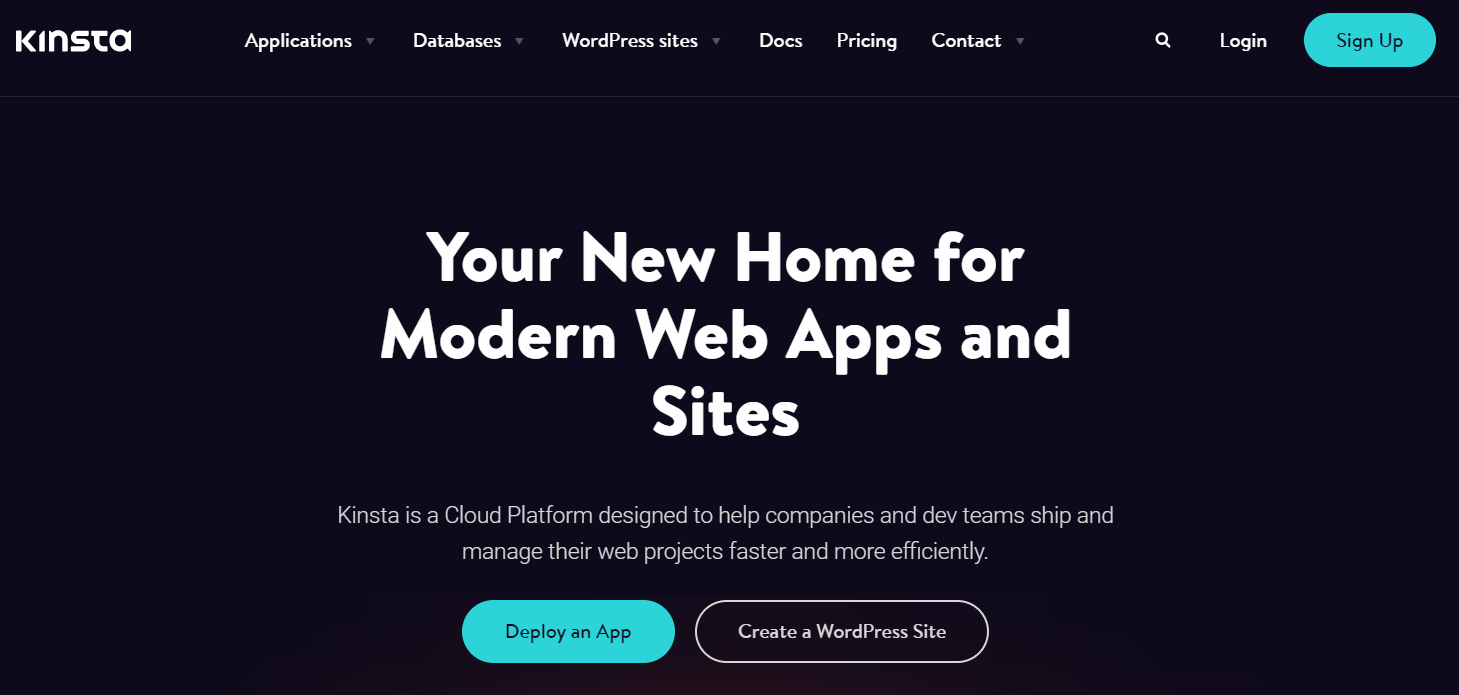
Price: From $35 per month
Hosting Types: WordPress & WooCommerce Hosting. Application Hosting & Database Hosting
Performance : Nginx, HTTP/2, LXD containers, PHP 8.0, MariaDB. Edge caching. Cloudflare CDN incl. Early Hints
WordPress Hosting : Fully managed and optimized self-healing technology for WordPress
Extras: Free premium migrations. Self-healing technology, Automatic DB optimization, Hack and malware removal. WP-CLI, SSH, Git, built-in Application Performance Monitoring Tool
Current Deal: Pay yearly & get 2 months of FREE hosting
Website: www.kinsta.com
Kinsta offers premium managed WP hosting services for businesses of all shapes and sizes. Unlike other companies, Kinsta specializes in WP Hosting. If you want your website to perform as fast as it can, you need Kinsta.
- Free CDN service on all plans.
- Free unlimited migrations from other web hosts.
- Google Cloud Platform powered servers.
- 24 global data center locations to choose from.
Their servers are optimized for WordPress performance and they offer free CDN service on every plan.
The best part about hosting your website with Kinsta is the easy scalability you get. Your website can go from 10 visitors a day to a thousand on Kinsta without any hiccups. You can upgrade your website’s plan at any point with just a click.
Kinsta is powered by the Google Cloud Platform which is trusted by millions of businesses large and small around the world. It is the same infrastructure used by tech giants.
- Cloud hosting plans powered by Cloud (Google) Platform.
- Free automatic daily backups you can restore with a single click.
- Free premium migration of your website and unlimited basic migrations.
- Can be a little expensive for small businesses.
- No email hosting.
Visit Kinsta.com
… or read my detailed Kinsta review
12. WP Engine (Best premium managed WordPress hosting)

Price: From $20 per month
Hosting Types: Managed WordPress & WooCommerce Hosting
Performance : Dual Apache and Nginx, HTTP/2, Varnish & Memcached server and browser caching, EverCache®
WordPress Hosting : WordPress is auto-installed. Automatic WordPress core updates. WordPress staging
Servers: Google Cloud, AWS (Amazon Web Services), Microsoft Azure
Extras: Free Genesis StudioPress themes. Daily and on-demand backups. Free migration service. One-click staging. Smart Plugin Manager
Current Deal: Limited special offer - Get $120 off annual plans
Website: www.wpengine.com
WP Engine is a premium managed WP hosting company trusted by some of the biggest websites on the internet. They are one of the oldest in the industry and have made a name for themselves by providing affordable Managed WordPress solutions.
- Premium managed WP hosting.
- Free global CDN service is included in all plans.
- 24/7 chat support and industry leading customer service.
- Free Genesis Framework and 35+ StudioPress Themes on all plans.
WP Engine can help your business scale on any level, whether you are a hobby blogger or a business that serves thousands of customers every day. Their web hosting solutions are optimized for WordPress websites and as a result, offer a huge boost in speed.
The best part about going with WP Engine WordPress web hosting services is that they offer you the Genesis Theme Framework and 35+ StudioPress themes for free on all plans. Together this bundle would cost well over $2,000 if bought separately.
- Scalable Managed WP hosting at affordable prices.
- Servers that are optimized for WordPress performance and security.
- Genesis Framework and dozens of StudioPress themes are included with every plan.
- Website and database backups.
- A little expensive for beginners.
- Limits pageviews unlike some of their competitors.
Visit WPEngine.com
… or read my detailed WP Engine review
13. InMotion Hosting (Best small business hosting)

Price: From $2.29 per month
Hosting Types: Shared, WordPress, Cloud, VPS, Dedicated, Reseller
Performance : HTTP/2, PHP8, NGINX & UltraStack caching
Servers: Ultra fast and reliable NVMe SSD storage
Extras: Free no-downtime website migrations. Free BoldGrid website builder
Current Deal: Get 50% OFF InMotion Hosting plans
Website: www.inmotionhosting.com
InMotion Hosting is home to over 500,000+ WordPress websites. They offer everything from Shared business hosting to dedicated servers. Their customer support team is available around the clock to help you out with anything when you get stuck.
- Free-of-charge domain name on all plans.
- 90-day money-back guarantees.
They also offer a free website migration service. You can contact the customer support team and they will migrate your website from any other web host to your InMotion account for free without any downtime.
- 90-day money-back guarantee.
- Free SSL certificate for all your domain names.
- 24/7 customer support team you can reach any time via Live Chat, Email, or Phone.
- Doesn’t offer unlimited email addresses on all plans.
- Renewal prices are much higher than the starter prices.
Visit InMotionHosting.com
… or read my detailed In Motion Hosting review
14. Liquid Web (Best WooCommerce hosting)

Price: From $12.67 per month
Hosting Types: WordPress, WooCommerce, Cloud, VPS, Dedicated
Performance : Platform built on PHP8, SSL and Nginx. Nexcess page cache
WordPress Hosting : Managed WordPress hosting
Servers: SSD installed on all servers
Extras: 100% network and power uptime guarantee, site migration service at no extra cost, Heroic Support
Current Deal: Use code WHR40VIP to get 40% OFF
Website: www.liquidweb.com
Liquid Web specializes in fully managed cloud and web hosting services. They let your business harness the power of web hosting services that require a lot of technical knowledge to manage and maintain.
- Affordable Managed Web Hosting.
- Free unlimited email accounts.
- 24/7 online Support.
Their managed offerings include everything from Managed WordPress to Dedicated Servers and Server Clusters and everything in between.
All their WordPress plans come with free iThemes Security Pro and iThemes Sync. You also get Beaver Builder Lite and unlimited email accounts. They even offer a 14-day free trial for their WP hosting service.
- Free unlimited email accounts on all plans.
- Free iThemes Security Pro and iThemes Sync WordPress plugins on all plans.
- Free automatic daily backups on all plans are retained for 30 days.
- Complete access to the server.
- No caps on pageviews/traffic.
- Comes with developer tools such as SSH, Git, and WP-CLI.
- Can be a little expensive for beginners.
Visit LiquidWeb.com
… or read my detailed Liquid Web review
Worst Web Hosts (Stay Away!)
There are a lot of web hosting providers out there, and it can be hard to know which ones to avoid. That’s why we’ve put together a list of the worst web hosting services in 2024, so you can know which companies to steer clear of.

PowWeb is an affordable web host that offers an easy way to launch your first website. On paper, they offer everything you need to launch your first site: a free domain name, unlimited disk space, a one-click install for WordPress, and a control panel.
PowWeb offers only one web plan for their web hosting service. This might look good to you if you’re building your first website. After all, they offer unlimited disk space and have no limits for bandwidth.
But there are strict fair-usage limits on server resources . This means, if your website all of a sudden gets a huge surge in traffic after going viral on Reddit, PowWeb will shut it down ! Yes, that happens! Shared web hosting providers who lure you in with cheap prices shut your website down as soon as it gets a small surge in traffic. And when that happens, with other web hosts, you can simply upgrade your plan, but with PowWeb, there’s no other higher plan.
I would only recommend going with PowWeb if you’re just starting and are building your first website. But even if that’s the case, other web hosts offer affordable monthly plans . With other web hosts, you might need to pay a dollar more every month, but you won’t have to sign up for an annual plan, and you’ll get better service.
One of the only redeeming features of this web host is its cheap price, but to get that price you’ll need to pay upfront for 12 months or more. One thing I do like about this web host is that you get unlimited disk space, unlimited mailboxes (email addresses), and no supposed bandwidth limits.
But it doesn’t matter how many things PowWeb does right, there are just too many poor 1 and 2-star reviews plastered all over the internet about how terrible this service is . All those reviews make PowWeb look like a horror show!
If you are looking for a good web host , I would highly recommend looking elsewhere . Why not go with a web host that’s not still living in the year 2002? Not only does its website look ancient, it still uses Flash on some of its pages. Browsers dropped support for Flash years ago.
PowWeb’s pricing is cheaper than a lot of other web hosts, but it also doesn’t offer as much as those other web hosts. First of all, PowWeb’s service isn’t scalable. They only have one plan . Other web hosts have multiple plans to make sure you can scale your website with just one click. They also have great support.
Web hosts like SiteGround and Bluehost are known for their customer support. Their teams help you out with anything and everything when your website breaks down. I’ve been building websites for the last 10 years, and there’s no way I would ever recommend PowWeb to anyone for any use case. Stay away!

For an affordable price of $4.08 per month, FatCow offers unlimited disk space, unlimited bandwidth, a website builder, and unlimited email addresses on your domain name. Now, of course, there are fair-usage limits. But this pricing is only available if you go for a term longer than 12 months.
Although the pricing seems affordable at a first glance, be aware that their renewal prices are much higher than the price you sign up for . FatCow charges more than twice the sign-up price when you renew your plan. If you want to save money, it would be a good idea to go for an annual plan to lock in the cheaper sign-up price for the first year.
But why would you? FatCow may not be the worst web host in the market, but they are also not the best. For the same price, you can get web hosting that offers even better support, faster server speeds, and more scalable service .
One thing I don’t like or understand about FatCow is that they only have one plan . And even though this plan seems to be enough for someone who’s just starting, it doesn’t seem like a good idea for any serious business owner.
No serious business owner would think that a plan that is suitable for a hobby site is a good idea for their business. Any web host that sells “unlimited” plans is lying. They hide behind legal jargon that enforces dozens and dozens of limits on how many resources your website can use.
So, It begs the question: who is this plan or this service designed for? If it’s not for serious business owners, then is it just for hobbyists and people building their first website?
One good thing about FatCow is that they offer you a free domain name for the first year . The customer support may not be the best available but is better than some of their competitors. There’s also a 30-day money-back guarantee in case you decide you’re done with FatCow within the first 30 days.
Another good thing about FatCow is that they offer an affordable plan for WordPress websites. If you’re a fan of WordPress, there might be something for you in FatCow’s WordPress plans. They are built on top of the regular plan but with some basic features that might be helpful for a WordPress site. Same as the regular plan, you get unlimited disk space, bandwidth, and email addresses. You also get a free domain name for the first year.
If you are looking for a reliable, scalable web host for your business, I wouldn’t recommend FatCow unless they wrote me a million-dollar check. Look, I am not saying they are the worst. Far from it! FatCow may be suitable for some use cases, but if you are serious about growing your business online, I can’t recommend this web host. Other web hosts might cost a dollar or two more every month but offer a lot more features and are much more suitable if you run a “serious” business .
3. Netfirms
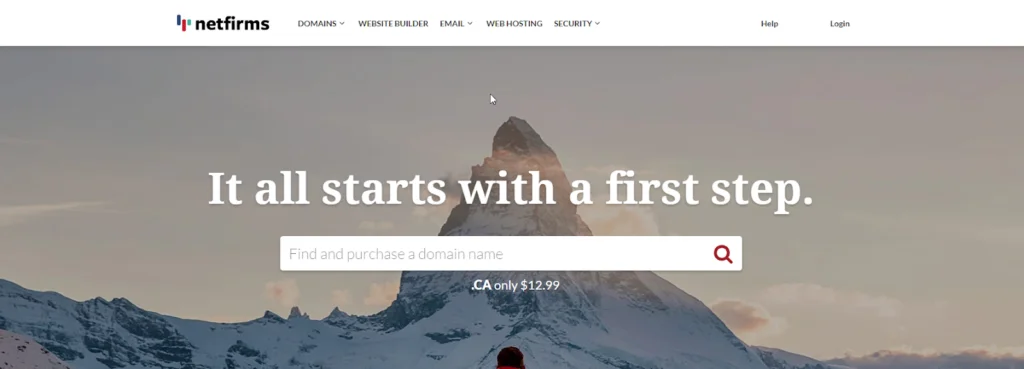
Netfirms is a shared web host that caters to small businesses. They used to be a giant in the industry and were one of the highest web hosts.
If you look at their history, Netfirms used to be a great web host . But they are no longer what they used to be. They got acquired by a giant web hosting company, and now their service no longer seems competitive. And their pricing is just outrageous. You can find better web hosting services for much cheaper prices.
If you still believe for some reason that Netfirms might be worth a try, just look at all the horrible reviews about their service on the internet. According to the dozens of 1-star reviews I’ve skimmed, their support is terrible, and the service has been going downhill ever since they got acquired.
Most Netfirms reviews you’ll read all start the same way. They praise how good Netfirms was about a decade ago, and then they go on to talk about how the service is now a dumpster fire!
If you take a look at Netfirms’ offerings, you’ll notice that they are designed for beginners who are just getting started with building their first website. But even if that’s the case, there are better web hosts that cost less and offer more features.
One good thing about Netfirms plans is how generous they all are. You get unlimited storage, unlimited bandwidth, and unlimited email accounts. You also get a free domain name. But all these features are common when it comes to Shared Hosting. Almost all shared web hosting providers offer “unlimited” plans.
Other than their Shared Web Hosting plans, Netfirms also offer Website Builder plans. It offers a simple drag-and-drop interface to build your website. But their basic starter plan limits you to only 6 pages . How generous! The templates are also really outdated .
If you’re looking for an easy website builder, I wouldn’t recommend Netfirms . Many website builders on the market are much more powerful and offer a lot more features. Some of them are even cheaper…
If you want to install WordPress, they offer an easy one-click solution to install it but they don’t have any plans that are optimized and designed specifically for WordPress sites. Their starter plan costs $4.95 a month but only allows one website. Their competitors allow unlimited websites for that same price.
The only reason I can think of to host my website with Netfirms is if I was being held hostage. Their pricing doesn’t seem real to me. It’s outdated and is much higher when compared to other web hosts. Not only that, their cheap prices are only introductory . That means you’ll need to pay much higher renewal prices after the first term. The renewal prices are twice the introductory sign-up prices. Stay away!
What is Web Hosting?
Web hosting is a type of internet hosting service that allows individuals and organizations to make their website accessible on the Internet (Source: Wikipedia )
A website is simply a set of code files stored on an external computer. When you open a website, your computer sends a request to another computer on the internet called a server for those files and renders that code into a web page.
To start a website, you need a server. But servers are expensive; they cost thousands of dollars to own and maintain. This is where web hosting companies come in. They let you lease a small space on their servers for an affordable fee. This makes web hosting affordable for businesses of all sizes.
Reddit is a great place to learn more about good web hosting options. Here are a few Reddit posts that I think you’ll find interesting. Check them out and join the discussion!
Best hosting reddit guide to picking the best web hosting for wordpress and websites (cheap hosting reddit likes) by u/meyerscarat in EverythingWeb
Best hosting options? by u/uncle_chariot in webhosting
Best web hosting service for beginners/small business by u/Long-Night15 in webhosting
Why Free Web Hosting is Never Worth It
If this is your first time building a website , you might have considered free web hosting platforms. They might sound like a good idea to test the waters. But they are never worth it.
Most free web hosts display adverts on your free website. Not only that, some of them are in the business of collecting your information and selling it to spammers.
The worst part about free web hosts is that they limit your ability to scale. Imagine getting a surge in traffic to your website and finally catching a break. In a scenario like that, your website will probably go down and you will lose hundreds of potential customers.
And that’s not all. Free web hosts don’t much care about security or your data. Don’t believe me? The biggest free web hosting company 000WebHost once got hacked and hackers got access to the information of thousands of users.
Types of Web Hosting
There are many options available, from shared hosting, and VPS hosting to Podcast hosting and Minecraft server hosting , and each caters to different website needs. Don’t rush when choosing, because picking the wrong type of hosting can cause you a lot of problems down the line.
That being said, here is a breakdown of the most used types of web hosting.
- Features: Multiple websites are hosted on a single server, sharing resources such as memory, disk space, and processing power.
- Advantages: Cost-effective, easy to manage (often comes with a control panel like cPanel), and requires no technical maintenance from the user’s side.
- Use Cases: Ideal for small businesses, bloggers, and personal websites with lower traffic volumes.
- Features: A physical server is divided into multiple virtual servers, each with allocated portions of the server’s resources. While sharing a physical server, each VPS functions independently.
- Advantages: Greater control and customization than shared hosting, better performance, and still cost-effective compared to dedicated hosting.
- Use Cases: Suited for medium-sized businesses, e-commerce sites, and websites with moderate traffic that require more resources.
- Features: A single client leases an entire server with all its resources. This offers maximum control, including root access and the choice of operating system.
- Advantages: High performance, security, and stability. No resource sharing with other websites.
- Use Cases: Large businesses, high-traffic websites, and those with specific customization and security requirements.
- Features: Hosting services are offered across a network of interconnected virtual servers, allowing for easy scalability and flexibility.
- Advantages: Highly scalable, reliable (no single point of failure), and you generally pay only for the resources you use.
- Use Cases: Businesses with fluctuating traffic, growth-phase startups, and websites requiring high uptime and scalability.
- Features: The hosting provider takes care of the setup, administration, management, and support of the server and/or application.
- Advantages: Hassle-free hosting with technical aspects handled by experts. Often includes automated backups, updates, and security measures.
- Use Cases: Businesses without a dedicated IT team, those who prefer to focus on their core operations rather than server management.
- Features: Instead of housing servers in-house, they are located in a third-party data center. You own the server but share data center facilities.
- Advantages: Access to higher levels of bandwidth than typical office server rooms, along with professional infrastructure and security.
- Use Cases: Companies that own physical hardware but want the benefits of a professional data center.
- Features: Tailored for software applications, offering hosting services that support various web-based and enterprise applications.
- Advantages: Scalable resources, optimized performance, maintenance and updates handled by the provider, accessible from anywhere.
- Use Cases: Ideal for businesses and developers focusing on SaaS products, mobile app backends, e-commerce apps, and enterprise software without managing server complexities.
Web Hosting Glossary
- Content Delivery Network (CDN): A system that uses multiple servers located in various places to store static parts of your website. This setup helps in delivering content to users more quickly.
- Content Management System (CMS): A software like WordPress that helps you manage the creation and modification of digital content on your website. It often includes tools for designing web pages and adding content.
- Time to First Byte (TTFB): A measurement used to evaluate the performance of a hosting provider. It indicates the time taken for a user’s browser to receive the first byte of page content, reflecting the efficiency of the network and servers.
- Solid-State Disk (SSD): A storage device used in servers and computers, known for its fast data access speeds because it doesn’t have any moving parts, unlike traditional hard drives.
- Non-Volatile Memory Express ( NVMe ): A modern, high-performance SSD technology that provides faster data transfer rates and improved efficiency compared to traditional SSDs.
- Virtual Private Server (VPS): A hosting service where a single physical server is divided into multiple virtual servers. Each virtual server operates independently, providing users with private resources and possibly better performance than shared hosting.
- Domain Name System (DNS): This system translates human-readable domain names (like “example.com”) into IP addresses that computers use to identify each other on the network. DNS ensures that when you type a website’s name into your browser, you are directed to the correct server.
- Shared Hosting: A type of web hosting where multiple websites are stored on a single server. It’s an economical option for small websites, as resources and the cost of the server are shared among all users. However, it might have limitations in performance, security, and flexibility compared to other hosting types.
- Dedicated Hosting: In contrast to shared hosting, dedicated hosting provides a server solely for one client. This offers more control, better performance, and higher security but at a higher cost. It’s suitable for large, high-traffic websites and businesses with specific server requirements.
- Bandwidth: This term refers to the amount of data that can be transferred to and from your website within a certain period, usually a month. Higher bandwidth allows more data to be transferred, which is important for sites with a lot of traffic or large files.
- Secure Sockets Layer (SSL) Certificate: An SSL certificate is a digital certificate that provides secure, encrypted communication between a website and a user’s browser. It’s crucial for protecting sensitive data and is often indicated by a padlock icon in the address bar. Websites with SSL are accessed via HTTPS (Hypertext Transfer Protocol Secure) rather than HTTP.
Go here for more web hosting terms .
Questions and Answers
Our verdict ⭐.
If you want to grow your business without any hiccups, you need reliable web hosting that you can trust. However, most web hosts aren’t worth your time or money.
That’s why I made this list. All the companies on this list get my stamp of approval. If you can’t decide between all the options, let me make the choice easy for you:

Highly popular and well-rated in the WordPress community, SiteGround offers unique WordPress speed and security solutions. Known for the best 24/7 support in the industry, it features automatic upgrades, daily backups, built-in WP caching, free CDN, free SSL, one-click staging, and GIT version control. They have data centers in the USA, Europe, Asia, and Australia.

One of the oldest web hosts since 1996, Bluehost is a large brand in WordPress hosting and is officially recommended by WordPress. Known for its ability to handle high traffic, it offers 24/7 expert support by phone, email, or live chat, and is highly rated for small businesses. Features include a free domain, free SSL, and a free site builder with templates.

Gaining strong recognition in the WordPress hosting industry, Hostinger offers affordable hosting with 24/7 live chat support. Features include automatic 1-click WordPress install, managed updates, enhanced security, free CDN, WordPress speed acceleration, free site migration, and geolocation specific hosting with data centers across various continents.

With 18 years in the industry, DreamHost is known for making web hosting easy with a custom dashboard, 1-click WordPress install, automatic updates, unlimited space and bandwidth, and free SSDs. They power over 1.5 million WordPress blogs and websites and are an officially recommended WordPress hosting provider.
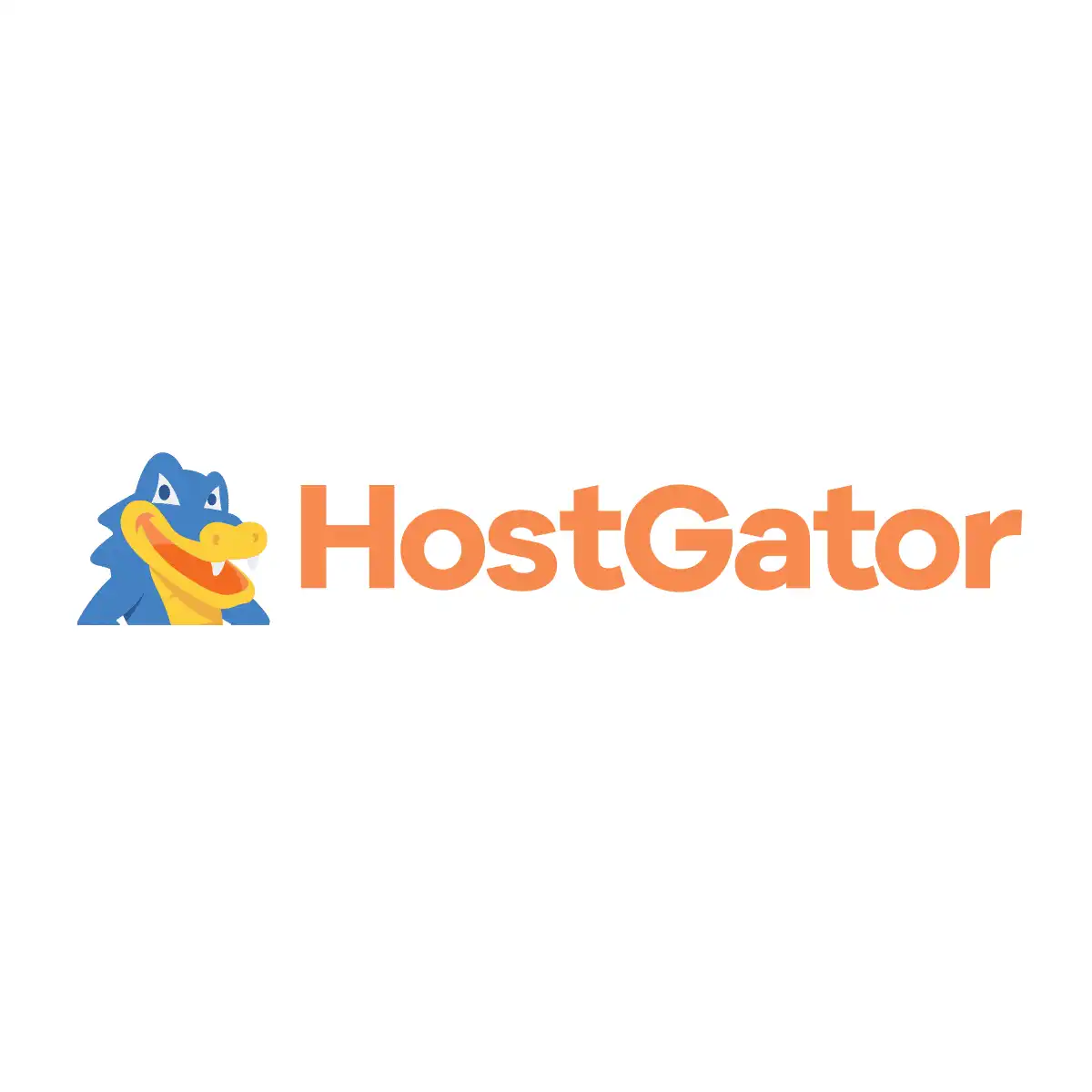
Hosting over 10 million domains, HostGator is popular for its 1-click WordPress installation, 99.9% uptime guarantee, and 24/7 support. They are considered one of the best web hosting services for businesses.

Known for ultra-fast and reliable WordPress hosting since 2002, A2 Hosting is developer-friendly and offers flexibility and advanced features. They provide 24/7/365 support and cater to a range of users from bloggers to large businesses.

Known for its fast website performance and 24/7 U.S. based support, GreenGeeks is an environmentally responsible platform. They offer automatic 1-click WordPress install, managed updates, enhanced security, free CDN, free site migration, and various data center location choices.

Cloudways stands out for its managed cloud hosting services, offering flexibility, performance, and ease of use. It provides users with the ability to choose their cloud provider and supports various applications including WordPress. Cloudways is known for its scalable hosting solutions, 24/7 support, and user-friendly platform, making it a popular choice for both beginners and experienced users.
If you are a beginner, go with Siteground or Bluehost . Both offer 24/7 customer support that is friendly and will help you get unstuck at any time of the day.
If you own a growing WordPress site, I recommend going with WP Engine or Kinsta . Both are known for their affordable premium managed WP hosting services. They offer 24/7 support and are trusted by thousands of big brands around the world.
How We Review Web Hosts: Our Methodology
When we review web hosts, our evaluation is based on these criteria:
- Value for Money : What types of web hosting plans are on offer, and are they good value for money?
- User Friendliness : How user-friendly is the signup process, the onboarding, the dashboard? and so on.
- Customer Support : When we need help, how quickly can we get it, and is the support effective and helpful?
- Hosting Features : What unique features does the web host provide, and how do they stack up against competitors?
- Security : Are essential security measures like SSL certificates, DDoS protection, backup services, and malware/virus scans included?
- Speed and Uptime : Is the hosting service fast and reliable? What types of servers do they use, and how do they perform in tests?
For more details on our review process, click here .
List of web hosting services we have tested and reviewed:
- Scala Hosting
- InMotion Hosting
- WPX Hosting
SiteGround versus Bluehost
Related Posts
- How Your Web Hosting Choice Impacts SEO
- How To Sign Up With HostGator Hatchling Plan?
- The Best Cloud Storage for Photos & Videos
- Is Hostinger Good For Minecraft Server Hosting?
- How to Hire Django Developers from Toptal
- 5 Best No-Log VPNs (and 2 VPNs To Absolutely Avoid)
- The Top 20 Non-Fungible Tokens (NFT) Statistics
- How to Create a Wedding Website with Wix
About Author
Matt Ahlgren
Mathias Ahlgren is the CEO and founder of Website Rating, steering a global team of editors and writers. He holds a master's in information science and management. His career pivoted to SEO after early web development experiences during university. With over 15 years in SEO, digital marketing, and web developmens. His focus also includes website security, evidenced by a certificate in Cyber Security. This diverse expertise underpins his leadership at Website Rating.
The "WSR Team" is the collective group of expert editors and writers specializing in technology, internet security, digital marketing, and web development. Passionate about the digital realm, they produce well-researched, insightful, and accessible content. Their commitment to accuracy and clarity makes Website Rating a trusted resource for staying informed in the dynamic digital world.
Ibad Rehman
Ibad is a writer at Website Rating who specializes in the realm of web hosting and has previously worked at Cloudways and Convesio. His articles focus on educating readers about WordPress hosting and VPS, offering in-depth insights and analysis in these technical areas. His work is aimed at guiding users through the complexities of web hosting solutions.
Top Password Managers to Keep Your Data Safe
Top Website Builders for Stunning Websites & Profitable Stores
Free Theme + Hosting Service
Plans & Pricing
Documentation
Help & Support
Terms of Service
Visitor Favorites
Best Side Hustles in 2024
How to Start a Blog in 2024
How to Create a Website Free of Cost
ClickFunnels Alternatives
Mailchimp Alternatives
Fiverr Alternatives
Dropbox Alternatives
Toptal Review
Elementor versus Divi
Tools & Resources
Resources & Tools
HTML, CSS & PHP Cheat Sheet
HTTP Status Codes Cheat Sheet
Color Contrast & Perception Checker
Website Up or Down Checker
Free Plagiarism Quiz
AI Writing Tools
Web Accessibility Resources
Free Online Calculators
Creator Earnings Calculator
Website Rating helps you start, run, and grow your website, blog, or online shop.
Learn more about us or contact us .
© 2024. All rights reserved. Website Rating is operated by Search Ventures Pty Ltd, a company registered in Australia. ACN Company Number 639906353.
Privacy Policy | Terms of Use | Refunds | Sitemap | DMCA
Find the right journal
If you know the name of the journal you want to submit to, view all journals .
If you would like us to recommend the journal/s that are best suited to publish your article, use our Journal Suggester . All you need is an abstract or description of your article to find matching journals.
Tips for finding the right journal
Submitting a manuscript to unsuitable journals is a common mistake, and can cause journal editors to reject the manuscript before peer review. Choosing a relevant journal makes it more likely that your manuscript will be accepted. Some factors to consider are:
- The topics the journal publishes. If your research is applied, target a journal that publishes applied science; if it is clinical, target a clinical journal; if it is basic research, target a journal that publishes basic research. You may find it easier to browse a list of journals by subject area.
- The journal's audience. Will researchers in related fields be interested in your study? If so, a journal that covers a broad range of topics may be best. If only researchers in your field are likely to want to read your study, then a field-specific journal would be best.
- The types of articles the journal publishes. If you are looking to publish a review, case study or a theorem, ensure that your target journal accepts theses type of manuscripts.
- The reputation of the journal. A journal's Impact Factor is one measure of its reputation, but not always the most important. You should consider the prestige of the authors that publish in the journal and whether your research is of a similar level.
- What are your personal requirements: Does the journal usually publish articles quickly; is the "time to publication" important for you?
When looking for suitable journals in which to publish your own results, start with what you have read. You should already be familiar with published studies that are similar to yours. Which journal were those studies published in? The same journals may be appropriate for your manuscript, so make a list of them. If you need more journals to consider, you can do literature searches for other published articles in your field that are similar in scope and impact on the field, and see where they were published.
When you have a list of potential target journals, visit and read the websites for these journals. Every journal should have a page that provides instructions for authors, including information on many of the factors listed above.
Journals on your list that are not a match for your manuscript based on the factors listed above should be eliminated from consideration. Among the remaining journals, it is likely that one or more will stand out as a very good candidate. Consider if any additional experiments will give you a better chance of achieving publication in your top choice. If you are in a hurry to publish, consider which of the remaining journals offers rapid publication; if none do, consider which has the highest publication frequency. If your main goal is to reach as many readers as possible, strongly consider candidate journals that provide an open access option. Open access allows anyone to read your article, free of charge, online, which can make your article more likely to be read and cited.
When you have chosen the journal you think is the best fit for your study and your goals, it is usually a good idea to also identify your second- and third-choice journals. That way, if your paper is rejected from your first-choice journal, you can quickly submit to your second-choice journal.
- Open access
- Published: 03 June 2024
High-dimensional mediation analysis for continuous outcome with confounders using overlap weighting method in observational epigenetic study
- Weiwei Hu 1 ,
- Shiyu Chen 1 ,
- Jiaxin Cai 1 ,
- Yuhui Yang 1 ,
- Hong Yan 1 &
- Fangyao Chen 1 , 2
BMC Medical Research Methodology volume 24 , Article number: 125 ( 2024 ) Cite this article
Metrics details
Mediation analysis is a powerful tool to identify factors mediating the causal pathway of exposure to health outcomes. Mediation analysis has been extended to study a large number of potential mediators in high-dimensional data settings. The presence of confounding in observational studies is inevitable. Hence, it’s an essential part of high-dimensional mediation analysis (HDMA) to adjust for the potential confounders. Although the propensity score (PS) related method such as propensity score regression adjustment (PSR) and inverse probability weighting (IPW) has been proposed to tackle this problem, the characteristics with extreme propensity score distribution of the PS-based method would result in the biased estimation.
In this article, we integrated the overlapping weighting (OW) technique into HDMA workflow and proposed a concise and powerful high-dimensional mediation analysis procedure consisting of OW confounding adjustment, sure independence screening (SIS), de-biased Lasso penalization, and joint-significance testing underlying the mixture null distribution. We compared the proposed method with the existing method consisting of PS-based confounding adjustment, SIS, minimax concave penalty (MCP) variable selection, and classical joint-significance testing.
Simulation studies demonstrate the proposed procedure has the best performance in mediator selection and estimation. The proposed procedure yielded the highest true positive rate, acceptable false discovery proportion level, and lower mean square error. In the empirical study based on the GSE117859 dataset in the Gene Expression Omnibus database using the proposed method, we found that smoking history may lead to the estimated natural killer (NK) cell level reduction through the mediation effect of some methylation markers, mainly including methylation sites cg13917614 in CNP gene and cg16893868 in LILRA2 gene.
Conclusions
The proposed method has higher power, sufficient false discovery rate control, and precise mediation effect estimation. Meanwhile, it is feasible to be implemented with the presence of confounders. Hence, our method is worth considering in HDMA studies.
Peer Review reports
The analysis of the mediating effect was first proposed by Baron and Kenny (1986) [ 1 ] and was broadly applied in many scientific fields, such as psychological, sociological, and biomedical studies [ 2 , 3 , 4 ]. Mediation analysis has become a powerful tool to investigate the underlying mechanism of environmental exposures on health outcomes and identify the factors mediating the effect of exposures on outcomes [ 5 ]. Currently, analytical methods including the single mediator model [ 6 , 7 ], multiple-mediators model [ 8 ], and high-dimensional mediation model [ 9 ] are proposed and available for researchers in many scientific fields.
With the development of advanced data collection techniques, high-dimensional data has become common in biomedical research. For example, in the epigenetic study, the Illumina Infinium HumanMethylation450 BeadChip array platform allows to measure the DNA methylation levels of roughly 480 K probes [ 10 ] and generates high dimensional data. Focusing on practical research, smoking affects lung function, and some DNA methylation sites may mediate the effect of smoking on lung function [ 11 , 12 ]. To identify the significant mediators (CpG sites) between smoking and lung function, we can conduct mediation analysis in the collected high-dimensional data [ 9 , 13 , 14 ]. Obviously, this method can be used to identify the methylation sites mediating the association between environmental factors other than smoking and other health outcomes including some physical signs and diseases.
However, there are also some issues in high dimensional mediation analysis (HDMA), such as the curse of dimensionality, the false positive rate inflation caused by multiplicity and the confounding existing in observational research. To overcome these issues, scholars have proposed a series of statistical methods. Zhang et al. [ 9 ]. proposed the HIMA model consisting of variable screening based on sure independence screening (SIS), variable selection techniques based on minimax concave penalty (MCP) estimation and joint significance test. HIMA extends the multiple mediator framework to the high-dimensional setting by incorporating variable screening and variable selection techniques into multiple mediation analysis. The following high-dimensional mediation analysis methods also employ the generic procedure [ 13 , 14 , 15 , 16 ], which reduces dimensionality from high to moderate or low scale and then conducts multiple mediation test. For example, the HIMA2 procedure proposed by Perera et al. [ 17 ], which employs the SIS method based on the indirect effect of every single mediator and conducts debiased Lasso to obtain more accurate estimates, then utilizes the multiple-testing procedure proposed by James et al. [ 18 ] to control the false discovery rate. Moreover, to adjust the confounders of observational epigenetic studies, researchers tried to integrate propensity score (PS) into the high-dimensional mediation model by weighting or considering it as a covariate [ 14 , 16 ], except for the classic regression adjustment.
Although many works have been made to tackle these problems, there are still some issues remaining in the dimensionality reduction and adjustment for confounders. For high dimensional mediation analysis, the previous studies don’t take confounders into account, just consider them as covariates [ 15 , 19 ], such as HDMA, HIMA, and HIMA2 [ 5 , 9 , 17 ]. As is known to all, the multivariable model cannot adequately account for confounding effects in the presence of a large number of confounders [ 20 ]. If we only control confounding during the mediation test, but not in the dimension reduction stage, then a biased variable selection result may be obtained [ 14 ]. Thus, it is necessary to adjust confounders to improve the performance of variable selection.
To address this issue, researchers have adopted the PS-based method including PS regression adjustment (termed PSR) and classical PS weighting (also called inverse probability weighting, IPW) to adjust confounding during both stages [ 14 ]. However, the adjustment for confounders using the IPW based on PS still faces the issue of extreme weights caused by extreme PS distribution [ 21 , 22 ]. To address the issue of extreme PS distribution, Li et al. [ 23 ]. proposed the overlap weighting (OW) method, which emphasizes individuals with the most overlap in their observed characteristics and is beneficial to provide a consistent estimator of the effect of exposure on outcome in the presence of extreme PS tails. OW belongs to the weighting confounding adjustment method based on PS and is gaining more popularity because of excellent statistical properties [ 24 , 25 ]. However, the above OW method is only applied to traditional epidemic analysis, which needs to be extended to mediation analysis and high-dimensional data setting. Besides, most of the existing methods all hold the independent assumption between potential mediators, which is hard to ensure in high dimensional epigenetic data analysis [ 5 , 9 , 13 , 14 , 15 , 18 ].
In this article, we incorporated the OW method into HIMA [ 9 ] and HIMA2 [ 17 ] models, respectively. In order to develop the accuracy of the screening of potential mediators, we modified the framework of variable screening in the original HIMA2 procedure. Eventually, we proposed the OW-based modified HIMA2 (mHIMA2) procedure for HDMA. We evaluated the performance of the proposed procedure and the existing models through simulation studies. All the above evaluations are based on the simulation study and real data application.
The rest of the article is structured as follows. In the next section, we introduced the notions, assumptions, models, and the procedure of adjustment for confounders in the high-dimensional mediation analysis model. Then, we conducted the Monte Carlo simulation study to evaluate the performance of various methods of confounding adjustment and two different mediation test approaches. Additionally, we applied the proposed method to the dataset GSE117859 in the Gene Expression Omnibus (GEO) databases and identified some DNA methylation markers that mediate the effect of smoking on the estimated natural killer (NK) cell level. Finally, we concluded the advantages and limitations of this study.
Model definitions
Our high-dimensional mediation model is shown in Fig. 1 . Let \(X\) be the exposure variable, where \(X=1\) represents the exposed group and \(X=0\) represents the controlled group. Denote the outcome as Y , here we mainly focus on continuous outcome. Let \(M={\left({M}_{1},{M}_{2},\cdots ,{M}_{P}\right)}^{T}\) be the set of the \(p\) -dimensional potential mediators, where \(p\gg n\) , \(n\) is the sample size. Let \(C={\left({C}_{1},{C}_{2},\cdots ,{C}_{q}\right)}^{T}\) be the \(q\) -dimension baseline confounders which influence the relation of exposure-mediator, mediator-outcome, and exposure-outcome. For individual \(i\) , \(i=\text{1,2},\cdots ,n\) , we have the high-dimensional mediation models as follows:
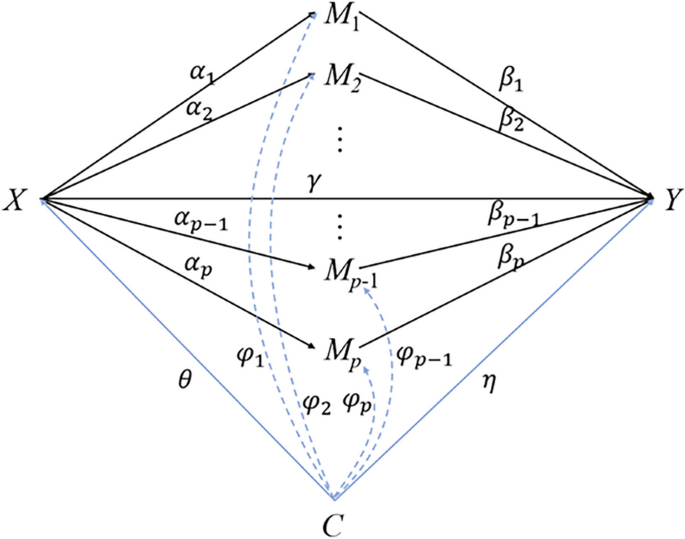
Causal diagram. High-dimensional mediation model with confounders between exposure, mediator and outcome
where \(\alpha ={\left({\alpha }_{1},{\alpha }_{2},\cdots ,{\alpha }_{p}\right)}^{T}\) is the coefficient vector relating the exposure to the mediators, \(\beta ={\left({\beta }_{1},{\beta }_{2},\cdots ,{\beta }_{p}\right)}^{T}\) represents the effect of the mediators on the outcome, \({\alpha }_{k}{\beta }_{k}\) corresponds to the mediation effect of \({M}_{k}\) according to the definition of coefficients product method, and \(\left[p\right]\) denotes the set of \(\left\{\text{1,2},\cdots ,p\right\}\) . One can consider whether \({M}_{k}\) is the statistically significant mediator or not by testing the null hypothesis \({H}_{0}:{\alpha }_{k}{\beta }_{k}=0\) . \({\phi }_{k}\) and \(\eta\) are the effect of \(C\) on \(M\) and \(C\) on \(Y\) , respectively. \({a}_{k}\) and \(a\) are the intercept term in the Eqs. 1 and 2 , respectively. The same as above, \({e}_{k}\) and \(\epsilon\) are each the corresponding error term. We will compare the different variable selection strategies and methods of adjusting confounders.
Assumptions
To ensure the identification of path-specific mediating effects, some assumptions need to be held as below. These assumptions were proposed referring to necessary condition required for high-dimensional mediation analysis suggested in published studies [ 8 , 15 , 17 , 19 , 26 , 27 ]:
A1: There is no causal association between mediators. This means the proposed model contains only parallel mediators.
A2: Sequential ignorability. That consists of four assumptions listed below:
(A2.1) There are no unmeasured confounders between the exposure and the outcome;
(A2.2) There are no unmeasured confounders between the mediators and the outcome;
(A2.3) There are no unmeasured confounders between the exposure and the mediators;
(A2.4) There is no exposure-induced confounding between the mediators and the outcome.
A3: Stable unit treatment value assumption (SUTVA) [ 28 , 29 ] for both the mediators and the outcome. That is to say, there is no interference between individuals.
A4: Consistency for the mediators and the outcome. That is to say, there are no measurement errors in the mediators.
A5: Positivity assumption [ 30 ]. Every individual has some positive probability of being exposed to the factor of interest.
Proposed Procedure
We improved the HIMA procedure proposed by Zhang et al. (2016) [ 9 ] and the HIMA2 procedure proposed by Perera et al. (2022) [ 17 ] under the condition of adjusting confounders in observational data.
In this study, we developed two processes to conduct the confounding-controlled high-dimensional mediation analysis. The detailed procedure is described in the following text.
Step 1: PS-based methods for adjusting confounders
Since there are always some baseline confounders in observational data, we integrate propensity score (PS) into mediators (and/or outcome) models to reduce the selection bias and acquire as accurate estimates of the mediation effect as possible. Due to the PS approaches allowing the inclusion of a large scale of confounders, PS is widely used in observational research.
PS is defined as the conditional probability that a study individual with baseline covariates \(C=\left({C}_{1},{C}_{2},\cdots ,{C}_{l}\right)\) would be exposed to certain study factors of interest [ 31 ]:
PS can be estimated by classic multivariable statistical methods such as logistic regression [ 32 ] or by machine learning methods such as random forest (RF) and generalized boosted model (GBM) [ 33 , 34 ]. In practice, logistic regression is the most commonly used. The PS of \(i\) th individual \({\pi }_{i}=P\left({X}_{i}=1|{C}_{1i},\cdots ,{C}_{li}\right)\) can be expressed as follows:
where \(\theta ={\left({\theta }_{1},{\theta }_{2},\cdots ,{\theta }_{l}\right)}^{T}\) represents the effect of the confounders on the exposure. Then we can adopt some PS-based techniques to adjust confounders such as matching [ 35 ], stratification [ 36 ], regression [ 31 ], and weighting [ 37 ]. Here, we focus on PS regression (PSR) and PS weighting [ 14 ] (PSW, also called IPW short for inverse probability weighting) techniques to adjust potential confounders between exposure, mediators and outcome.
PSR approach incorporates PS as a covariate into the original regression model to adjust for the probability of being exposed to study factors and to reduce confounding [ 32 ]. That is similar to taking all confounders as covariates in a classical regression approach which usually uses the linear regression model for continuous outcomes and the logistic regression model for binary outcomes [ 38 ]. For the PSR approach, we can estimate the effect through the models below:
The PSW approach constructs the inverse probability weights by taking the reciprocal of PS. For binary exposure, the weight of the exposed group \(X=1\) is given as \(\frac{1}{PS}\) , and that of the controlled group \(X=0\) as \(\frac{1}{1-PS}\) . For \(i\) th individual:
Then, we can estimate the coefficients of X in pathways \(X\to M\) and \(M\to Y\) by weighted estimation:
where \({\alpha }_{k,ipw}\) and \({\gamma }_{ipw}\) are the weighted estimation according to the \(ipw\) weight vector. However, the IPW often faces extreme PSs issue which may lead to extreme weights and result in biased estimates and excessive variance [ 23 , 24 ].
The overlap weighting (OW) approach was proposed to address the issue of extreme PSs [ 23 ]. The overlap weight is given as \(1-PS\) for the group \(X=1\) and \(PS\) for the group \(X=0\) . Note that, individuals with \(PS\) of 0.5 make the largest contribution to the effect estimate, and individuals with \(PS\) close to 0 and 1 make the smallest contribution. OW is likely to be beneficial in the presence of extreme tail weights [ 23 , 39 ]. For individual \(i\) :
Then, the effect estimation of OW is similar to that of the PSW procedure:
In the same way, \({\alpha }_{k,ow}\) and \({\gamma }_{ow}\) are the weighted estimation using \(ow\) weight vector.
Step 2: Confounding-controlled SIS approach for dimensionality reduction
The SIS procedure is a general technique to reduce accurately high dimensions to below sample size [ 40 ]. We adopt the SIS method to reduce dimension \(p\) from ultra-high dimension to moderate scale \(d=\left[\frac{2n}{\text{log}\left(n\right)}\right]\) [ 9 , 15 ].
In this study, we considered two preliminary screening strategies as described in HIMA [ 9 ] and HIMA2 [ 17 ], based on the effects of \(M\) on \(Y\) ( \({\beta }_{k}\) ) and the indirect effect \(\left|{\alpha }_{k}{\beta }_{k}\right|\) respectively. Because the indirect effects can be both positive and negative effects, to address the influence of the signs of the estimated indirect effects, the HIMA2 approach uses the absolute values of the indirect effect to obtain the size of the effect estimate regardless of the direction. This approach ensures that mediators with large effect size can be selected.
Due to the lack of screening accuracy in SIS based on indirect effects in the presence of confounders, we conducted the SIS screening based on the effects on the path \(M\to Y\) controlling confounding effects using the OW approach.
In simulation, we found that it is hard to select the true mediators based on \(\left|{\alpha }_{k}{\beta }_{k}\right|\) in the presence of confounding factors as applied in the original HIMA2 approach. So, we modified the frame of the HIMA2 method and both adopt SIS based on the effects on the path \(M\to Y\) \({\beta }_{k}\) in the preliminary screening to select the subset of potential mediators \({M}_{SIS}=\left\{{M}_{k}:{M}_{k} \text{i}\text{s} \text{a}\text{m}\text{o}\text{n}\text{g} \text{t}\text{h}\text{e} \text{t}\text{o}\text{p} d \text{l}\text{a}\text{r}\text{g}\text{e}\text{s}\text{t} \text{e}\text{f}\text{f}\text{e}\text{c}\text{t} of {\beta }_{k}\right\}\) .
Noticing that we need to adopt a two-step weighting method [ 14 ] to estimate \({\beta }_{k}\) for the PSW and OW methods.
First, \({\gamma }_{k,w}\) can be obtained from the following sub-model:
where \({\widehat{\gamma }}_{k,w}\) is the estimator of \({\gamma }_{k,ow}\) or \({\gamma }_{k,ipw}\) for each \({M}_{k}\) . In addition, the residual \({\widehat{e}}_{k}\) can be derived:
Then \({\beta }_{k}\) can be estimated by regressing \({\widehat{e}}_{k}\) on \({M}_{k}\) without weighting. Through the above SIS procedure, we can identify the important mediators and achieve the goal of dimensionality reduction.
Step 3: Penalized estimation
According to the HIMA procedure, after the preliminary selection of candidate mediators, further variable selection can be accomplished by the penalized estimation method. Here, we adopt the MCP [ 41 ] rather than other penalty functions, since the MCP approach has the oracle property which can select the correct model with probability tending to 1 as \(n\to \infty\) [ 15 , 41 , 42 ].
For the \(d\) -dimensional subset \({M}_{SIS}\) , we employed the MCP-penalized estimation to further select significant mediators set \({M}_{MCP}=\left\{{M}_{k}:{\beta }_{k}\ne 0,{M}_{k}\in {M}_{SIS}\right\}\) , MCP penalty function can be defined as below:
where \(\lambda >0\) is the regularization parameter which can be selected by AIC or BIC, and \(\delta >0\) is the tuning parameter which determines the concavity of MCP. The MCP procedure can be implemented through the R package ncvreg [ 43 ]. Through MCP penalty estimation, we filtered out the mediators with too weak effects by combining SIS and MCP procedures and then acquired the small number of mediators that needed to be tested. That will help to obtain more accurate effect estimates.
Following the original HIMA2 procedure, the penalized estimation adopts the de-biased Lasso method to get the estimator \({\widehat{\beta }}_{k}\) and standard error \({\widehat{\sigma }}_{{\beta }_{k}}\) . The sub-model of the de-biased Lasso method can be described below:
where \({\beta }_{SIS}\) denote the effects of \({M}_{k}\in {M}_{SIS}\) on \(Y\) . The corresponding P -values \({P}_{{\beta }_{k}}\) are given as:
where \({\Phi }\left(.\right)\) is the cumulative distribution function of standard normal distribution \(N\left(\text{0,1}\right)\) . The de-biased Lasso method can be implemented with the R package hdi .
Step 4: PS-based multiple mediation test
After MCP-based penalized estimation, we use the Joint significance test [ 3 , 44 ] (termed JS-uniform) to test the mediation effect of \({M}_{k}\in {M}_{MCP}\) . The Joint significance test considers the \({M}_{k}\) as a true mediator when \({\alpha }_{k}\) and \({\beta }_{k}\) is significant simultaneously. Here, \({\alpha }_{k}\) can be estimated through different confounding adjustment methods as shown in Eqs. 1 , 3 , 4 , and 5 . \({\beta }_{k}\) can be obtained using the linear regression with considering all confounders as covariates or only including PS (summary of all confounders) as a covariate.
In other words, that is based on the P -values for testing the path-specific effects \({H}_{0}:{\alpha }_{k}=0\) or \({H}_{0}:{\beta }_{k}=0\) . The raw P -value for the joint significance test [ 3 ] is defined below:
\(\begin{array}{c}{P}_{raw,k}=\text{max}\left({P}_{raw,{\alpha }_{k}}, {P}_{raw,{\beta }_{k}}\right),\#\end{array}\) where \({P}_{raw,{\alpha }_{k}}\) and \({P}_{raw,{\beta }_{k}}\) are the P -values for testing \({H}_{0}:{\alpha }_{k}=0\) and \({H}_{0}:{\beta }_{k}=0\) . \({P}_{raw,{\alpha }_{k}}\) and \({P}_{raw,{\beta }_{k}}\) can be obtained from the mediator model (e.g. Equations 1 , 3 , 4 , and 5 ) and outcome model (Eq. 2 ), respectively.
For the multiplicity (Type I error inflation) issue in multiple mediation testing, we adopted the Benjamini–Hochberg (BH) method [ 45 , 46 ] to acquire the adjusted \(p\) -values as below,
where \(q\) is the number of potential mediators in the set \({M}_{MCP}\) , and \({r}_{k}\) is the location number of \({P}_{raw,k}\) when all the P -values \({P}_{raw,k}\) are sorted ascending.
However, the Joint significance test assumes \({P}_{raw,k}\) follows a uniform null distribution. Although \({P}_{{\alpha }_{k}}\) and \({P}_{{\beta }_{k}}\) are each uniformly distributed, their maximum may not. Therefore, the Joint significance test results in a valid but overly conservative test with lower power [ 13 , 17 , 47 ].
Hence, we adopt the PS-based joint significance with mixture null distribution method [ 18 ] (termed JS-mixture) approach to conduct multiple mediation test after de-biased Lasso penalized estimation [ 17 , 48 ] referring to the classical HIMA2 procedure. The PS-based JS-mixture approach adopts a 3-component mixture distribution as below:
The estimated pointwise FDR for testing mediation can be computed as:
where \(t\in \left[\text{0,1}\right]\) , \({V}_{00}\left(t\right),{V}_{01}\left(t\right),{V}_{10}\left(t\right)\) denoting the numbers of the three types of false positives and \(R\left(t\right)={V}_{00}\left(t\right)+{V}_{01}\left(t\right)+{V}_{10}\left(t\right)+{V}_{11}\left(t\right)\) . The \({V}_{00}\left(t\right),{V}_{01}\left(t\right),{V}_{10}\left(t\right)\) and \(\widehat{FDR}\left(t\right)\) can be obtained using the R package HDMT .
We set the significance level of 0.05 for all the tests. The detailed processes of the proposed method are summarized in Fig. 2 .

The overall workflow for high-dimensional mediation analysis under the adjusting for confounders condition
Simulation studies
Simulation design.
In this section, we conducted the simulation studies to evaluate the performance of the proposed method. The implementation of the simulation was based on R (version 4.3.0, R Foundation for Statistical Computing, Vienna, Austria) and RStudio (version 2023.9.0.463, RStudio: Integrated Development Environment for R, Boston, MA). The setting of simulation parameters was based on the published studies [ 9 , 14 , 16 ]. The number of replications in simulation study was set to be 500 for each combination of parameter setting referring to the replication times settings in published methodogical studies [ 9 , 14 , 15 , 16 , 17 , 19 , 49 ].
The model structure is shown in Fig. 1 . We consider 8 confounders \(C=\left({C}_{1},{C}_{2},\cdots ,{C}_{8}\right)\) affecting the relationship of \(X\) , \(M\) , \(Y\) , in which continuous confounders \({C}_{1}-{C}_{4}\) follow a multivariate normal distribution \(N\left(\mu ,{\Sigma }\right)\) with a mean vector \(\mu ={\left(\text{0,0},\text{0,0}\right)}^{T}\) and a covariance matrix \({\Sigma }\) :
The last four binary confounders \({C}_{5}-{C}_{8}\) are independently generated from the Binary distribution \(B\left(n,0.3\right)\) , where \(n\) is the sample size.
Then exposure \(X\) can be generated from Binary distribution \(B\left(n,{P}_{c}\right)\) , where \(n\) is the sample size, \({P}_{c}=1/\left(1+{e}^{-\left({\theta }^{T}C\right)}\right)\) , and \({\theta }^{T}=\left({\theta }_{1},{\theta }_{2},\cdots ,{\theta }_{8}\right)=\left(\text{0.2,0.2,0.3,0.3,0.2,0.2,0.3,0.3}\right)\) .
Mediators \(M\) and the outcome variable \(Y\) are generated according to Eqs. 1 and 2 , respectively. For simplicity, we set all the effects of \(C\) on \(M\) to be the same. Let \({\phi }_{k}={\left({\phi }_{k1},\cdots ,{\phi }_{k8}\right)}^{T}={\left(\text{0.2,0.2,0.3,0.3,0.2,0.2,0.3,0.3}\right)}^{T}\) represent the effect of C on M. Let \(\eta ={\left({\eta }_{1},{\eta }_{2},\cdots ,{\eta }_{8}\right)}^{T}={\left(\text{0.2,0.2,0.3,0.3,0.2,0.2,0.3,0.3}\right)}^{T}\) denote the effects of \(C\) on \(Y\) .
We set the first four potential mediators \({M}_{1}-{M}_{4}\) as the true significant mediators in this study. Let \(\alpha ={\left({\alpha }_{1},{\alpha }_{2},\cdots ,{\alpha }_{p}\right)}^{T}=\left(\text{0.4,0.4,0.5,0.5,0.5,0.5,0},0,\cdots ,0\right)\) ; \(\beta ={\left({\beta }_{1},{\beta }_{2},\cdots ,{\beta }_{p}\right)}^{T}=\left(\text{0.4,0.5,0.5,0.6,0},\text{0,0.5,0.5,0},\cdots ,0\right)\) . The elements of both \(\alpha\) and \(\beta\) are equal to zero except for the first eight elements, and the first four are the significant mediators. The mediation effect size of the true mediators \({M}_{1}-{M}_{4}\) is \({\alpha \beta }_{1-4}=\left(\text{0.16,0.2,0.25,0.3}\right)\) .
Let \(\gamma =0.5\) ; \(a=0.5\) ; \(a_k\sim U(0,1)\) , \(\epsilon\sim N(0,1)\) . The error term \({e}_{k}\) are generated from \(N\left(\text{0,1.2}\right)\) and the correlation between mediators mostly falls between 0.15 and 0.35.
To evaluate the impacts of sample size and potential mediators dimension, we set two sample size levels \(n=300, 500\) , and two dimension levels \(p\) =1000,10000.
In addition, we take the correlation between mediators into account in the condition of \(p\) =1000 dimension. We simulate the strong correlation between mediators by generating the error terms \({e}_{k}\) from \(N\left(0,{{\Sigma }}_{e}\right)\) , where \({{\Sigma }}_{e}={\left({\rho }^{\left|k-{k}^{{\prime }}\right|}\right)}_{k,{k}^{{\prime }}}\) . It means the correlation between two mediators will decrease as the absolute difference in mediators’ subscript \(\left|k-{k}^{{\prime }}\right|\) increases. We set four correlation levels \(\rho =0, 0.25, \text{0.5,0.75}\) with dimension \(p\) =1000 and sample size \(n=300, 500\) . In the simulation setting \(\rho =0, 0.25, \text{0.5,0.75}\) , the corresponding Pearson correlation coefficients between two adjacent mediators are around 0.4, 0.5, 0.7, and 0.8, respectively. We evaluated the performance of the mHIMA2 and PS-based HIMA by conducting 500 replications of simulated data sets for each scenario [ 9 , 14 , 15 , 16 , 17 , 19 , 49 ].
Simulation results
Simulation results are presented in Tables 1 and 2 . Evaluation of the performance of mediator selection of the proposed approach is shown in Table 1 by measuring the true positive rate (TPR) and false discovery proportion (FDP) of selection after the significance test for mediation effects. The mediators have higher TPR as the indirect effect increases (i.e., larger mediation effect, higher detection rate).
As presented in Table 1 . Under most settings, the mHIMA2 mediation test approach has a higher TPR than PS-based HIMA while a higher FDP at the same time. Overall, the mHIMA2 is more powerful than the PS-based HIMA and is less conservative in selecting significant mediators.
As shown in Table 1 , for the mHIMA2 mediation test approach, TPR is ranked as OW > IPW > PSR > RA, and FDP is not more than 0.1 and gradually decreases to close to 0.05 as the sample size increases. Among all models, the mHIMA2 mediation test approach with OW adjustment has the highest power and acceptable false positive level. When using the PS-based HIMA mediation test approach, TPR is ranked consistently as RA > PSR > OW > IPW, and all four models also keep FDP at an extremely low level.
Table 2 presents the estimation of mediation effects with the mean and mean square error (MSE). The estimators approach the true values as the mediation effect increases. All models tend to be more accurate as \(n\) gets larger and \(p\) gets smaller. Overall, the mHIMA2 mediation test approach has a smaller MSE than the PS-based HIMA approach in most cases. RA adjustment has a higher MSE than other adjustment methods especially when facing the large mediation effect, OW adjustment has the lower MSE among the four adjustment methods.
As shown in Table 2 , similarly, the mHIMA2 approach with OW adjustment has the smallest MSE among all models. Moreover, similar results can be seen in the different strong correlation settings in Table S1-S8 in the supplementary file. The mHIMA2 methods have lower MSE (i.e. more precise estimation) and apparently higher TPR. That means the de-biased Lasso technique in mHIMA2 methods performs better when handling the moderate correlation between mediators. However, the FDP of all models slightly increases as the correlation between mediators increases. When correlation among the mediators is strong (for example, \(r\) >0.7), all models suffer in terms of increased MSE.
Data application
Smoking is an important environmental factor affecting the immune system and blood cell composition [ 50 , 51 ]. Previous studies have demonstrated smokers had lower natural killer (NK) cell counts and activity [ 50 , 51 ]. Smoking has also been found to be associated with DNA methylation levels [ 52 ]. Meanwhile, DNA methylation levels have also been found to be associated with associated with human NK cell activation [ 53 , 54 ]. Therefore, DNA methylation may mediate the association between smoking and NK cell level. So we implemented the proposed high-dimensional mediation analysis methods to identify the specific functional CpG sites that may mediate the relationship between smoking and the estimated NK cell level.
Here we apply our method to the GSE117859 dataset obtained from the Gene Expression Omnibus (GEO) database. The aim of the study in which GSE117859 was originally measured is to explore the smoking-associated DNA methylation features linked to AIDS outcomes in the HIV-positive population [ 55 ]. The blood samples from the Veteran Aging Cohort Study (VACS) were collected in that study. The HumanMethylation450 BeadChip platform was used to measure the DNA methylation levels.
In total 608 samplesand 485,577 probes were included in the dataset. Clinical information such as age, sex, race, smoking history, adherence of antiretroviral therapy (ART), estimated CD4 T cells, estimated CD8 T cells, and estimated NK cells were collected. The estimated CD4/CD8/NK were obtained using a methylation-based cell type deconvolution algorithm proposed by Housman et al. [ 56 ]. To some extent, the estimated CD4 and CD8 levels can represent AIDS severity.
Smoking status was collected based on self-report. All included patients were classified into the smoker and the non-smoker groups according to their reported smoking history. After removing the individuals without available clinical information and DNAm sites with missing values, a total of 587 samples and 485,503 probes were included in the analysis.
We adjusted the potential confounders including age, race, adherence of antiretroviral therapy, estimated CD4 T cells, and estimated CD8 T cells. Demographic and clinical variables included in our analysis are presented in Table 3 .
The analysis results using the proposed mHIMA2 method are presented in Table 4 . Here, we mainly presented the CpGs mediators with a total effect proportion greater than 5%. Due to the limitation of text content, we didn’t present the whole summary results of the PS-based HIMA method, but that can be seen in Table S9 in the supplementary file.
As shown in Table 4 , we identified two methylation sites cg13917614 in CNP gene and cg16893868 in LILRA2 gene by most of mHIMA2 based methods. The similar result can be seen in Table S9 in the supplementary file. The existing studies have already demonstrated the site cg13917614 is associated with smoking [ 52 , 57 ]. Although we don’t find direct evidence that the CNP gene is associated with immune function based on the existing literature, relevant studies showed a link between CNP and inflammatory responses in which the mechanism remains further study [ 58 , 59 ].
The encoded protein of the LILRA2 gene can suppress innate immune response [ 60 , 61 ]. The results reveal that smoking will promote the demethylation of cg16893868, leading to an increase in gene LILRA2 expression and ultimately reducing the estimated NK cell level. It has been found that the remaining CpG sites cg20460771, cg03164561, cg03605454, cg09529165, and cg01500140 are all associated with smoking [ 11 , 52 , 62 , 63 , 64 ]. Further insights into the discovered CpG mediators in genome-wide epigenetic studies will be meaningful.
The causal relationship obtained in high-dimensional mediation analysis usually depends on no-confounding assumption. However, confounding is almost inevitable in observational studies owing to the lack of randomization of the baseline covariates in practice. Previous studies show the utilization of PS method such as PS-adjustment and IPW in high-dimensional mediation analysis, but those face the issue of extreme PS distribution.
In this article, we integrated OW approach into the high-dimensional mediation model, which can address extreme PS distribution and better adjust for confounding. Finally, we developed a high-dimensional mediation analysis workflow consisting of OW confounding adjustment, SIS, de-biased Lasso penalization for potential mediator screening, and the high-dimensional mediation test underlying the mixture null distribution of P -values.
Simulation results indicate that the mHIMA2 with OW approach presented in this study performs best among all the compared models with the highest TPR, acceptable FDP level, and the smallest MSE in mediating effect estimation. In addition, the mHIMA2 embedded de-biased Lasso method performs better when moderate correlations between mediators exist.
Simulation study also suggestedthe proposed method would perform better when the sample size was increased. This result suggests that when the proposed method is used for the analysis of mediating effects on real data, a sufficient sample size should also be ensured. Such a feature is also consistent with other existing methods [ 5 , 9 , 14 , 17 , 19 , 49 ]. Furthermore, the dimensionality of potential mediators has little effect on the performance of the proposed method.
In most of the previous studies [ 5 , 9 , 13 , 17 ], it didn’t take confounding adjustment into account in the SIS process. However, we adopted the PS-based method to adjust confounding, thus improving the accuracy of mediators screening. Moreover, it has been assumed that mediators are linearly independent of each other, but such an assumption is often not strictly valid in real data. The violation of the mediators’ independence assumption often affects the accuracy of mediators selection and precision of mediating effect estimation. The proposed method can effectively deal with this issue which can tolerate the correlation between the mediators and ensure the robustness of mediators selection, multiple mediation testing, and mediating effect estimation.
Similar to other two-step approaches, the error of the first model may be introduced and cumulated in the second step, because the first-step can not quarantee 100% correctness. To avoid this, we set a relatively loose screening criterion with \(d=2n/log(n)\) to select the top \(d\) largest effect mediators [ 15 , 16 , 17 , 49 ] in the first step to control false negative while avoiding the increase of false positive error according to the application recommendation of SIS approach. Though the errors cannot be totally avoid, this can reduce the error in the preliminary screening of mediators and prevent serious error cumulation in the second step to some extend. As shown in the simulation, the proposed two-step model performed well. Besides, previous published studies also have demonstrated the error cumulation issue in two-step models can be controlled well in the similar way as we did, and well not cause serious bias in the final results [ 14 , 65 , 66 , 67 , 68 , 69 , 70 ].
Meanwhile, we applied the proposed method to the dataset GSE117859 obtained from the GEO databases and identified several significant DNAm mediators, including the sites cg13917614, cg16893868, cg20460771, cg03164561, cg03605454, cg09529165, and cg01500140. Among them, site cg16893868 in LILRA2 gene has been demonstrated to be associated with smoking and immune function [ 60 , 61 ]. That indicates that the proposed method can identify reliable mediators in empirical data analysis.
The presence of confounding in observation studies always is a major challenge to obtaining causal relationships. Currently, most genetic studies are based on observational research without randomization of baseline characteristics. Particularly, the high-dimensional mediation analysis always faces some issues, such as the accuracy of the high-dimensional mediation selection and the low power of multiple mediation test [ 13 , 14 , 17 , 18 ]. Although the utilization of PSR and IPW offers a solution of confounding adjustment in classical HDMA workflow, it still faces the issue of extreme PS distribution.
The proposed OW-based method can provide a more precise and stable mediating effect estimation. However, the misspecification of the outcome model and PS model can not be avoid in practice. Hence, the doubly robust methods may be desirable to be applied in HDMA workflow in future study. Even if the JS-mixture method was proposed to improve the power of multiple mediation testing, other more powerful test methods still are appealing in large-scale genome-wide epigenetic studies [ 13 , 18 ]. Conducting further simulation and methodology studies to compare different powerful test methods may provide useful reference for future studies. It should also be noticed that the existence of unmeasured confounding is out of the scope of this paper. Previews published studies have provided serval applicable methods to deal with this issue [ 49 , 71 ].
Overall, the mHIMA2 with OW adjustment has sufficient power in selecting potential true mediators and obtaining precise estimation for mediation effects. It can be recommended in practical high-dimensional mediation analysis, especially in epigenetic study.
Availability of data and materials
The dataset GSE117859 obtained from GEO database in our real data analysis can be accessed (at https://www.ncbi.nlm.nih.gov/geo/query/acc.cgi? acc=GSE117859) without limitation. Our procedure is implemented using the R software. The corresponding R code can be found at https://github.com/huww1998/CONF_mHIMA2.
Abbreviations
False discovery proportion
Gene Expression Omnibus
High-dimensional mediation analysis
Inverse probability weighting
Joint significant test with uniform distribution
Joint significance test with mixture null distribution
Mean square error
Modified HIMA2 model
Natural killer cell
Overlapping weighting
Propensity score regression adjustment
- Propensity score
Sure independence screening
True positive rate
Baron RM, Kenny DA. The moderator-mediator variable distinction in social psychological research: conceptual, strategic, and statistical considerations. J Personal Soc Psychol. 1986;51(6):1173–82. https://doi.org/10.1037//0022-3514.51.6.1173.
Article CAS Google Scholar
Huan T, Joehanes R, Schurmann C, Schramm K, Pilling LC, Peters MJ, et al. A whole-blood transcriptome meta-analysis identifies gene expression signatures of cigarette smoking. Hum Mol Genet. 2016;25(21):4611–23. https://doi.org/10.1093/hmg/ddw288 .
Article CAS PubMed PubMed Central Google Scholar
MacKinnon DP, Lockwood CM, Hoffman JM, West SG, Sheets V. A comparison of methods to test mediation and other intervening variable effects. Psychol Methods. 2002;7(1):83–104. https://doi.org/10.1037/1082-989x.7.1.83 .
Article PubMed PubMed Central Google Scholar
Biesanz JC, Falk CF, Savalei V. Assessing Mediational models: testing and interval estimation for Indirect effects. Multivar Behav Res. 2010;45(4):661–701. https://doi.org/10.1080/00273171.2010.498292 .
Article Google Scholar
Gao Y, Yang H, Fang R, Zhang Y, Goode EL, Cui Y. Testing mediation effects in high-dimensional epigenetic studies. Front Genet. 2019;10:1195. https://doi.org/10.3389/fgene.2019.01195 .
Taylor AB, MacKinnon DP. Four applications of permutation methods to testing a single-mediator model. Behav Res Methods. 2012;44(3):806–44. https://doi.org/10.3758/s13428-011-0181-x .
VanderWeele TJ. Marginal structural models for the estimation of direct and indirect effects. Epidemiol (Cambridge Mass). 2009;20(1):18–26. https://doi.org/10.1097/EDE.0b013e31818f69ce .
VanderWeele TJ, Vansteelandt S. Mediation analysis with multiple mediators. Epidemiol Methods. 2014;2(1):95–115. https://doi.org/10.1515/em-2012-0010 .
Zhang H, Zheng Y, Zhang Z, Gao T, Joyce B, Yoon G, et al. Estimating and testing high-dimensional mediation effects in epigenetic studies. Bioinf (Oxford England). 2016;32(20):3150–4. https://doi.org/10.1093/bioinformatics/btw351 .
Bibikova M, Barnes B, Tsan C, Ho V, Klotzle B, Le JM, et al. High density DNA methylation array with single CpG site resolution. Genomics. 2011;98(4):288–95. https://doi.org/10.1016/j.ygeno.2011.07.007 .
Article CAS PubMed Google Scholar
Harlid S, Xu Z, Panduri V, Sandler DP, Taylor JA. CpG sites associated with cigarette smoking: analysis of epigenome-wide data from the Sister Study. Environ Health Perspect. 2014;122(7):673–8. https://doi.org/10.1289/ehp.1307480 .
Toyooka S, Maruyama R, Toyooka KO, McLerran D, Feng Z, Fukuyama Y, et al. Smoke exposure, histologic type and geography-related differences in the methylation profiles of non-small cell lung cancer. Int J Cancer. 2003;103(2):153–60. https://doi.org/10.1002/ijc.10787 .
Liu Z, Shen J, Barfield R, Schwartz J, Baccarelli AA, Lin X. Large-scale hypothesis testing for Causal Mediation effects with Applications in Genome-wide epigenetic studies. J Am Stat Assoc. 2022;117(537):67–81. https://doi.org/10.1080/01621459.2021.1914634 .
Luo L, Yan Y, Cui Y, Yuan X, Yu Z. Linear high-dimensional mediation models adjusting for confounders using propensity score method. Front Genet. 2022;13:961148. https://doi.org/10.3389/fgene.2022.961148 .
Luo C, Fa B, Yan Y, Wang Y, Zhou Y, Zhang Y, et al. High-dimensional mediation analysis in survival models. PLoS Comput Biol. 2020;16(4):e1007768. https://doi.org/10.1371/journal.pcbi.1007768 .
Yu Z, Cui Y, Wei T, Ma Y, Luo C. High-dimensional mediation analysis with confounders in Survival models. Front Genet. 2021;12:688871. https://doi.org/10.3389/fgene.2021.688871 .
Perera C, Zhang H, Zheng Y, Hou L, Qu A, Zheng C, et al. HIMA2: high-dimensional mediation analysis and its application in epigenome-wide DNA methylation data. BMC Bioinformatics. 2022;23(1):296. https://doi.org/10.1186/s12859-022-04748-1 .
Dai JY, Stanford JL, LeBlanc M. A multiple-testing procedure for high-dimensional mediation hypotheses. J Am Stat Assoc. 2022;117(537):198–213. https://doi.org/10.1080/01621459.2020.1765785 .
Zhang H, Zheng Y, Hou L, Zheng C, Liu L. Mediation analysis for survival data with high-dimensional mediators. Bioinf (Oxford England). 2021;37(21):3815–21. https://doi.org/10.1093/bioinformatics/btab564 .
Heinze G, Jüni P. An overview of the objectives of and the approaches to propensity score analyses. Eur Heart J. 2011;32(14):1704–8. https://doi.org/10.1093/eurheartj/ehr031 .
Article PubMed Google Scholar
Stuart EA. Matching methods for causal inference: a review and a look forward. Stat Science: Rev J Inst Math Stat. 2010;25(1):1–21. https://doi.org/10.1214/09-STS313 .
Lee BK, Lessler J, Stuart EA. Weight trimming and propensity score weighting. PLoS One. 2011;6(3):e18174. https://doi.org/10.1371/journal.pone.0018174 .
Li F, Thomas LE, Li F. Addressing Extreme Propensity scores via the Overlap weights. Am J Epidemiol. 2019;188(1):250–7. https://doi.org/10.1093/aje/kwy201 .
Thomas LE, Li F, Pencina MJ. Overlap weighting: a propensity score method that mimics attributes of a Randomized Clinical Trial. JAMA. 2020;323(23):2417. https://doi.org/10.1001/jama.2020.7819 .
Mlcoch T, Hrnciarova T, Tuzil J, Zadak J, Marian M, Dolezal T. Propensity Score Weighting Using Overlap Weights: A New Method Applied to Regorafenib Clinical Data and a Cost-Effectiveness Analysis. Value in Health. 2019;22(12):1370-7. doi: 10.1016/j.jval.2019.06.010.
Vanderweele TJ, Vansteelandt S, Robins JM. Effect decomposition in the presence of an exposure-induced mediator-outcome confounder. Epidemiol (Cambridge Mass). 2014;25(2):300–6. https://doi.org/10.1097/EDE.0000000000000034 .
Perera C, Zhang H, Zheng Y, Hou L, Qu A, Zheng C, et al. HIMA2: high-dimensional mediation analysis and its application in epigenome-wide DNA methylation data. BMC Bioinformatics. 2022;23(1). https://doi.org/10.1186/s12859-022-04748-1 .
Basu D. Randomization analysis of Experimental Data: the Fisher randomization test. J Am Stat Assoc. 1980;75(371):575–82. https://doi.org/10.1080/01621459.1980.10477512 .
Rubin DB. Comment. J American Statis Assoc. 1986;81(396):961–2. https://doi.org/10.1080/01621459.1986.10478355 .
Imbens GW, Rubin DB. Causal inference for statistics, Social, and Biomedical sciences: an introduction. Cambridge: Cambridge University Press; 2015.
Book Google Scholar
Rosenbaum PR, Rubin DB. The central role of the propensity score in observational studies for causal effects. Biometrika. 1983;70(1):41–55. https://doi.org/10.1093/biomet/70.1.41 .
Haukoos JS, Lewis RJ. The Propensity score. JAMA. 2015;314(15):1637–8. https://doi.org/10.1001/jama.2015.13480 .
Lee BK, Lessler J, Stuart EA. Improving propensity score weighting using machine learning. Stat Med. 2010;29(3):337–46. https://doi.org/10.1002/sim.3782 .
Abdia Y, Kulasekera KB, Datta S, Boakye M, Kong M. Propensity scores based methods for estimating average treatment effect and average treatment effect among treated: a comparative study. Biometrical J Biometrische Z. 2017;59(5):967–85. https://doi.org/10.1002/bimj.201600094 .
Rosenbaum PR, Rubin DB. Constructing a Control Group Using Multivariate Matched Sampling Methods That Incorporate the Propensity Score. Am Stat. 1985;39(1):33–8. https://doi.org/10.1080/00031305.1985.10479383 .
Rosenbaum PR, Rubin DB. Reducing Bias in Observational studies using subclassification on the Propensity score. J Am Stat Assoc. 1984;79(387):516–24. https://doi.org/10.1080/01621459.1984.10478078 .
Robins JM, Rotnitzky A, Zhao LP. Analysis of semiparametric regression models for repeated outcomes in the presence of missing data. J Am Stat Assoc. 1995;90(429):106–21. https://doi.org/10.1080/01621459.1995.10476493 .
Austin PC. An introduction to propensity score methods for reducing the effects of confounding in observational studies. Multivar Behav Res. 2011;46(3):399–424. https://doi.org/10.1080/00273171.2011.568786 .
Li F, Morgan KL, Zaslavsky AM. Balancing covariates via Propensity score weighting. J Am Stat Assoc. 2018;113(521):390–400. https://doi.org/10.1080/01621459.2016.1260466 .
Fan J, Lv J. Sure Independence Screening for Ultrahigh Dimensional Feature Space. J Royal Stat Soc Ser B: Stat Methodol. 2008;70(5):849–911. https://doi.org/10.1111/j.1467-9868.2008.00674.x .
Zhang C-H. Nearly unbiased variable selection under minimax concave penalty. Annals Stat. 2010;38(2):894–942. https://doi.org/10.1214/09-AOS729 .
Maity AK, Basu S. Highest posterior model computation and variable selection via simulated annealing. The New England J Statis Data Sci. 2023;1(2):200–7. https://doi.org/10.51387/23-NEJSDS40 .
Breheny P, Huang J. Coordinate Descent algorithms for Nonconvex Penalized Regression, with applications to Biological feature selection. Annals Appl Stat. 2011;5(1):232–53. https://doi.org/10.1214/10-AOAS388 .
Huang Y-T, Pan W-C. Hypothesis test of mediation effect in causal mediation model with high-dimensional continuous mediators. Biometrics. 2016;72(2):402–13. https://doi.org/10.1111/biom.12421 .
Benjamini Y, Hochberg Y. Controlling the false Discovery rate: a practical and powerful Approach to multiple testing. J Roy Stat Soc: Ser B (Methodol). 1995;57(1):289–300. https://doi.org/10.1111/j.2517-6161.1995.tb02031.x .
Hochberg Y. A sharper Bonferroni procedure for multiple tests of significance. Biometrika. 1988;75(4):800–2. https://doi.org/10.1093/biomet/75.4.800 .
Huang Y-T. Joint significance tests for mediation effects of socioeconomic adversity on adiposity via epigenetics. Annals Appl Stat. 2018;12(3):1535–57. https://doi.org/10.1214/17-AOAS1120 .
Fang EX, Ning Y, Liu H. Testing and confidence intervals for high Dimensional Proportional hazards Model. J Royal Stat Soc Ser B Stat Methodol. 2017;79(5):1415–37. https://doi.org/10.1111/rssb.12224 .
Chen F, Hu W, Cai J, Chen S, Si A, Zhang Y, et al. Instrumental variable-based high-dimensional mediation analysis with unmeasured confounders for survival data in the observational epigenetic study. Front Genet. 2023;14:1092489. https://doi.org/10.3389/fgene.2023.1092489 .
Qiu F, Liang C-L, Liu H, Zeng Y-Q, Hou S, Huang S, et al. Impacts of cigarette smoking on immune responsiveness: up and down or upside down? Oncotarget. 2017;8(1):268–84. https://doi.org/10.18632/oncotarget.13613 .
Elisia I, Lam V, Cho B, Hay M, Li MY, Yeung M, et al. The effect of smoking on chronic inflammation, immune function and blood cell composition. Sci Rep. 2020;10:19480. https://doi.org/10.1038/s41598-020-76556-7 .
Breitling LP, Yang R, Korn B, Burwinkel B, Brenner H. Tobacco-smoking-related differential DNA methylation: 27K discovery and replication. Am J Hum Genet. 2011;88(4):450–7. https://doi.org/10.1016/j.ajhg.2011.03.003 .
Wiencke JK, Butler R, Hsuang G, Eliot M, Kim S, Sepulveda MA, et al. The DNA methylation profile of activated human natural killer cells. Epigenetics. 2016;11(5):363–80. https://doi.org/10.1080/15592294.2016.1163454 .
Gao X, Jia M, Zhang Y, Breitling LP, Brenner H. DNA methylation changes of whole blood cells in response to active smoking exposure in adults: a systematic review of DNA methylation studies. Clin Epigenetics. 2015;7:113. https://doi.org/10.1186/s13148-015-0148-3 .
Zhang X, Hu Y, Aouizerat BE, Peng G, Marconi VC, Corley MJ, et al. Machine learning selected smoking-associated DNA methylation signatures that predict HIV prognosis and mortality. Clin Epigenetics. 2018;10(1):155. https://doi.org/10.1186/s13148-018-0591-z .
Houseman EA, Accomando WP, Koestler DC, Christensen BC, Marsit CJ, Nelson HH, et al. DNA methylation arrays as surrogate measures of cell mixture distribution. BMC Bioinformatics. 2012;13(1):86. https://doi.org/10.1186/1471-2105-13-86 .
Wan ES, Qiu W, Baccarelli A, Carey VJ, Bacherman H, Rennard SI, et al. Cigarette smoking behaviors and time since quitting are associated with differential DNA methylation across the human genome. Hum Mol Genet. 2012;21(13):3073–82. https://doi.org/10.1093/hmg/dds135 .
Bao Q, Zhang B, Zhou L, Yang Q, Mu X, Liu X, et al. CNP Ameliorates Macrophage Inflammatory Response and Atherosclerosis. Circ Res. 0(0). https://doi.org/10.1161/CIRCRESAHA.123.324086 .
Bae C-R, Hino J, Hosoda H, Arai Y, Son C, Makino H, et al. Overexpression of C-type natriuretic peptide in endothelial cells protects against Insulin Resistance and inflammation during Diet-induced obesity. Sci Rep. 2017;7(1):9807. https://doi.org/10.1038/s41598-017-10240-1 .
Lu HK, Mitchell A, Endoh Y, Hampartzoumian T, Huynh O, Borges L, et al. LILRA2 selectively modulates LPS-mediated cytokine production and inhibits phagocytosis by monocytes. PLoS ONE. 2012;7(3):e33478. https://doi.org/10.1371/journal.pone.0033478 .
Lewis Marffy AL, McCarthy AJ. Leukocyte Immunoglobulin-Like receptors (LILRs) on human neutrophils: modulators of infection and immunity. Front Immunol. 2020;11:857. https://doi.org/10.3389/fimmu.2020.00857 .
Sikdar S, Joehanes R, Joubert BR, Xu C-J, Vives-Usano M, Rezwan FI, et al. Comparison of smoking-related DNA methylation between newborns from prenatal exposure and adults from personal smoking. Epigenomics. 2019;11(13):1487–500. https://doi.org/10.2217/epi-2019-0066 .
Joehanes R, Just AC, Marioni RE, Pilling LC, Reynolds LM, Mandaviya PR, et al. Epigenetic signatures of cigarette smoking. Circulation Cardiovasc Genet. 2016;9(5):436–47. https://doi.org/10.1161/CIRCGENETICS.116.001506 .
Sun YV, Smith AK, Conneely KN, Chang Q, Li W, Lazarus A, et al. Epigenomic association analysis identifies smoking-related DNA methylation sites in African americans. Hum Genet. 2013;132(9):1027–37. https://doi.org/10.1007/s00439-013-1311-6 .
Luo C, Wang G, Hu F. Two-Step Gene Feature Selection Algorithm Based on Permutation Test. In: Yao J, Yang Y, Słowiński R, Greco S, Li H, Mitra S, et al., editors. Springer; 2012. p. 249−58. https://doi.org/10.1111/ppe.12382 .
Liu D, Yeung EH, McLain AC, Xie Y, Buck Louis GM, Sundaram R. A two-step Approach for Analysis of Nonignorable Missing outcomes in Longitudinal Regression: an application to Upstate KIDS Study. Paediatr Perinat Epidemiol. 2017;31(5):468–78. https://doi.org/10.1111/ppe.12382 .
Newcombe PJ, Connolly S, Seaman S, Richardson S, Sharp SJ. A two-step method for variable selection in the analysis of a case-cohort study. Int J Epidemiol. 2018;47(2):597–604. https://doi.org/10.1093/ije/dyx224 .
Song J, Shin SJ. A two-step approach for variable selection in linear regression with measurement error. Commun Stat Appl Methods. 2019;26(1):47–55. https://doi.org/10.29220/CSAM.2019.26.1.047 .
Liu Y, Qin SJ. A Novel two-step sparse Learning Approach for Variable Selection and Optimal Predictive modeling. IFAC-PapersOnLine. 2022;55(7):57–64. https://doi.org/10.1016/j.ifacol.2022.07.422 .
Chamlal H, Benzmane A, Ouaderhman T. A Two-Step Feature Selection Procedure to Handle High-Dimensional Data in Regression Problems. 2023 International Conference on Decision Aid Sciences and Applications (DASA). 2023. p. 592–6.
Google Scholar
Wickramarachchi DS, Lim LHM, Sun B. Mediation analysis with multiple mediators under unmeasured mediator-outcome confounding. Stat Med. 2023;42(4):422–32. https://doi.org/10.1002/sim.9624 .
Download references
Acknowledgements
We acknowledge GEO database for providing their platforms and contributors for uploading their meaningful datasets.
This work was supported by the National Social Science Found of China (21CTJ009) and National Nature Science Foundation of China (81703325).
Author information
Authors and affiliations.
Department of Epidemiology and Biostatistics, School of Public Health, Xi’an Jiaotong University, Xi’an, 710061, Shaanxi, China
Weiwei Hu, Shiyu Chen, Jiaxin Cai, Yuhui Yang, Hong Yan & Fangyao Chen
Department of Radiology, First Affiliated Hospital of Xi’an Jiaotong University, Xi’an, 710061, Shaanxi, China
Fangyao Chen
You can also search for this author in PubMed Google Scholar
Contributions
F.C., H.Y. and W.H. led the conception and design of the work. W.H. and S.C. conducted the simulation study. W.H., S.C., and J.C. finished data cleaning and implemented real data application. W.H. completed the original draft. F.C., J.C., and Y.Y. guided analyses and provided advice. F.C. critically reviewed and edited the manuscript.
Corresponding author
Correspondence to Fangyao Chen .
Ethics declarations
Ethics approval and consent to participate.
Not applicable.
Consent for publication
Competing interests.
The authors declare no competing interests.
Additional information
Publisher’s note.
Springer Nature remains neutral with regard to jurisdictional claims in published maps and institutional affiliations.
Supplementary Information
12874_2024_2254_moesm1_esm.docx.
Additional file 1: High-dimensional mediation analysis for continuous outcome with confounders using overlap weighting method in observational epigenetic study. Simulation results of different correlation levels \(\rho\) =0,0.25,0.5,0.75 with dimension \(\rho\) =1000 and sample size \(n\) =300,500 were presented in the Table S1-8. Analysis result using the PS-based HIMA methods was shown in Table S9.
Rights and permissions
Open Access This article is licensed under a Creative Commons Attribution 4.0 International License, which permits use, sharing, adaptation, distribution and reproduction in any medium or format, as long as you give appropriate credit to the original author(s) and the source, provide a link to the Creative Commons licence, and indicate if changes were made. The images or other third party material in this article are included in the article's Creative Commons licence, unless indicated otherwise in a credit line to the material. If material is not included in the article's Creative Commons licence and your intended use is not permitted by statutory regulation or exceeds the permitted use, you will need to obtain permission directly from the copyright holder. To view a copy of this licence, visit http://creativecommons.org/licenses/by/4.0/ . The Creative Commons Public Domain Dedication waiver ( http://creativecommons.org/publicdomain/zero/1.0/ ) applies to the data made available in this article, unless otherwise stated in a credit line to the data.
Reprints and permissions
About this article
Cite this article.
Hu, W., Chen, S., Cai, J. et al. High-dimensional mediation analysis for continuous outcome with confounders using overlap weighting method in observational epigenetic study. BMC Med Res Methodol 24 , 125 (2024). https://doi.org/10.1186/s12874-024-02254-x
Download citation
Received : 15 March 2024
Accepted : 22 May 2024
Published : 03 June 2024
DOI : https://doi.org/10.1186/s12874-024-02254-x
Share this article
Anyone you share the following link with will be able to read this content:
Sorry, a shareable link is not currently available for this article.
Provided by the Springer Nature SharedIt content-sharing initiative
- High-dimensional mediation model
- Overlap weighting
- Joint significant test
- Composite null hypothesis
BMC Medical Research Methodology
ISSN: 1471-2288
- General enquiries: [email protected]
Official websites use .gov
A .gov website belongs to an official government organization in the United States.
Secure .gov websites use HTTPS
A lock ( ) or https:// means you've safely connected to the .gov website. Share sensitive information only on official, secure websites.
From Data to Action: National, State & Local Efforts to End Menthol and Other Flavored Commercial Tobacco Product Use

Mapping Chronic Disease in the United States [PDF - 2 MB] -->
GUEST EDITORIAL
PEER REVIEWED
Preventing Chronic Disease Collection: From Data to Action: National, State, and Local Efforts to End Menthol and Other Flavored Commercial Tobacco Product Use
Marshall LL, Norman L, Rose SW, Tseng T. Preventing Chronic Disease Collection: From Data to Action: National, State, and Local Efforts to End Menthol and Other Flavored Commercial Tobacco Product Use. Prev Chronic Dis 2024;21;240143.
The National and State Tobacco Control Program: Overview of the Centers for Disease Control and Prevention’s Efforts to Address Commercial Tobacco Use
Marshall L, Pasalic E, Mahoney M, Turner T, Sneegas K, Kittner DL. The National and State Tobacco Control Program: Overview of the Centers for Disease Control and Prevention’s Efforts to Address Commercial Tobacco Use. Prev Chronic Dis 2024;21;230311.
ORIGINAL RESEARCH
Use of Menthol-Flavored Tobacco Products Among US Middle and High School Students: National Youth Tobacco Survey, 2022
Cornelius ME, Gentzke AS, Loretan CG, Hawkins NA, Jamal A. Use of Menthol-Flavored Tobacco Products Among US Middle and High School Students: National Youth Tobacco Survey, 2022. Prev Chronic Dis 2024;21:230305.
Sociodemographic and Temporal Differences in Menthol Cigarette Use Among US Adults Who Smoke, 1999–2018
Cheng YJ, Tsai J, Cornelius ME, Mahoney M, Neff LJ. Sociodemographic and Temporal Differences in Menthol Cigarette Use Among US Adults Who Smoke, 1999–2018. Prev Chronic Dis 2023;20:230291.
CME ACTIVITY
State-Specific Prevalence of Adult Tobacco Product Use and Cigarette Smoking Cessation Behaviors, United States, 2018–2019
Cornelius ME, Wang TW, Jamal A, Loretan CG, Willis G, Graham-Glover B, et al. State-Specific Prevalence of Adult Tobacco Product Use and Cigarette Smoking Cessation Behaviors, United States, 2018–2019. Prev Chronic Dis 2023;20:230132.
TOOLS FOR PUBLIC HEALTH PRACTICE
Strategies for Effective Capacity-Building in the Fight Against Commercial Tobacco
Caldwell K, Hebert A, Bolden G. Strategies for Effective Capacity-Building in the Fight Against Commercial Tobacco. Prev Chronic Dis 2024;21:230307.
It’s Not Just : Evaluation of a Media Campaign to Motivate Action Around Targeting of Menthol Tobacco in Black Communities
Eggers ME, Nonnemaker JM, Kelly LK, Ortega-Peluso C, Anker E, Lee J, et al. It’s Not Just: Evaluation of a Media Campaign to Motivate Action Around Targeting of Menthol Tobacco in Black Communities. Prev Chronic Dis 2024;21:230237.
PROGRAM EVALUATION BRIEF
Creating and Implementing a Community-Focused, Culturally Tailored Health Marketing Campaign to Address Menthol Cigarette Use in Los Angeles County
Humphrey R, Truong A, Fraser R, Gallow TG, Fischbach L, Kuo T. Creating and Implementing a Community-Focused, Culturally Tailored Health Marketing Campaign to Address Menthol Cigarette Use in Los Angeles County. Prev Chronic Dis 2024;21:230282.
Facilitators and Barriers to Passing Local Policies That Prohibit the Sale of Flavored Tobacco Products: Qualitative Analysis of Strategies Implemented by 36 Public Health Agencies in California, 2017–2021
Hellesen S, Haun S, Dove MS. Facilitators and Barriers to Passing Local Policies That Prohibit the Sale of Flavored Tobacco Products: Qualitative Analysis of Strategies Implemented by 36 Public Health Agencies in California, 2017–2021. Prev Chronic Dis 2024;21:230283.
RESEARCH BRIEF
Community Engagement, Jurisdictional Experience, and Previous Tobacco-Related Ordinances in Neighboring Communities as Drivers of Flavored Tobacco Bans in Los Angeles County
Guglielmo D, Dang A, Fischbach L, Toruno R, Chavez-Sosa G, Messex M, et al. Community Engagement, Jurisdictional Experience, and Previous Tobacco-Related Ordinances in Neighboring Communities as Drivers of Flavored Tobacco Bans in Los Angeles County. Prev Chronic Dis 2024;21:230284.
The opinions expressed by authors contributing to this journal do not necessarily reflect the opinions of the U.S. Department of Health and Human Services, the Public Health Service, the Centers for Disease Control and Prevention, or the authors’ affiliated institutions.
To receive email updates about this page, enter your email address:
- PCD on Instagram
- Get LinkedIn
- PCD on Twitter
- PCD on Facebook
- PCD Sound Bites
- Subscribe to RSS
- PubMed Central

- Emerging Infectious Diseases Journal
- Morbidity and Mortality Weekly Report (MMWR)
- Vital Signs
Exit Notification / Disclaimer Policy
- The Centers for Disease Control and Prevention (CDC) cannot attest to the accuracy of a non-federal website.
- Linking to a non-federal website does not constitute an endorsement by CDC or any of its employees of the sponsors or the information and products presented on the website.
- You will be subject to the destination website's privacy policy when you follow the link.
- CDC is not responsible for Section 508 compliance (accessibility) on other federal or private website.
Click through the PLOS taxonomy to find articles in your field.
For more information about PLOS Subject Areas, click here .
Loading metrics
Open Access
Peer-reviewed
Research Article
Forest structure, plants, arthropods, scale, or birds’ functional groups: What key factor are forest birds responding to?
Roles Conceptualization, Data curation, Formal analysis, Methodology, Validation, Writing – original draft, Writing – review & editing
* E-mail: [email protected]
Affiliation Ornithology, Natural History Museum Vienna, Vienna, Austria
Roles Data curation, Methodology, Writing – review & editing
Affiliations Forest Entomology, Research Unit Forest Health and Biotic Interactions, Swiss Federal Research Institute WSL, Birmensdorf, Switzerland, Department of Environmental Systems Science, Institute of Terrestrial Ecosystems, ETH Zurich, Zurich, Switzerland
Roles Resources, Writing – review & editing
Affiliation Institute of Evolutionary Ecology and Conservation Genomics, University of Ulm, Ulm, Germany
Roles Conceptualization, Data curation, Methodology, Writing – review & editing
Affiliation Centre of Biodiversity and Sustainable Land-use, University of Göttingen, Göttingen, Germany
Roles Data curation, Resources, Validation
Affiliation Terrestrial Ecology, TUM, Freising, Germany
- Swen C. Renner,
- Martin M. Gossner,
- Manfred Ayasse,
- Stefan Böhm,
- Miriam Teuscher,
- Wolfgang W. Weisser,
- Kirsten Jung

- Published: May 31, 2024
- https://doi.org/10.1371/journal.pone.0304421
- Reader Comments
Forest birds respond to a diverse set of environmental factors, including those altered by forest management intensity, such as resource and habitat availability in the form of food or nesting sites. Although resource/habitat availability and bird traits likely mediate responses of bird diversity to global change drivers, no study has assessed the direct and indirect effects of changes in forest management and traits on bird assemblages jointly at large spatial scales. In this context the questions remain whether (1) the birds’ response to forest management changes through alterations in structural properties and/or food availability, or (2) if birds’ eco-morphological traits act as environmental filters in response to environmental factors. We audio-visually recorded birds at 150 forest plots in three regions of Germany and assessed the forest structure (LiDAR) as well as the diversity of the herbaceous layer and diversity and biomass of arthropods. We further assessed eco-morphological traits of the birds and tested if effects on bird assemblages are mediated by changes in eco-morphological traits’ composition. We found that abundance and species numbers of birds are explained best by models including the major environmental factors, forest structure, plants, and arthropods. Eco-morphological traits only increased model fit for indirect effects on abundance of birds. We found minor differences between the three regions in Germany, indicating spatial congruency of the processes at the local and regional scale. Our results suggest that most birds are not specialized on a particular food type, but that the size, diversity and species composition of arthropods are important. Our findings question the general view that bird traits adapt to the resources available.
Citation: Renner SC, Gossner MM, Ayasse M, Böhm S, Teuscher M, Weisser WW, et al. (2024) Forest structure, plants, arthropods, scale, or birds’ functional groups: What key factor are forest birds responding to? PLoS ONE 19(5): e0304421. https://doi.org/10.1371/journal.pone.0304421
Editor: Janice L. Bossart, Southeastern Louisiana University, UNITED STATES
Received: March 31, 2023; Accepted: May 12, 2024; Published: May 31, 2024
Copyright: © 2024 Renner et al. This is an open access article distributed under the terms of the Creative Commons Attribution License , which permits unrestricted use, distribution, and reproduction in any medium, provided the original author and source are credited.
Data Availability: The datasets are available from www.biodiversity-exploratories.de . We used datasets with ID 21446 (bird species 2008), 20067 (bird traits), 6320 (plants/herbaceous layers), 25786 (biomass arthropods), and 16909 (arthropods groups).
Funding: The DFG Priority Program 1374 'Infrastructure-Biodiversity-Exploratories' funded the work (Re1733/6-1, Ka1241/19-1). The open access fee was provided by the NHM Wien. The responsible state environmental offices of Baden-Württemberg, Brandenburg, and Thüringen issued all permits for access to the sites and fieldwork. The funders had no role in study design, data collection and analysis, decision to publish, or preparation of the manuscript.
Competing interests: The authors have declared that no competing interests exist.
Introduction
Global change is affecting biological diversity with far-reaching consequences for ecosystem functioning and ultimately human wellbeing [ 1 ]. Despite extensive research on how biodiversity responds to global change [ 2 ], ongoing debates persist over the mechanisms underlying such responses. Assessing the relative importance of mediating roles of diverse environmental factors as filters remains unresolved. Diversity changes and abundance-shifts are caused by various types of environmental change resulting from different global change scenarios such as land-use change and intensification of land-use management [ 3 ]. These shifts can be augmented by eco-morphological trait-based filters. The traits can additionally alter community composition based on species-specific characteristics [ 4 ]. However, whether eco-morphological traits operate as environmental filters in these habitats (along with food availability), or if the trait-variability in birds is only driven by food availability (i.e. traits vary independent of the habitat) remains unresolved.
Land-use and forest management, influencing forest types and forest structural properties, leads to altered species assemblages and species responses, potentially favoring those traits adapted to local habitat conditions and impacting species’ vulnerability to structural changes [ 5 ]. Consequently, this sorting process—or environmental filtering—can lead to a loss of regional biodiversity as forest management continues to intensify. Environmental filtering can be seconded by species interactions or resource availability, that can further shape these assemblages [ 6 ]. Consequently, the effects of trait variability should be assessed along with species compositional changes, as both may be reasons for bird responses to change in forest management [ 7 ].
In this context, scale-dependencies matter, because increased landscape heterogeneity is associated with higher resources and niche availability and consequently with an increase in species numbers. However, local and landscape scale factors do not affect all birds in the same way [ 8 ]. Particularly, the role of eco-morphological traits on species composition, abundance and species diversity at different scales remains unresolved. To elucidate the mechanisms underlying the shifts in species abundances and composition across scales and forest management regimes, it is essential to understand the combined effects of direct and indirect pathways [ 2 ]. Bird species numbers and diversity are generally influenced by habitat structure, species-specific traits, seasonality, long-term turnover, and resource availability [ 9 – 15 ], and the impacts are evident at multiple spatial scales [ 16 ]. Intensified forest management and forest use alters resource availability such as food for the birds. For instance, altered insect biomass potentially impacts insectivorous bird populations [ 17 ]. Direct effects, involving factors like nesting sites, influence local bird occurrence [ 18 ]. Indirect effects, sometimes mediated through eco-morphological traits like bill size, could be shaped by habitat types, which in turn are influenced by forest management strategies [ 18 ]. Eco-morphological traits might mediate bird responses to management, influencing species numbers and abundances [ 19 – 21 ], while interactions between species can further shape these patterns [ 22 ]. However, the extent to which bird diversity responds directly vs. indirectly to environmental gradients and the detailed pathways of trait-variation remains uncertain.
Birds’ responses to forest management according to their eco-morphological traits can occur at individual, species, and assemblage levels [ 23 , 24 ]. Traits, such as for instance bill size, limit a bird species’ capacity to consume insects. For instance, the size of the bill-opening and prey size need to match. Forest structure significantly influences bird species and abundance [ 23 , 25 – 30 ], with different species favoring specific structures related to foraging strategies and eco-morphological traits [ 23 , 28 ]. Thus, eco-morphological traits offer insights into how birds respond to arthropods as food availability, which in turn respond in biomass and species numbers to specific forest management measures. Evaluating resource availability, eco-morphological traits, and habitat structure featured in a single statistical framework will help to explain bird responses to land management.
The objective of our study is to examine how bird abundance is affected by environmental factors, specifically forest structural parameters (quantified by LiDAR—Light Detection and Ranging) and resource availability (arthropods, shrub and herbs), across local and regional scales in Germany. Particularly we focus on the role of eco-morphological traits, such as wing size, bill size, and tarsus size, in mediating bird responses to forest management by using Structural Equation Modeling (SEM). SEM offers insights into direct and indirect drivers [ 31 ], helping us understand potential mechanisms underlying relationships between forest management and bird assemblages. We explore two main pathways, representing two hypotheses: (1) forest structure and resource availability affect bird traits and diversity, while eco-morphological traits are of limited importance in sorting the bird community, but are affected by the sorting of species and their abundance through food availability ( Fig 1A illustrates the general pathways for this model structure)–we name this hypothesis "Habitat-food filter hypothesis;" vs. (2) forest structure and resources influence bird assemblages via trait-mediated mechanisms, reflecting environmental filtering of traits ( Fig 1B illustrates the general pathway for this model structure)–we name this hypothesis "eco-morphological filter hypothesis."
- PPT PowerPoint slide
- PNG larger image
- TIFF original image
(A) Global model structure for Structural Equation Model, reflecting Hypothesis 1 (full model illustrated in S1 Fig ). (B) Global model structure for Structural Equation Model, reflecting Hypothesis 2 (full model illustrated in S2 Fig ). Double-headed or bidirectional arrows indicate variance or covariance. Latent variables ( ellipse ) are unobserved variables. Ecomorphological traits ( S1 Table ), arthropods ( S2 Table ), forest structure ( S3 Table ), and forest shrub layers ( S3 Table ) are hypothetical examples in this figure, and have been replaced by a set of measured parameters as listed in the corresponding S1 to S3 Tables.
https://doi.org/10.1371/journal.pone.0304421.g001
Study area and methods
Our study is part of the large-scale and long-term research platform ’Biodiversity Exploratories’. A detailed description of the study area, selection of plots and classification procedures is given in Fischer, Bossdorf [ 32 ], which is summarized here: The Biodiversity Exploratories project encompasses diverse grassland and forest plots across three regions in Germany, covering a total area of approximately 422 sq-km in Schwäbische Alb, 1,300 sq-km in Schorfheide-Chorin, and 1,300 sq-km in Hainich-Dün. The three regions are located in the Biosphere Reserve Schwäbische Alb plateau in the Southwest (approximate center coordinates: 48.41° North, 9.50° East, 500–800 m), the Hainich-Dün area including the National Park in the Center (51.13° North, 10.40° East, 285–550 m), and the Biosphere reserve Schorfheide-Chorin (53.02° North, 13.88° East, 3–140 m) in the Northeast of Germany. The three regions differ in climatic, geological and topographical conditions, with mean annual temperatures ranging from 6.0–8.5 C (Southwest 6.0–7.0 C, Center 6.5–8.0 C, Northeast 8.0–8.5 C) and mean annual precipitation from 500–1000 mm (Southwest 700–1000 mm, Center 500–800 mm, Northeast 500–600 mm) [ 32 ]. The plots are managed under varying intensities to facilitate detailed ecological studies.
The forests included into the study design of the Exploratories cover a total of 500 hectares in each region. Each region covers various forest types and management practices across three German regions: In Schwäbische Alb, the plots include beech, spruce, and oak forests, managed as age class forests, selection forests, and unmanaged forests. Schorfheide-Chorin features beech, pine, oak, and spruce forests, with management practices including age class forests (both pure pine stands and pine stands mixed with beech) and unmanaged forests. Lastly, Hainich-Dün focuses on beech and spruce forests, managed as age class forests, selection forests, and unmanaged forests.
The Biodiversity Exploratories cover a total of 150 forest plots in the three regions of Germany, with 50 plots in each region. The forest plots in the Biodiversity Exploratories project have been implemented through a stratified random sampling method, ensuring a diverse representation of forest types and management practices, and are marked and monitored with precise geographic and environmental data collection protocols.
Forest structure and management regimes were assessed at each forest plot of 100 m by 100 m within a larger forest management unit (i.e. the plots are embedded within a forest stand, which is larger than our study plot; the size of the management units were 4 ha to 8 ha, and the plot was always installed in the center), including a 30-m buffer [ 32 ]. Within this 160 m by 160 m area, the forest is of one management type and the structure is largely homogeneous; however, beyond the buffer, it is possible that a forest edge or frequent changes in land use management and land cover occur.
Sampling of organisms and trait assessment
All taxa (birds, arthropods, plants) were surveyed within the boundaries of the forest plot to guarantee spatial congruency. All data sets were compiled in a way to guarantee a maximum temporal overlap of sampling periods.
Birds were surveyed using fixed-radius audio-visual point-counts. Bird surveys were standardized by time and space to avoid the need for rarefaction or abundance extrapolations. Each region featured 50 point-count localities in forests, with each plot represented by a single point-count in the center of the plot. Specifically, we recorded all birds exhibiting territorial behavior (singing and calling) for five minutes per plot and time period. Each plot was visited five times between March, April, twice in May, and June 2008. By doing so, we assessed the abundance of bird individuals at the plot level.
A minimum of five and a maximum of 15 plots per day were surveyed by one observer from sunrise to 11:00 h. The evening chorus was surveyed after 17:00 h to sunset once. In general, the sequence of visited plots was randomized. Observers were the same within each region during the season to minimize observer bias. The maximum number of birds displaying plot -1 year -1 (i.e. the maximum record of individuals per species over the five repetitions) was used as a measure for abundance of birds at a given forest stand. We considered a species as present at any given plot if recorded at least once during the survey period and used the number of all birds present as a measurement of bird species number. Further details on the birds’ monitoring and methods as well as the standardization procedures are detailed in Renner, Baur [ 15 ] and Renner, Suarez-Rubio [ 23 ].
We derived ecological and morphological traits for each bird species [further details in 33 ]. For 56 bird species we measured bill length, bill width, tarsus length, wing length and length of 3 rd primary in the same study plots as we did for all bird species in the year 2014/2015 [ 33 ]. Specifically, we measured bill height at the proximal end of the operculum, bill length from the tip to the proximal end of the operculum, tarsus length from the intertarsal joint to the bent toes [ 34 ], and bill width at the widest point of the operculum (details on species and traits in S1 Table ). Each metric was documented as a mean value with standard deviation (SD), and the range specified by the minimum and maximum measurements. These morphometric data were collected from our own extensive field studies [ 33 ]. All measurements were taken in millimeters (mm) to the nearest of 0.1 mm, ensuring precision and to facilitate comparison with existing literature. For species for which we do not possess our own measurements of eco-morphological traits, we amended the information as best as possible from publications [as referenced and summerized in 33 ]. The measurable traits have been averaged per species and added to our data framework. In the assessment of morphometric traits, we conducted an analysis to ensure reliability and consistency. All traits were scrutinized for collinearity, with a threshold set where the coefficient of determination |r 2 | > 0.7, indicating high correlation. Consequently, we chose the maximum values of the eco-morphological trait parameters. The set of chosen eco-morphological traits has low or absent collinearity ( S1 Table ).
We also classified each species based on the major nutritional intake during the breeding season into four feeding groups: insectivore, granivore, omnivore (i.e. no specific preference known, or more than one out of the other categories), and carnivore (i.e. non-insectivore carnivores) bird species. To understand the response of each of the four major feeding groups, we treated the groups carnivore, granivore, insectivore, and omnivore birds by grouping factors in the analysis (details of analysis explained below).
Arthropods’ abundance was assessed using stratified trap counts. In the canopy (between 5 m and 27 m height depending on the forest stand age) and understory (1.5 m) composite flight interception traps [ 35 ] and for epigaeic arthropods pitfall traps (funnel traps of 16 cm diameter; our general trap design followed Lange, Gossner [ 36 ]) were used. We added a 3% copper-sulfate solution and a drop of detergent to reduce surface tension as sampling fluid. We sampled traps at monthly intervals between March and October, largely overlapping the periods of the bird surveys. Arthropods were transferred to 70% ethanol in the field and sorted to order level in the laboratory. We pooled all arthropods sampled in each stratum during each sampling interval for further analysis. We excluded one plot (HEW34) from analysis with SEM models, because pitfall traps at this particular plot were run for a limited time due to disturbance by large mammal activities and would thus not allow a full estimate of species number and abundance of arthropods. To estimate arthropod abundance and species number per forest plot we used groups as listed in ’Selection 1’ of S2 Table .
In addition, we tested if replacing ’arthropod abundance’ by ’arthropod biomass’ would improve model fit, because birds select prey more likely by mass or size and less likely by prey species. We included the taxonomic groups of Coleoptera and Hemiptera, Auchenorrhyncha and Heteroptera in the arthropods biomass analysis, which were identified to species level, using allometric relationships (for details, see Seibold, Gossner [ 37 ]). We estimated the biomass of these insects by applying a general power function published by Rogers, Hinds [ 38 ] based on species-level information on body length from literature [ 39 ]: biomass (in g) = 0.305 × L2.62/1,000 where L is the mean body length of a species in millimeters.
Coleoptera and Hemiptera, Auchenorrhyncha and Heteroptera are known to be valuable food resources for many birds. However, model fit did not change in outcome when biomass was used instead of arthropod abundance, and showed only minute differences in path-estimates (’bird.abm.n2’, p = 1.000, Goodness-of-fit = 1.000, AICc = 0.290). Consequently, we continued with arthropods abundance throughout all models.
Plants were recorded at all plots in spring and in late summer in an area of 20 m by 20 m [ 40 ]. We identified all vascular plants and estimated the percentage cover per species separately for two tree-layers (5–10 m and > 10 m), the shrub layer (0 m to 5 m), and the herbaceous layer (including phanerophyte seedlings). To assess the total species number per plot, we combined the spring and summer records.
Forest structural parameters
Quantifying forest structure is challenging [ 23 , 41 , 42 ], but Light Detection and Ranging (LiDAR) provides a quantitative approach [ 26 , 23 , 43 – 45 ], offering valuable insights into the impact of management on local structure and bird diversity [ 26 , 43 ]. To obtain continuous environmental variables related to forest structure, all forest plots were scanned during foliated season in 2008 (Center), 2009 (Northeastern) and 2010 (Southwestern), using airborne LiDAR. No noteworthy forest management actions took place between 2008 to 2010 and thus we are confident that forest structure obtained by these LiDAR scans represents the existing forest structure during the taxonomic surveys of plants and animals within each forest stand. All plots were scanned at a flight altitude of 400 m, using a Riegl LMS-Q 560 scanner operated by MILAN GmbH [ 45 ].
The scanner operated at a pulse repetition rate of 240 kHz with a nominal point density of 22 m −2 to 106 m −2 and recorded up to seven peaks in the intensity of laser pulse returns. Point density varied up to 1,159 m −2 , depending on flight velocity and reflectivity. We down sampled the point density to a maximum of 500 m −2 to get more homogeneous LiDAR variable conditions at the plots. The footprint diameter ranged between 20 cm to 30 cm. The sampling accuracy resulted in 50 cm horizontal and 15 cm vertically. We calculated 31 parameters for the inner and outer forest structures of each 100 m by 100 m plots (mean ± s. d.). We calculated all structural parameters from normalized baseline (raw) data and the canopy height model.
We used Random Forest algorithms [ 46 , 47 ] with 100,000 randomizations implemented in R to select the five most important structural parameters from the total set of available LiDAR variables for bird species presence/abundance (details on LiDAR variables in S3 Table ). To assess structural parameter importance we sorted the parameters for each species according to its percentage of Mean-Square-Error-values (%IncMSE) [ 47 ] and selected the highest ranked variables for further analysis; from those variables, we further excluded all auto-correlated variables with |r 2 | > 0.7 yielding a set of LiDAR forest variables for birds with lowest auto-correlation; the best choice according to RandomForest was Open Stem Zone, Vertical Variation, Variation in Forest Height (Forest height ± SD), Canopy Height, and the Regeneration-layer [ 45 ] ( S3 Table ); these parameters represent structural differences of managed forests within the three regions [ 45 ].
Statistical analysis
To assess the most important environmental drivers for birds’ abundance and species numbers, we used Structural Equations Modeling (SEM). Abundance per species has shown the best fit in many other studies, while species richness or absolute abundance performed equally. Abundance data reflect the relative importance of each species in the assemblage within our study regions. Collinearity analysis of our data showed high correlation between the parameters (|r 2 | > 0.7) and consequently we focused on abundance of birds as the response variable.
In our study, we developed a series of Structural Equation Models (SEMs) [ 31 , 48 ] through an iterative process to test our two competing hypotheses. Initially, we constructed a comprehensive model incorporating all potential pathways, as delineated by Hypothesis 1, and contrasted it with a model based on Hypothesis 2. The models’ adequacy was evaluated using several fit indices, including the model Chi-squared (χ 2 -statistics, with a desired p -value > 0.05), the Goodness-of-Fit (GFI > 0.95), and the Root Mean Square Error of Approximation (RMSEA < 0.08), along with their respective significance levels and thresholds. Subsequently, we refined the models by removing highly correlated parameters and those deemed less relevant for bird abundance. This led to a reduction of LiDAR parameters from ten to three that best represented the forest structure, i.e. ’Vertical Variation [entropy], Canopy Height [q9], and the Regeneration-layer [RegenerA]’ ( S3 Table ). For piecewise SEM we focus mainly on the Fisher’s C test to asses global versus local models.
Further simplification involved eliminating statistically insignificant pathways, ensuring such exclusions did not impair the overall fit of the model. Adjustments included the modification or removal of traits and forest variables, and alterations of paths or additions of "missing paths," aimed at improving the overall models’ predictive power. These modifications were made while testing the null hypothesis of no relationship between bird abundance and other variables, ending in a refined global model structure presented in Fig 1A and 1B for Hypotheses 1 and 2, respectively. We added a comparative analysis between the global full and local (best fitted) models using ANOVA (lavTestLRT), evaluating their relative efficacy. Additionally, the influence of arthropods as a primary food source was examined by their exclusion from the SEMs and observing the impact on the fit indices and Akaike’s Information Criterion (ΔAIC).
Finally, we introduced grouping parameters based on regions and functional groups, treating these as non-numeric factors within the SEM framework to explore potential regional and functional differences. This approach generated three distinct full models and alternative models for each group, which are shown in S3 Fig for the alternative models.
Latent variables are variables that are unobserved, but whose influence can be summarized through one or more indicator variables [ 48 ]. Latent variables are useful for capturing complex or conceptual properties of a system that are difficult to quantify or measure directly. We used ’Traits’, ’Arthropods’, ’Birds’, ’Forest’ and ’Plants’ as latent variables; if latent variables decreased overall model fit we subsequently omitted these. The used latent variables are at the meta level, for example the latent variable ’Forest’ represents the forest types as characterized by the LiDAR parameters in the respective SEM.
In total we calculated 329 SEMs with the outlined two main paths ( Fig 1 ); 260 SEM out of these converged, 214 were rejected based on p of the χ 2 statistics, leaving 46 that were retained with varying levels of fit in p of χ 2 and ΔAIC.
We used the packages RandomForest [ 47 ], SEM [ 48 ], and lavaan [ 49 ] in R [ 50 ].
Ethical statement
Capturing of animals and handling of plants were performed in compliance with laws and regulations of German federal and state legislation. All permits to access protected areas, capturing/handling of species/protected species, and handling wildlife were granted by the Regierungspräsidium Tübingen for the Schwäbische Alb, by Thüringer Landesamt für Verbraucherschutz for the Hainich-Dün, and by the Landesamt für Umwelt , Gesundheit und Verbraucherschutz Potsdam for the Schorfheide-Chorin. All land owners and land-users approved access to their areas prior to the study.
Abundance of birds was strongly related to forest structure (LiDAR), plants, and arthropod diversity. The piecewise SEM analysis revealed that the initial X2-SEM (Hypothesis 2: eco-morphological filter hypothesis) demonstrates a better global fit to the data than the Y1 model (Hypotheses 1: Habitat-food filter hypothesis; Table 1 , compare all model summaries of the piecewise full SEM in S5 Table ). Hypothesis 2 is supported by the goodness-of-fit tests (X2: χ 2 = 6.07, p = 0.53, df = 7; Y1: χ 2 = 19880.33, p ≤ 0.01, df = 112). The Fisher’s C test supports X2’s adequacy (X2: Fisher’s C = 15.95, p = 0.32, df = 14), while Y1 shows a relatively poorer fit and should be rejected (Y1: Fisher’s C = 2302.89, p ≤ 0.01, df = 224). Despite this, Y1’s lower AIC suggests it may be more parsimonious (-7690.53 vs. X2’s -3522.61). Analysis of coefficients and significance levels across both models highlights key relationships, such as the significant negative effect of plants (’number_herbs’) on bird abundance in X2 and a similar negative impact on arthropods in Y1.
Response variable is abundance in all cases. DF: degree of freedom, GFI: Goodness-of-fit-Index, SRMR: Standardized Root Mean Square Residual. All SEM summaries are listed in S4 Table . Gray shaded addressed Hypothesis 1 ("Habitat-food filter hypothesis"), all others Hypothesis 2 ("eco-morphological filter hypothesis"). Models sorted descending according to GFI.
https://doi.org/10.1371/journal.pone.0304421.t001
Excluding forest structural or plant or arthropod parameters from any of the presented SEM, decreased model fit significantly. However, effects on abundance of birds was mediated by eco-morphological traits congruently in all models. The SEM testing our Hypothesis 1 performed less well than the models testing for Hypothesis 2. This emphasizes mediating effects via eco-morphological traits are in effect, suggesting that forest management alters bird assemblages via environmental filtering. Models improved by including arthropods ( Table 1 ), indicating food availability as an important driver of bird assemblages.
The best fitted SEM followed the main path ’Forest → plants → birds ← traits’ and reflects Hypothesis 2, including arthropods (χ 2 = 0.110, df = 11, p of χ 2 = 1.000, GFI = 1.000, "m2" in Table 1 ; represented in Fig 2B , with the corresponding full model "X2" in S2 Fig ). The best fitted SEM was followed by a set of very similar second-best-fitted models, which all included arthropods ( Table 1 ), however had specific paths reduced or excluded. This set of the subsequent SEM, with paths exclude comparted to "m2" ( Table 1 ), all confirm the general model-structure of "m2." This indicates that species abundance of birds is affected by habitat (LiDAR forest structural parameters), and food resources (arthropods, plants/seeds). The alternative hypothesis (Hypothesis 1; illustrated in Fig 2A , with the corresponding full model in S2 Fig ) with the global structure of ’Forest → plants → birds → traits’ performed less well and most altered models of "m1" were rejected (χ 2 = 6185.672, DF = 19, p of χ 2 < 0.001, GFI = 0.565; Table 1 ).
(A) Structural Equations Model "m1" reflecting Hypothesis 1 with arthropods, followed by (B) the best fitted Structural Equations Model "m2," reflecting Hypothesis 2. Double-headed or bidirectional arrows indicate variance or covariance. Latent variables ( ellipse ) are unobserved variables. Red arrows indicate negative vs. green arrows positive regression coefficient. Shown are standardized parameter estimates including (s.e.) in brackets; * p ≤ 0.05 (overall model parameters in Table 1 ).
https://doi.org/10.1371/journal.pone.0304421.g002
Comparing the full SEM with the finally best-fitted-SEM resulted in significant better fit of the latter, for both hypotheses (lavTestLRT χ 2 Difference Test: "m1" df = 19, χ 2 = 6185.7, "Y1" df = 172, χ 2 = 103529.9, p ≤ 0.001; "m2" df = 11, χ 2 = 0.11, "X2" df = 159, χ 2 = 53360.35, p ≤ 0.001).
Model results were largely consistent across the three regions ( S3 Fig ) with only one visible difference, i.e. in the central region, the paths from forest latent to regeneration is negative, while absent (n/a) in the northeast, and positive in the southwest. Nevertheless, the model structure following Hypothesis 2, ’forest → plants → arthropods → birds ← traits’ was better supported then the alternative Hypothesis 1 ( Table 1 ).
Model results were somewhat inconsistent when grouped according to the four functional groups, because the overall functional group models did not perform as well as all other SEM ( Table 1 ); these SEM were mostly rejected based on p of χ 2 ( Table 1 ). Nevertheless, the general pattern in terms of testing the major paths was consistent with the best fitted models without grouping, i.e. Hypothesis 1 (SEM "m4na.fg") rejected, and Hypothesis 2 ("m3na.fg") not rejected. The models divided into the four functional groups (carnivore, granivore, insectivore, and omnivore birds) showed globally consistent patterns, but differences in their detailed paths; effects from bird abundance to traits changed direction between groups in some cases or from forest structure to bird abundance. For instance, the paths "vertical variation" → "bird abundance" was negative for carnivores, but positive in all three other functional groups ( S4 Fig ).
Models with grouping factors including both regions and functional groups did not converge, because of too few N in several combinations. Hence, these models are not presented here.
Our study shows the significant roles of forest structure (a proxy for forest management), plant, and arthropod availability (proxies for nutritional resources) as drivers of bird diversity. However, the eco-morphological traits of birds had a comparatively greater effect on abundance than forest structure and nutritional resources. This outcome challenges the conventional view that bird traits, typically focusing on life-history, are adapted based on nutritional resources [ 21 , 51 ]. Our findings suggest that most birds, while not necessarily specialized concerning their diet, are nevertheless limited to some extent on the size, diversity or species composition of arthropods and plants as food resources. The best-fitting model supports our "eco-morphological filter hypothesis" (Hypothesis 2), which postulated ’forest influences on plants, arthropods, and bird abundance, with traits affect bird abundance,’ suggesting that environmental filtering plays a significant role in shaping these relationships.
Regional differences in abundance and traits were observed but had minimal impact on our model outcomes. The lack of major discrepancies between regions contrasts with numerous studies that report significant local differences in bird responses to land-use changes [ 21 ]. The consistency across regions in our study could have several reasons, one of which may be the use of standardized data across the regions, coupled with a uniform analytical approach, a methodology not commonly employed in previous studies. Another reason is that several studies have an extended view of regional, hence partially cover a variety of biomes and different ecosystems, which can change the species composition. A major reason for the discrepancy between our study and other studies can be the scale and the habitats/ecosystems considered, hence discrepancies show a need to avoid extrapolation.
Shifts in abundance and changes in species numbers or diversity in response to global change drivers are well-documented in studies on bird assemblage [ 52 – 54 ]. For example, there are a plethora of studies enlightening aspects of turnover in species number/compositional changes of bird assemblage [ 13 ] in response to land-use, land cover [ 29 ], climate change [ 21 , 55 ], forest fragmentation [ 56 ], selective logging [ 56 ], landscape composition [ 57 ], and urban development [ 58 – 61 ], with spatial distance [ 62 , 63 ], dispersal abilities [ 64 – 66 ]), environmental [ 54 ], and stochastic aspects [ 67 – 69 ] being relevant for the observed relationships. However, integrating two or even several of these aspects within a single framework remains uncommon, despite the extensive existing research on birds. Our study extends these findings by showing that eco-morphological traits are critical for understanding variation in bird assemblages [ 23 , 24 , 70 – 73 ].
Functional or eco-morphological groups have been found to be important as mediators, filters, or drivers in diversity studies, explaining at least part of the variation in bird assemblages encountered. Some studies showed that life-history traits can explain modifications in species numbers or species assemblages of specialized taxa, and ultimately affect diversity [ 56 ]. As expected, all four main functional groups we classified are explained best by models which focus on the conceptual connection between food resource and major feeding class. For example, granivores increase with forest site complexity, characterized by having a richer herbaceous layer, because there are more relevant food items present for the birds. This is a similar finding with other studies, e.g. in Australia, where vegetation complexity was found as an important predictor of bird diversity [ 74 ]. For instance, taller vegetation provides more ecological niches and thus could harbor assemblages with higher species number and functional diversity [ 74 ]. In this case, resource use behavior was considered an important functional trait because it can link species to their resource base, e.g. granivores are linked to seeds, and this suggests niche partitioning in bird assemblages [ 74 ]. More complex vegetation provides larger ’ecological space’ with more resources, allowing the coexistence of more species with disproportionately more diverse foraging substrate used [ 74 ]. Similarly, insectivore birds are found in areas with higher abundance of prey, where insect-preying birds increase temporally and locally when insect abundance increased. In addition, plants can be a direct food resource for some bird species, but also indirectly through supporting higher arthropod abundance and diversity.
The diversity of forest-dependent birds can decrease with the homogenization and simplification of initially complex-structured vegetation, as found for many bird assemblages. For example, in the Atlantic forests of Brazil [ 57 ], higher amounts of forest edges are associated with higher bird species diversity, probably because the increasing interspersion/juxtaposition of different habitat types in landscapes with more forest edges can increase resource availability and foraging efficiency of non-forest-dependent birds [ 57 ]. We found a similar pattern in structurally richer forest due to increased vertical variation. In a study assessing biodiversity, including bird species number in the Black Forest (Southwest Germany), drivers for increasing diversity of organisms were mainly those having a rich structural diversity indicating a higher diversity and likely biomass of arthropods [ 75 – 77 ]. Diversifying the tree species composition in a forest management setting of Central Europe affects the forest diversity in manifold ways [ 78 ]: different tree species contribute directly to the species diversity because of, e.g. mammals’, birds’, or lichens’ dependency on the trees as resources [ 79 ]. In addition, tree species diversity increases forest structural diversity which supports increased availability of e.g. nutrients in form of arthropod prey and thereby indirectly promotes bird diversity [ 80 ]; our results confirm these findings, since the best fitted SEMs include arthropods and are slightly better fitting than SEM excluding the arthropods.
We used only one year of bird data because this allowed us to link bird communities to a unique dataset of plants, arthropods and forest structure. The spatiotemporal shifts in bird abundance and species composition can be considerable between years [ 13 ]. In birds, dynamic systems with a complex mix of stable and variable components occur and produce changes in species composition and abundance over various spatial and temporal scales [ 81 ]. However, species turnover within years is considered as ’low’ and between years as ’moderate’ in temperate areas [ 82 – 84 ]. This suggests that focusing on one year in which multitrophic and forest structural data is assessed simultaneously across spatial scales is of high relevance to explore mechanisms underlying the relationships between forest management and bird assemblages. By focusing on one year of data for birds, arthropods, and plants, we have eliminated confounding effects of year in our models and spatiotemporal compatibility of the data is maximized—an approach novel to bird assemblage studies.
In the context of interannual variability, stochasticity and random processes play a significant role [ 68 ], and predicting changes in assemblage composition without addressing random factors is prone to draw misleading conclusions [ 67 – 69 , 85 ]. Deterministic processes such as those driven by habitat structure and heterogeneity [ 26 ], species-specific ecological traits [ 11 , 33 ], seasonality [ 15 , 86 ], or resource availability such as nutrition [ 82 , 84 ], have been shown to be important in many ecosystems and for many taxonomic groups. However, understanding the random processes determining the species number, diversity, and abundance of organisms remains a key challenge. In a previous study based on a multi-year dataset of the same study regions [ 68 ], stochastic processes explain a substantial proportion of the species number and diversity of the bird assemblage [ 67 , 68 ]. The random portion of the bird assemblage has been moderate for the Northeastern region (2008: 0.86, 2008–2012: 0.71; [ 68 ]) and relatively low for the Center (2008: 0.44, 2008–2012: 0.45; [ 68 ]) and Southwest (2008: 0.43, 2008–2012: 0.47; [ 68 ]). This, in turn, infers that there are indeed deterministic drivers explaining the bird assemblage in the three regions. The biggest obstacle to a better understanding of the random portion of drivers in assemblage-studies is that the datasets can be used to analyze either random factors OR deterministic processes, but there is currently no feasible way to understand both parts within the same common modelling framework [ 67 , 69 , 85 ].
Conclusions
Our research adds to the growing body of evidence that while environmental factors play foundational roles in shaping bird assemblages, the mediating effects of eco-morphological traits are pivotal. While we observed differences between the three regions in Germany, our results suggest spatial congruency of the main determinants of bird species assemblages at both local and regional scales. Our findings challenge the prevailing assumption that bird traits adapt uniformly according to available resources. To comprehensively understand the adaptive responses of bird traits, their integration into a broader analytical framework is essential. Our study underscores the complexity of avian responses to alterations in forest management and highlights the necessity of incorporating eco-morphological traits, resource availability, and forest structural parameters in future research. Moreover, conservation organizations are encouraged to move beyond the limiting metrics of species diversity or abundance. A more detailed approach, utilizing sophisticated interaction networks, is important to elucidate the "conservation value" of specific forest management or habitat conservation strategies. Such a paradigm shift is crucial for a general understanding and effective stewardship of our forest ecosystems.
Supporting information
S1 fig. structural equations model "y1" the global model to "m1" reflecting h1 with arthropods..
Double-headed or bidirectional arrows indicate variance or covariance. Latent variables ( ellipse ) are unobserved variables. Red arrows indicate negative vs. green arrows positive regression coefficient. Shown are standardized parameter estimates including s.e.; ***: p ≤ 0.001; ** p ≤ 0.01; * p ≤ 0.05. (Model parameters in Table 1 , and S4 Table ).
https://doi.org/10.1371/journal.pone.0304421.s001
S2 Fig. Structural Equations Model "X2" the global model to "m2" reflecting H2 with arthropods.
Double-headed or bidirectional arrows indicate variance or covariance. Latent variables ( ellipse ) are unobserved variables. Red arrows indicate negative vs. green arrows positive regression coefficients. Shown are standardized parameter estimates including s.e.; ***: p ≤ 0.001; ** p ≤ 0.01; * p ≤ 0.05. (Model parameters in Table 1 and S4 Table ).
https://doi.org/10.1371/journal.pone.0304421.s002
(A) Structural Equations Model "m1.fit.g3Expl" showing the SEM as for m1/H1, but grouped for the three regions. Shown are the SEM for each of the three Exploratories from left to right as: Schwäbische Alb (southwest), Hainich-Dün (center), and Schorfheide-Chorin (northeast). (B) Structural Equations Model "m2.fit.g3Expl" showing the SEM as for m2/H2, but grouped for the three regions (same sequence from left to right). Double-headed or bidirectional arrows indicate variance or covariance. Latent variables ( ellipse ) are unobserved variables. Red arrows indicate negative vs. green arrows positive regression coefficients. Shown are standardized parameter estimates (Model parameters in Table 1 , and S4 Table ).
https://doi.org/10.1371/journal.pone.0304421.s003
(A) Structural Equations Model "m3na.fg" showing the SEM as for m1/H1, but grouped for four functional groups. Shown are the SEM for each of the four functional groups from left to right as: carnivore, insectivore, granivore, and omnivore. (B) Structural Equations Model "m4na.fg" showing the SEM as for m2/H2, but grouped for four functional groups (same sequence from left to right). Double-headed or bidirectional arrows indicate variance or covariance. Latent variables ( ellipse ) are unobserved variables. Red arrows indicate negative vs. green arrows positive regression coefficients. Shown are standardized parameter estimates (Model parameters in Table 1 , and S4 Table ).
https://doi.org/10.1371/journal.pone.0304421.s004
S1 Table. Bird traits as used in analysis.
The traits have been replicated from Renner and Hoesel [ 34 ]. Metadata of the data set with detailed descriptor of the variables including unit (if applicable) and source.
https://doi.org/10.1371/journal.pone.0304421.s005
S2 Table. Selection of arthropods data for analysis.
x: Selected for analysis;; ’Selection 1’ vs. ’Selection 2’ refers to the inclusion of parameters for iterative structural equation modeling (SEM) in relation to arthropod abundance. Reasons for exclusion of parameters are listed in the column ’Usefulness for SEM Analysis.’ For species number SEMs, Selection PT (pitfall traps) and Selection FIT (flight interception traps) of arthropods were merged and used.
https://doi.org/10.1371/journal.pone.0304421.s006
S3 Table. LiDAR parameters with brief description and metadata for LiDAR variables.
The 10 were finally selected through Random Forest algorithm. The original dataset and metadata are archived through the Biodiversity Exploratories and not repeated here.
https://doi.org/10.1371/journal.pone.0304421.s007
S4 Table. Structural Equations Modeling (SEM) output of models.
Response is abundance in all cases. Parameter Estimates and Standardized Solution are shown for each SEM. block/group : block and group in multigroup SEM; s.e. standard error. The table is attached as an extra excel file for the 14 SEM.
https://doi.org/10.1371/journal.pone.0304421.s008
S5 Table. Piecewise Structural Equations Modeling (SEM) output of models X2 and Y1.
Response is abundance in all cases. ***: p ≤ 0.001; ** p ≤ 0.01; * p ≤ 0.05.
https://doi.org/10.1371/journal.pone.0304421.s009
Acknowledgments
We dedicate this work to the memory of Elisabeth KV Kalko. We are grateful to E Pasǎlic, M Lange, M Türke, A Socher, J Müller, S Boch, D Prati, and uncountable students for their support of our study. We thank the managers of the three Exploratories (S Gockel, A Hemp, K Wells, K Wiesner, and M Gorke), as well as S Pfeiffer and I May for their work in maintaining the plots and project infrastructure and the local management teams for the incredible support in the field. We thank M Fischer, K-E Linsenmair, and F Buscot for their role in setting up the Biodiversity Exploratories project. We thank the editor and two anonymous reviewers for their comments to improve our study. PJJ Bates gratefully revised spellings and grammar for us.
- View Article
- PubMed/NCBI
- Google Scholar
- 19. Bae S, Heidrich L, Levick SR, Gossner MM, Seibold S, Weisser WW, et al. Dispersal ability, trophic position and body size mediate species turnover processes: Insights from a multi-taxa and multi-scale approach. Diversity and Distributions. 2020;DDI-2020-0189.R2.
- 34. Eck S, Fiebig J, Fiedler W, Heynen I, Nicolai B, Töpfer T, et al. Measuring Birds/Vögel Vermessen. Minden, Germany: Christ Media; 2011.
- 48. Fox J, Nie Z, Byrnes J. SEM: Structural Equation Models. R package. 2013;3.1.3(11 September 2014): http://CRAN.R-project.org/package=sem .
- 50. R Core Team. R: a language and environment for statistical computing http://www.R-project.org . R version 3.5.1 (2018-07-02) ed. R Foundation for Statistical Computing, Vienna, Austria2018.
- 62. MacArthur R, Wilson E. The theory of island biogeography. Princeton University Press, Princeton, New Jersey. 1967.
- Best Scholarship Websites of 2023
- Peterson's
- College Board
- Scholarship Owl
- Our Experts for the Best Personal Loans
- Our Experts' Advice for Choosing the Best Scholarship Websites
Best Scholarship Websites of 2024
Affiliate links for the products on this page are from partners that compensate us and terms apply to offers listed (see our advertiser disclosure with our list of partners for more details). However, our opinions are our own. See how we rate products and services to help you make smart decisions with your money.
Even the best student loans and other financial aid items don't always provide enough to cover all the costs of college. Scholarships are a great way to bridge the gap, with no obligation to repay the money. Finding scholarships you qualify for can be difficult. But there are several great scholarship websites that can help you do it.
Keep in mind, however, that many colleges deduct private scholarships from the amount of gift aid they provide, reducing how much "free money" you can get from the school. That would effectively negate the work you did in seeking out and applying for private scholarships. Therefore, you should consider looking at schools that offer merit-based scholarships or provide generous packages to students with financial need.
Scholarships.com
Collegeboard, scholarshipowl, compare the best scholarship websites.
We've rounded up the best scholarship websites for students looking to save on the cost of college, with an emphasis on those that provide a wide breadth of opportunities. Most of the sites are free to use. Some offer basic features at no cost, with an option to pay for additional functionality.
Peterson's
Our experts for the best scholarship websites.
We consulted scholarship and financial experts to give their insights into finding the best scholarship websites — and when to avoid them altogether.
- Christopher Rim, founder and CEO at Command Education
- Jennifer Ledwith, owner at Scholar Ready
- Neeta Vallab, founder at MeritMore
- Ryan Wangman, former loans reporter at Personal Finance Insider
Best Scholarship Websites FAQs
There isn't a singular website that's the best to apply for scholarships. Instead, consider scholarships.com, Fastweb, Bold.org, Peterson's, College Board, Scholly, GoingMerry, Scholarship Owl, and ProFellow.
Do your due diligence when looking to apply for scholarships you find on aggregation websites. Confirm that the scholarship's sponsor is legitimate by looking at reviews of the company, and check its Better Business Bureau grade, if available.
Most private scholarships won't completely cover the cost of your education. You're better off looking for merit scholarships from individual colleges that cover your costs completely or filling out the Free Application for Federal Student Aid (FAFSA) to see if you're eligible for a need-based full ride.
Generally speaking, you shouldn't pay someone to search for scholarships for you, though there are exceptions to every rule. Many scholarship websites are free to use. They only "cost" the time you spend searching on them.
The timing on when you should start filling out applications for scholarships varies depending on the specific scholarship you're applying for. Some scholarships are even available to high school students, so it's never too early to start your search.
The GPA requirement varies from scholarship to scholarship, but the lowest GPA is usually around 2.0. In general, you'll have a better chance of success with a higher GPA.
Some of the most common scholarship types include academic scholarships, athletic scholarships, identity-based scholarships, and first-generation student scholarships.
Our Experts' Advice for Choosing the Best Scholarship Websites
What are the advantages of private scholarships versus scholarships or grants from schools.
Neeta Vallab:
"Honestly, there are very limited advantages to using private scholarships over grants directly from schools. Unlike private scholarships, most grants from schools do not require a separate application and are renewable for four years. Additionally, many colleges will deduct the value of a private scholarship from any award they give you. This is called 'displacement.' And because this practice is so prevalent, it often leaves students with no net financial benefit, despite the effort they invested in submitting an application."
Jennifer Ledwith:
"Unlike scholarships from schools, private scholarships can be used at multiple universities. Furthermore, unlike grants from schools, private scholarships don't have to follow federal or institutional financial aid methodology. Consequently, students can receive private scholarships without regard to other financial aid awards. Furthermore, some private scholarships send the money directly to the student, allowing greater flexibility in using the funds."
Should you always consider scholarships before loans? Are there any scenarios you should pick a loan?
Christopher Rim:
"No, you should never pick a loan over a scholarship! You always have to pay back loans. Students should bear in mind that they may have their scholarship rescinded if they don't meet the terms and conditions. They should be absolutely sure to read the terms of their scholarship thoroughly to understand the possible consequences if they fail to meet the set conditions."
Ryan Wangman:
"You'll need to repay the money you borrow from any lender, so it's never a good idea to choose a loan over a scholarship, which is money you don't have to pay back. There aren't any scenarios I can think of where it is better to pick a loan than a scholarship.
How do you know what scholarships you're qualified for?
Rim :
"Many websites will allow students to filter through their databases to find scholarships they are eligible for. Others ask students to create a profile and then match them based on demographic information. Once students find the scholarships on databases, they should be sure to cross check eligibility requirements on the sponsoring organization's website."
Vallab :
"Private scholarships will usually have a qualifications section in their description. Some colleges may publish a scholarship grid showing the GPA and test scores required for certain levels of eligibility. Not all merit scholarship information is published however."
What's the best way to track what scholarships you've applied for and are waiting to hear back from?
"Students should keep a spreadsheet to track their scholarship application status."
"Like Jennifer mentioned, a spreadsheet is usually the best way to track application status. Make sure you note how far along you are in each process, as well as any awards you have received — both private and from the schools you've been accepted to.
Editorial Note: Any opinions, analyses, reviews, or recommendations expressed in this article are the author’s alone, and have not been reviewed, approved, or otherwise endorsed by any card issuer. Read our editorial standards .
Please note: While the offers mentioned above are accurate at the time of publication, they're subject to change at any time and may have changed, or may no longer be available.
**Enrollment required.

- Main content

IMAGES
VIDEO
COMMENTS
Open access publisher of peer-reviewed scientific articles across the entire spectrum of academia. Research network for academics to stay up-to-date with the latest scientific publications, events, blogs and news. ... At Frontiers, we bring some of the world's best research to a global audience. But with tens of thousands of articles ...
10. ProQuest. An extensive digital library offering access to a vast array of scholarly journals, articles, and books across multiple disciplines. ProQuest's user-friendly platform facilitates research, providing comprehensive resources for academics, researchers, and students worldwide.
To find research resources and databases for your area, consult the comprehensive directory of LibGuides, the websites of specialist libraries, and above all, contact a librarian for help! Here are a few major databases for finding peer-reviewed research sources in the humanities, social sciences, and sciences:
15 Best Academic Journal Discovery Platforms. 15 Best Academic Research Trend Prediction Platforms. 15 Best Websites To Download Research Papers For Free. #20. Jurn. Powered by Google Custom Search Engine (CSE), Jurn is a free online search engine for accessing and downloading free full-text scholarly papers.
2. JSTOR. For journal articles, books, images, and even primary sources, JSTOR ranks among the best online resources for academic research. JSTOR's collection spans 75 disciplines, with strengths in the humanities and social sciences. The academic research database includes complete runs of over 2,800 journals.
The PLOS website also has resources for peer reviewers, including guidance on becoming a reviewer and on how to best participate in the peer review process. Collection: 12 journals. Other Services: None. Good Source of Peer-Reviewed Articles: Yes. Advanced Search Options: None. 8. OpenDOAR
3.3 million articles on ScienceDirect are open access. Articles published open access are peer-reviewed and made freely available for everyone to read, download and reuse in line with the user license displayed on the article. ScienceDirect is the world's leading source for scientific, technical, and medical research.
To search for scholarly articles in HOLLIS, type your keywords in the box at the top, and select Catalog&Articles from the choices that appear next. On the search results screen, look for the Show Only section on the right and click on Peer-reviewed articles. (Make sure to login in with your HarvardKey to get full-text of the articles that ...
Go to the journal's website; Check for information on a peer review process for the journal. Try the Author guidelines, Instructions for authors or About this journal sections. If you can find no evidence that a journal is peer reviewed, but you are required to have a refereed article, you may need to choose a different article.
Rigorously reported, peer reviewed and immediately available without restrictions, promoting the widest readership and impact possible. We encourage you to consider the scope of each journal before submission, as journals are editorially independent and specialized in their publication criteria and breadth of content.
Sociological Research Online was launched as the first online-only peer-reviewed Sociology journal in 1996. This enables faster publication times and a range of formats, including giving readers direct access to audio, visual and video data, and thematic … | View full journal description. This journal is a member of the Committee on ...
Investigation of the effect of circadian rhythm on the performances of NBA teams. Fırat Özdalyan, Erhan Çene, Hikmet Gümüş & Osman Açıkgöz. Published online: 30 Apr 2024. Search and explore the millions of quality, peer-reviewed journal articles published under the Taylor & Francis, Routledge and Dove Medical Press imprints.
Covers 300,000 books and cites over 1.5 million book reviews found in over 500 popular magazines, newspapers, and academic journals, as well as the library review media (the reviews originate in a group of selected periodicals in the humanities, social sciences, and general science published in the United States, Canada, and Great Britain).
About the directory. DOAJ is a unique and extensive index of diverse open access journals from around the world, driven by a growing community, and is committed to ensuring quality content is freely available online for everyone. DOAJ is committed to keeping its services free of charge, including being indexed, and its data freely available.
This is our ultimate guide to helping you get familiar with your research field and find peer reviewed articles in the Web of Science™. It forms part of our Research Smarter series. Finding relevant research and journal articles in your field is critical to a successful research project. Unfortunately, it can be one of the hardest, most time ...
Get 30 days free. 1. Google Scholar. Google Scholar is the clear number one when it comes to academic search engines. It's the power of Google searches applied to research papers and patents. It not only lets you find research papers for all academic disciplines for free but also often provides links to full-text PDF files.
Top of page ⤴. Peer-review publication policies. All contributions submitted to Nature Portfolio journals that are selected for peer review are sent to at least one, but usually two or more ...
The peer review process is essential for evaluating the quality of scholarly works, suggesting corrections, and learning from other authors' mistakes. The principles of peer review are largely based on professionalism, eloquence, and collegiate attitude. As such, reviewing journal submissions is a privilege and responsibility for 'elite ...
A collection of peer-reviewed electronic resources on chemical measurements and instrumentation Free NSDL and ACS: Bibliographie de civilisation médiévale: Medieval studies: A bibliography of monographs on the Middle Ages. As of 2018, it contains about 65,000 fully classified bibliographic records. Subscription
An ideal peer reviewer possesses a number of different characteristics: Ethical; independent from the authors and recognizes their own bias. Punctual; avoids delays or prevents publication. Knowledgeable: an expert in the paper's research. Helpful and coherent; providing clear and concise peer review reports. Fair and empathetic; to improve the ...
All review editors that volunteer through the platform are vetted by our associate editors, specialty chief editors, or field chief editors, to ensure the best possible peer review experience. Principles of peer review. Frontiers upholds strict quality standards for manuscripts and the peer review process through clear criteria and dedicated teams.
G2.com (formerly G2 Crowd) is independently owned, as is FinancesOnline. SourceForge is owned by Slashdot Media, which also owns Slashdot.org and several smaller review sites. Gartner owns Gartner Peer Insights and Gartner Digital Markets, which includes Capterra, GetApp, and Software Advice. Understanding that Gartner holds those peer review ...
Organize your papers in one place. Try Paperpile. 1. Scopus. Scopus is one of the two big commercial, bibliographic databases that cover scholarly literature from almost any discipline. Besides searching for research articles, Scopus also provides academic journal rankings, author profiles, and an h-index calculator. 2.
DreamHost is one of the most popular choices among professional bloggers and small businesses. They offer affordable web hosting for businesses of all shapes and sizes. Over 1.5 million websites rely on DreamHost. 24/7 support via phone, email, and live chat. Free domain name with privacy on all plans.
Tips for finding the right journal. Submitting a manuscript to unsuitable journals is a common mistake, and can cause journal editors to reject the manuscript before peer review. Choosing a relevant journal makes it more likely that your manuscript will be accepted. Some factors to consider are:
Background Mediation analysis is a powerful tool to identify factors mediating the causal pathway of exposure to health outcomes. Mediation analysis has been extended to study a large number of potential mediators in high-dimensional data settings. The presence of confounding in observational studies is inevitable. Hence, it's an essential part of high-dimensional mediation analysis (HDMA ...
Preventing Chronic Disease (PCD) is a peer-reviewed electronic journal established by the National Center for Chronic Disease Prevention and Health Promotion. PCD provides an open exchange of information and knowledge among researchers, practitioners, policy makers, and others who strive to improve the health of the public through chronic disease prevention.
Forest birds respond to a diverse set of environmental factors, including those altered by forest management intensity, such as resource and habitat availability in the form of food or nesting sites. Although resource/habitat availability and bird traits likely mediate responses of bird diversity to global change drivers, no study has assessed the direct and indirect effects of changes in ...
Its highest tier plan for web hosting, Enterprise Pro ++, will set you back $9.49 per month and includes 1,000 email accounts, a free CDN, a free dedicated IP and free domain registration. Besides ...
The best scholarship websites on our top picks include scholarships.com, Fastweb, Bold.org, Peterson's, CollegeBoard, Scholly, GoingMerry, ScholarshipOwl, and ProFellow.x